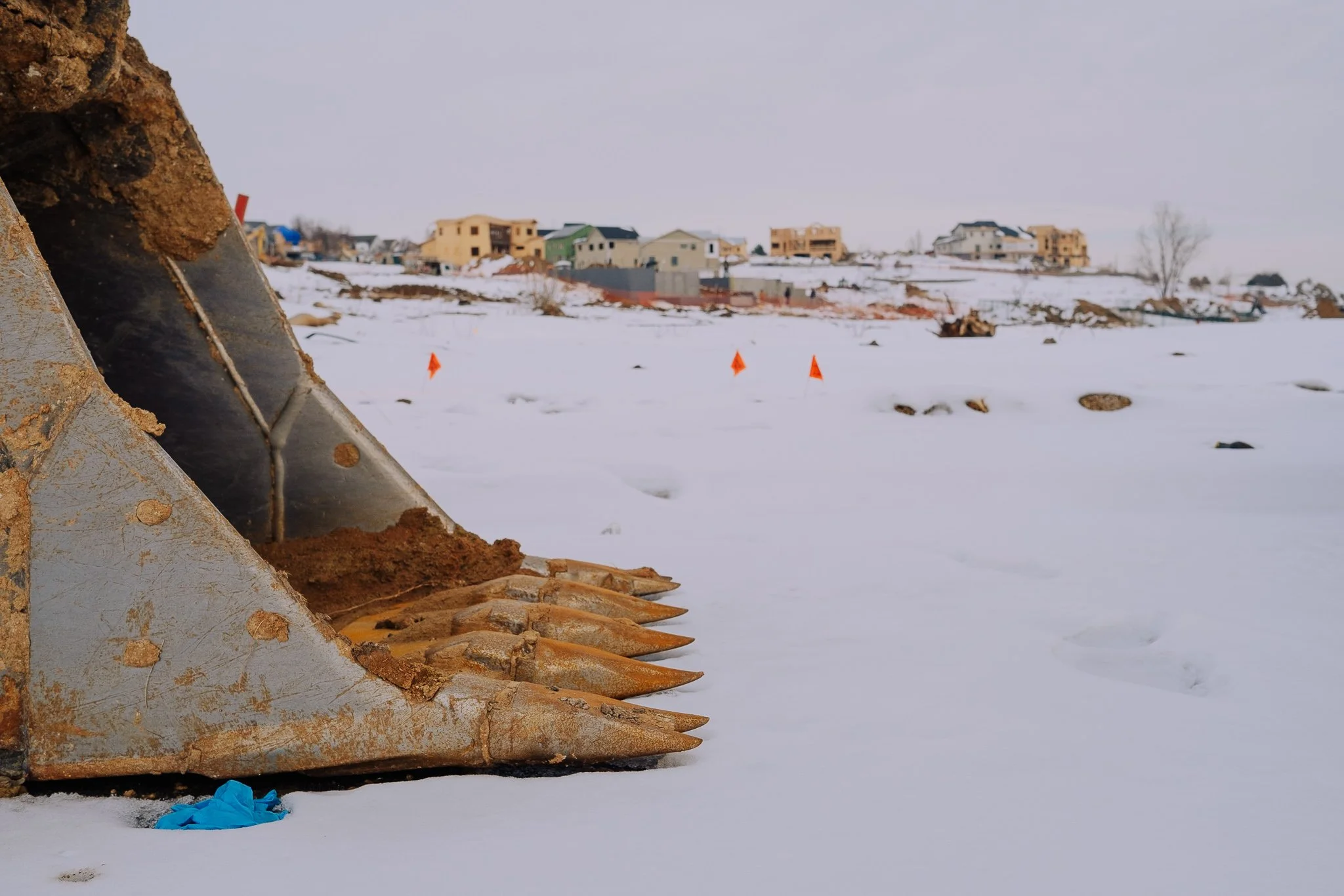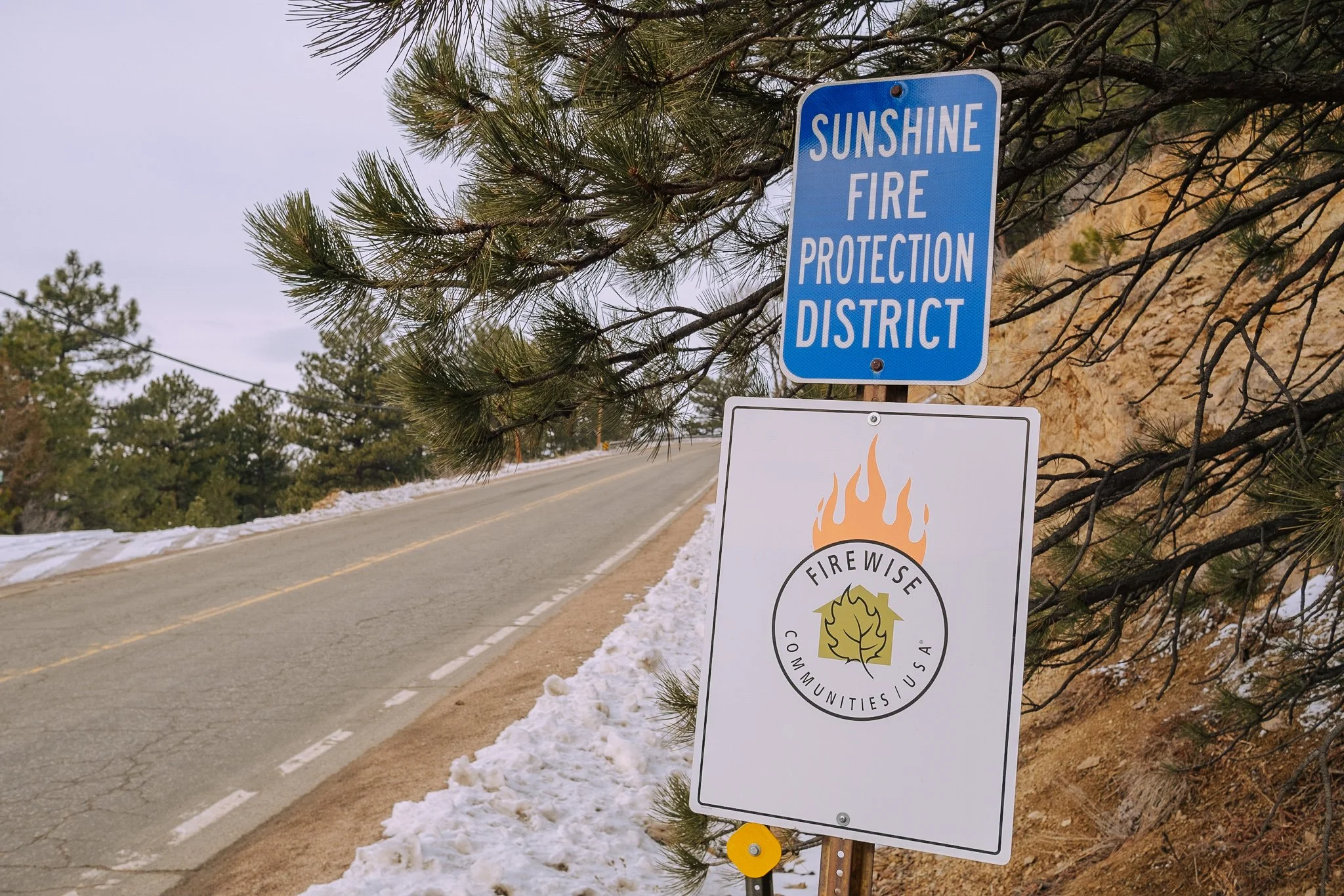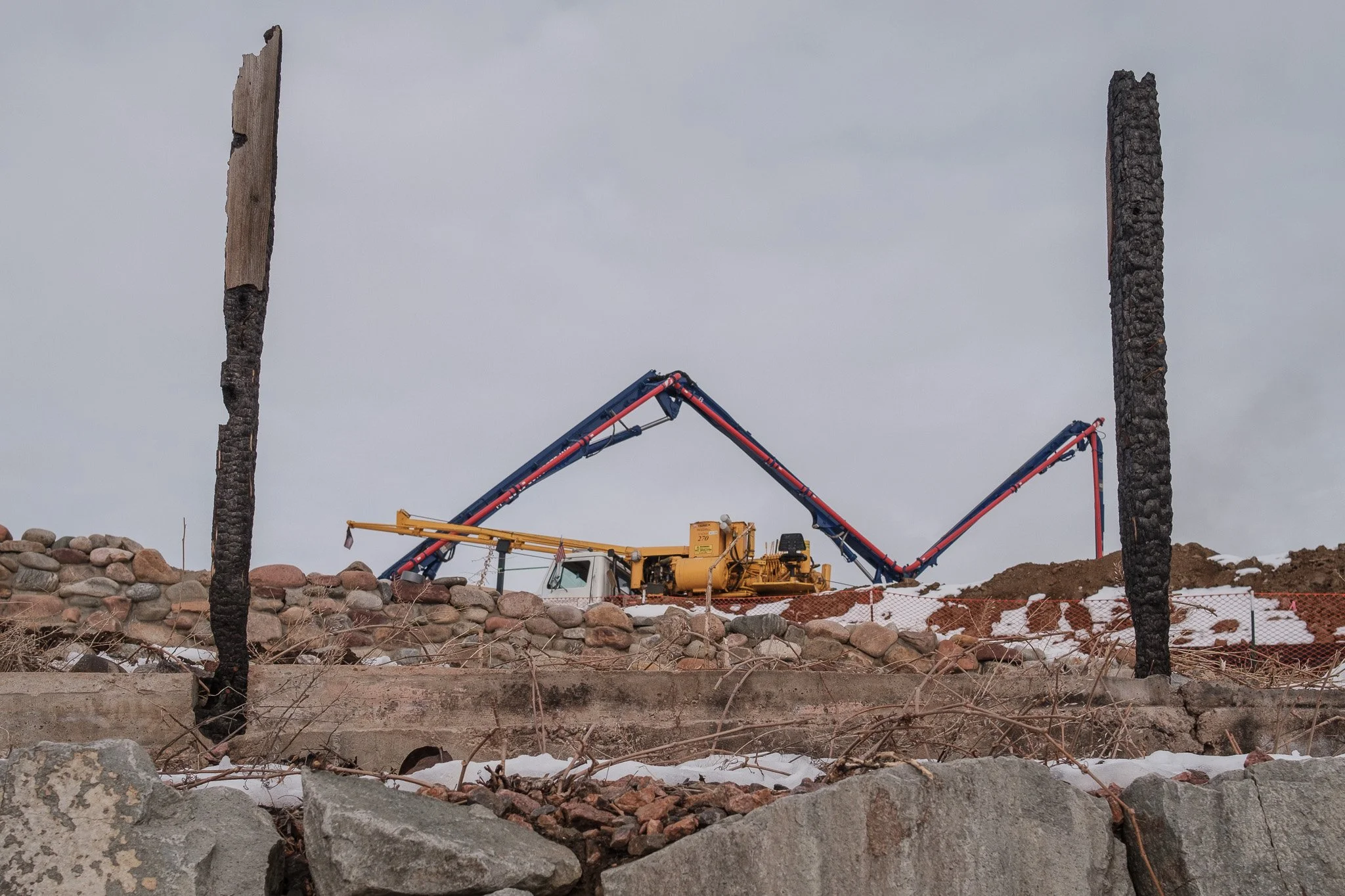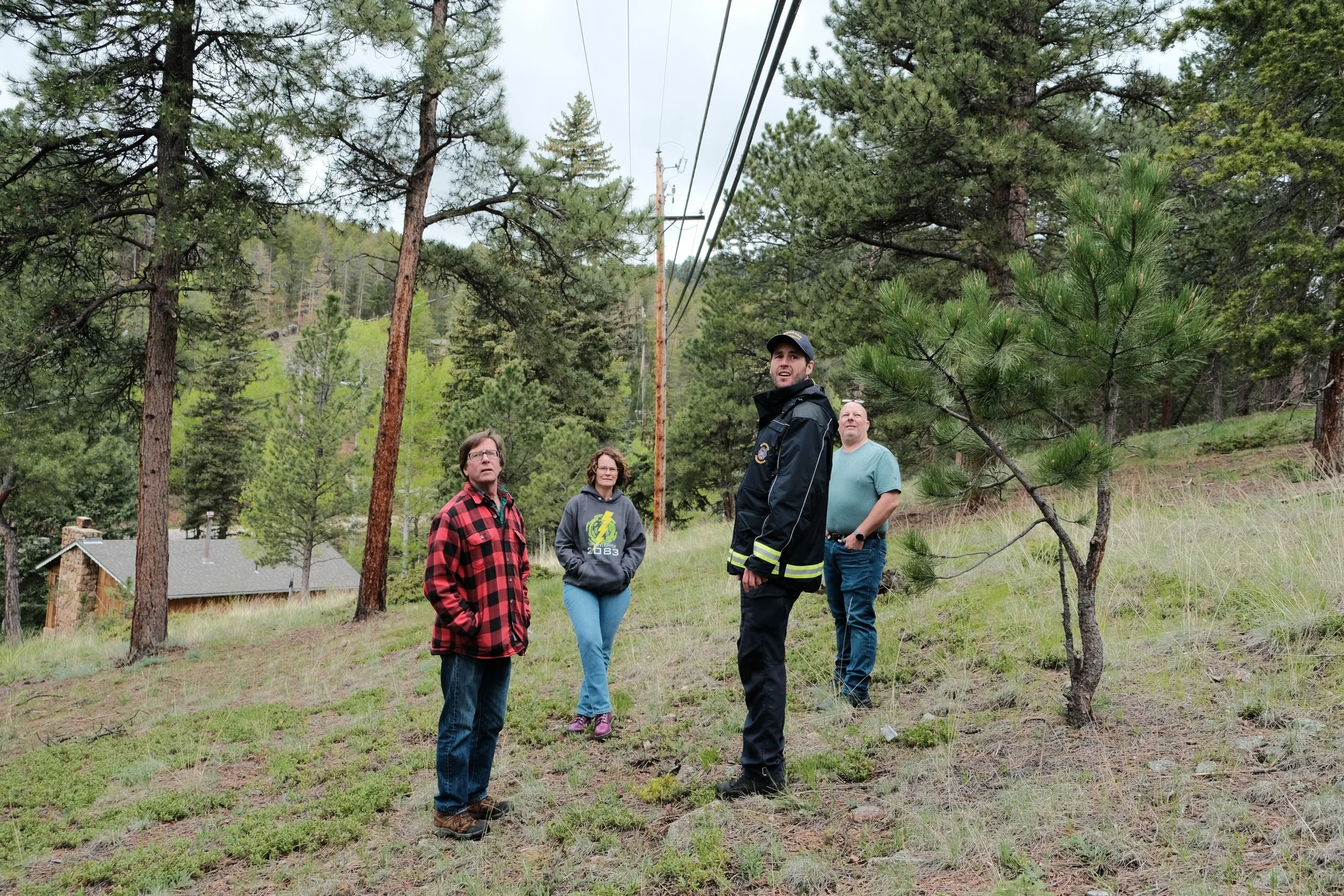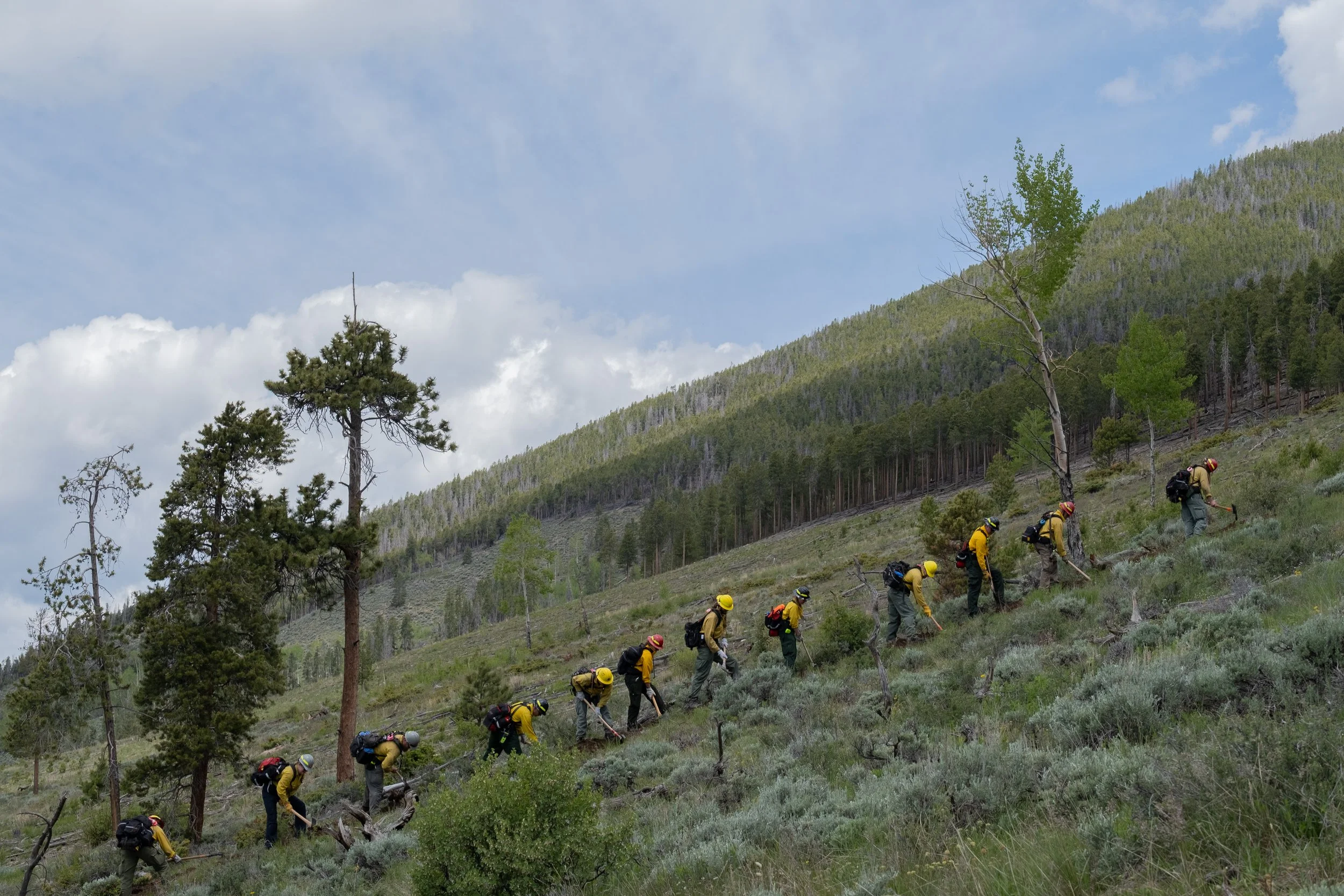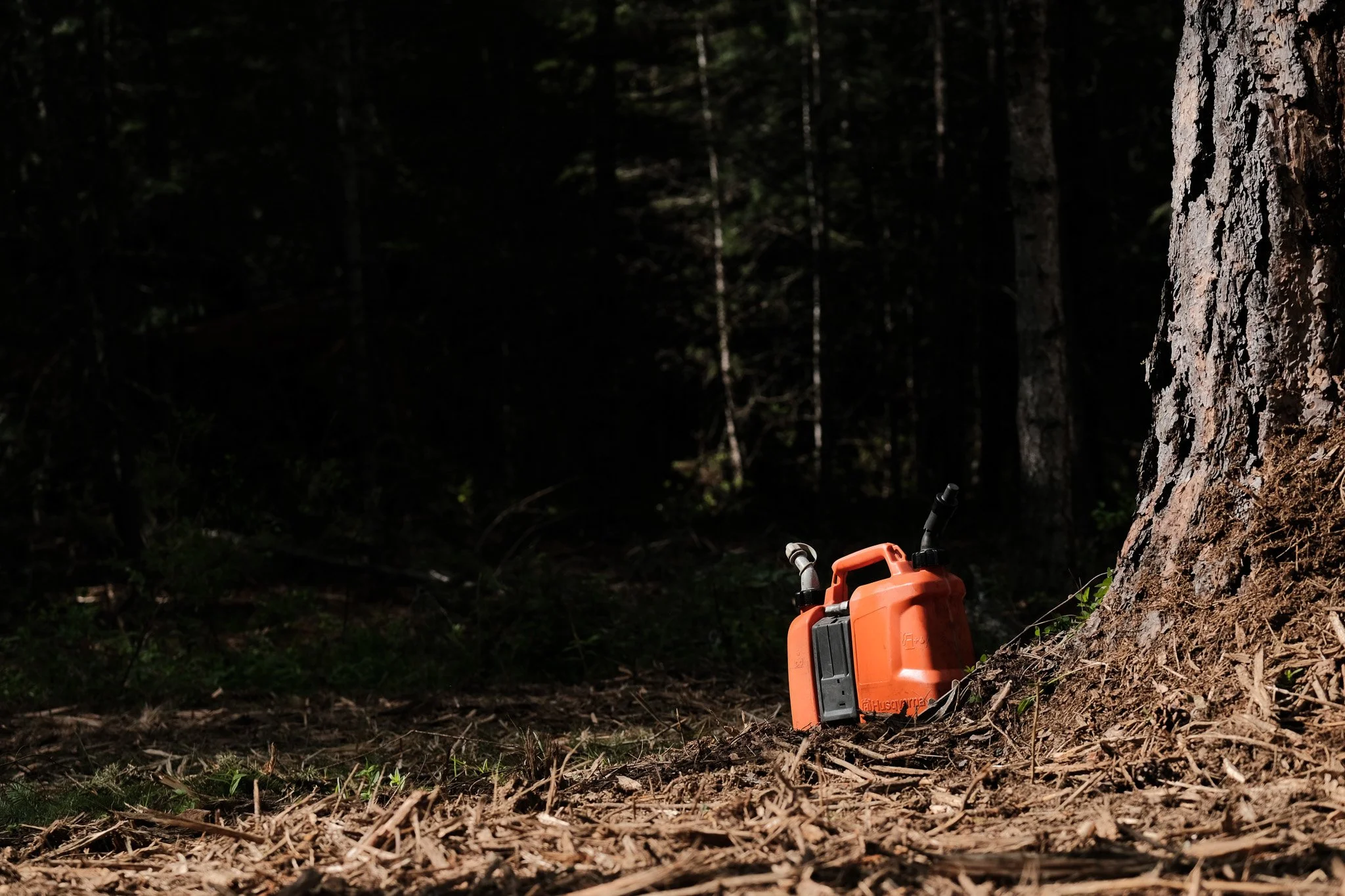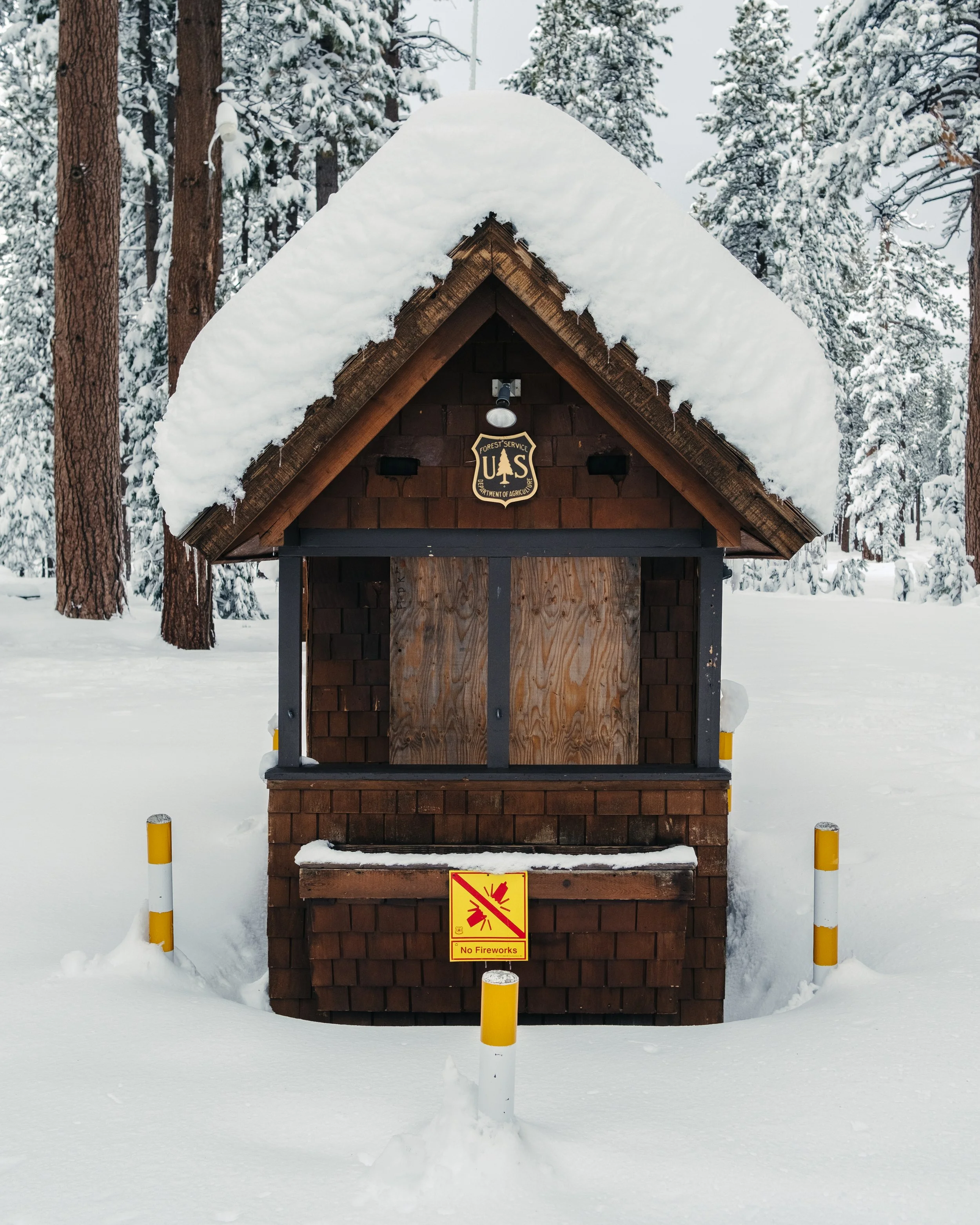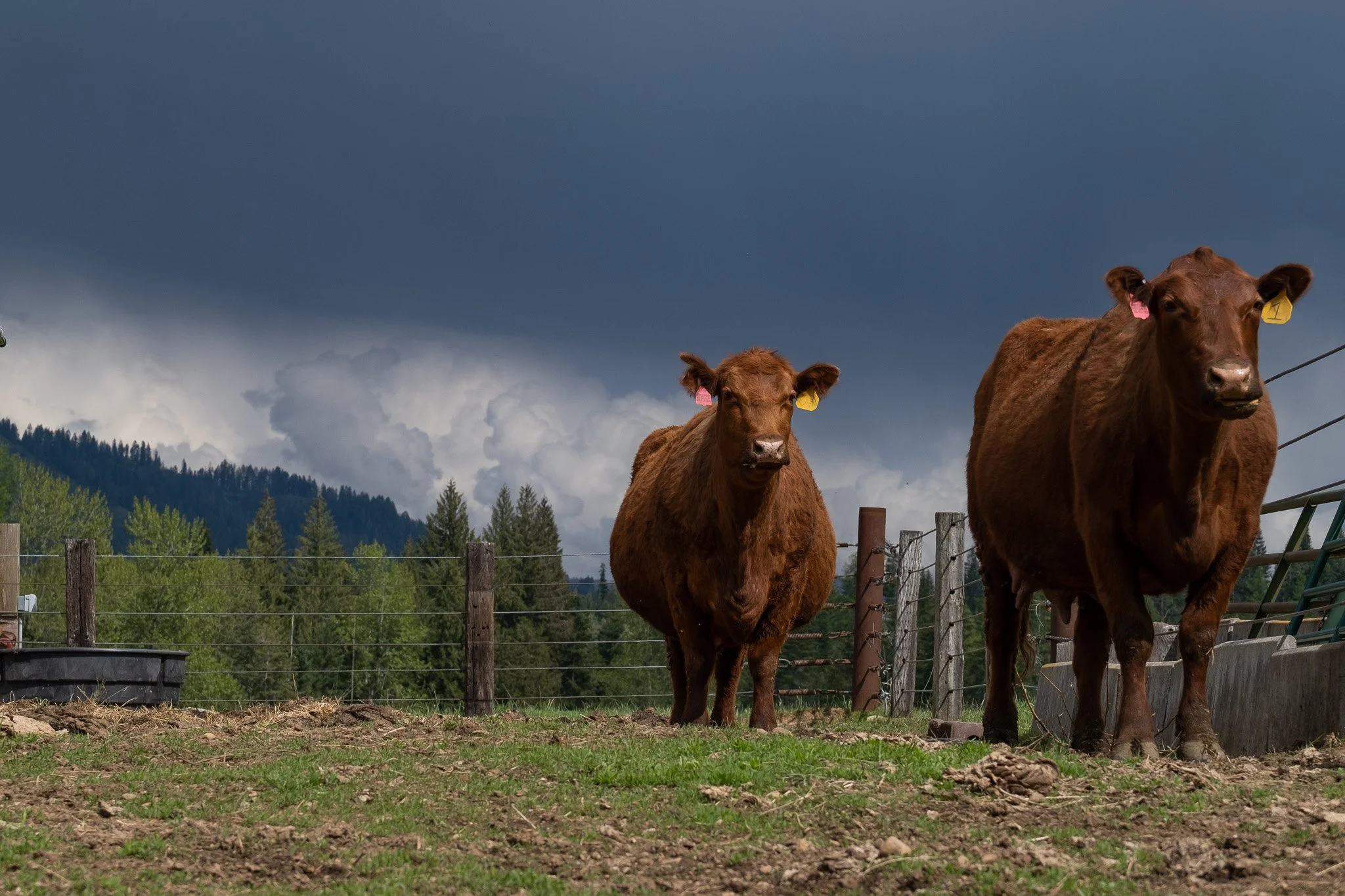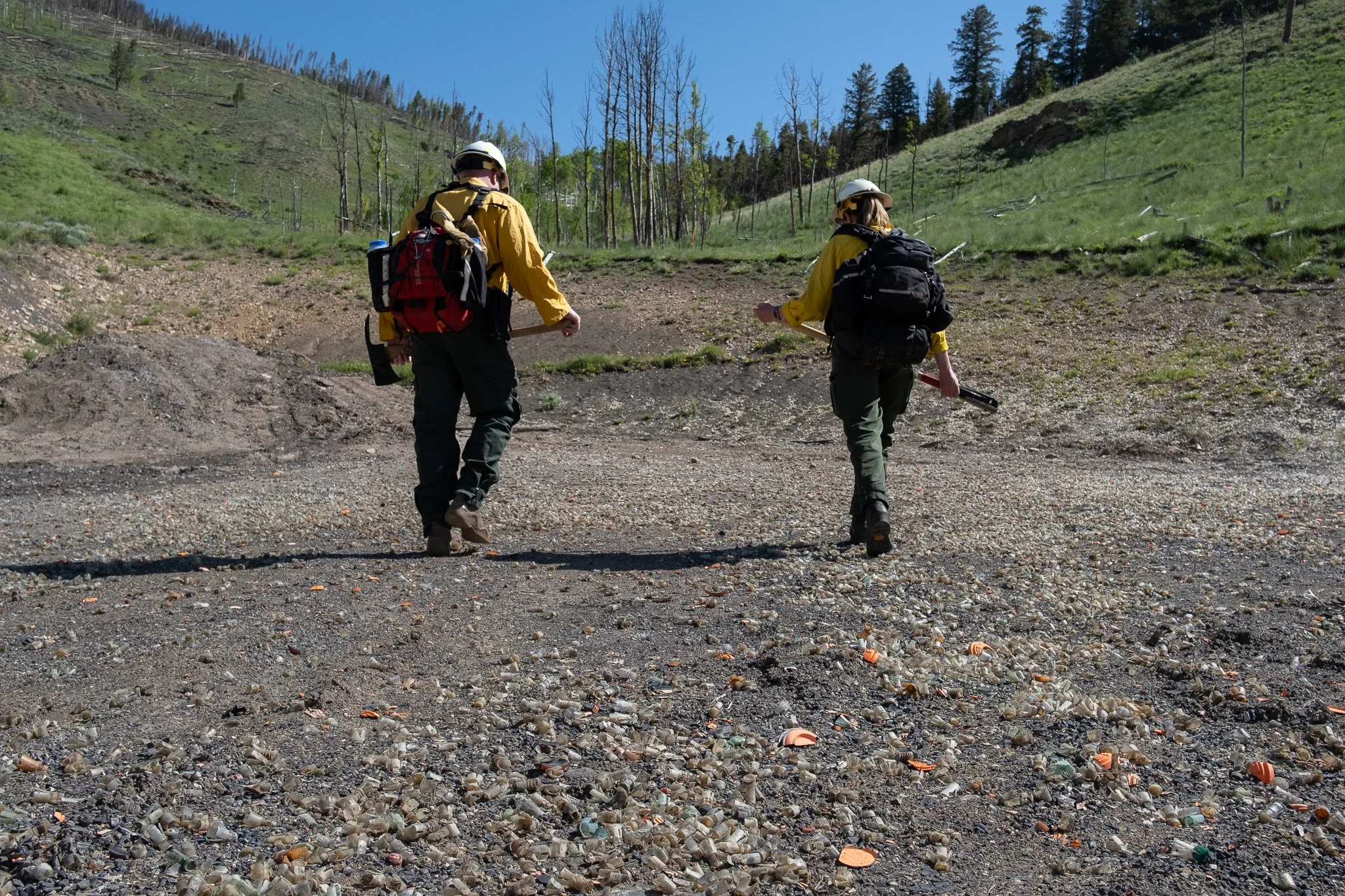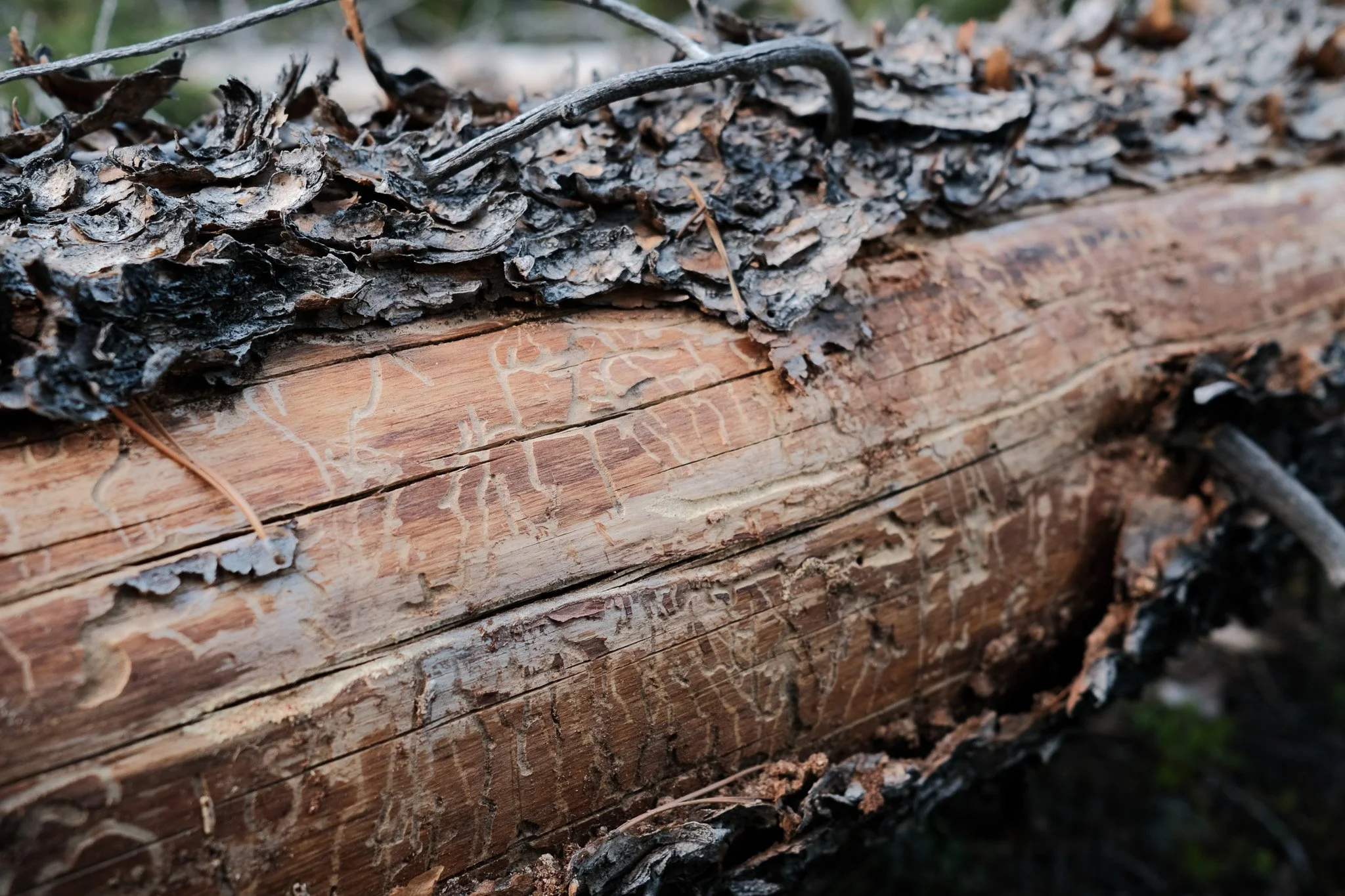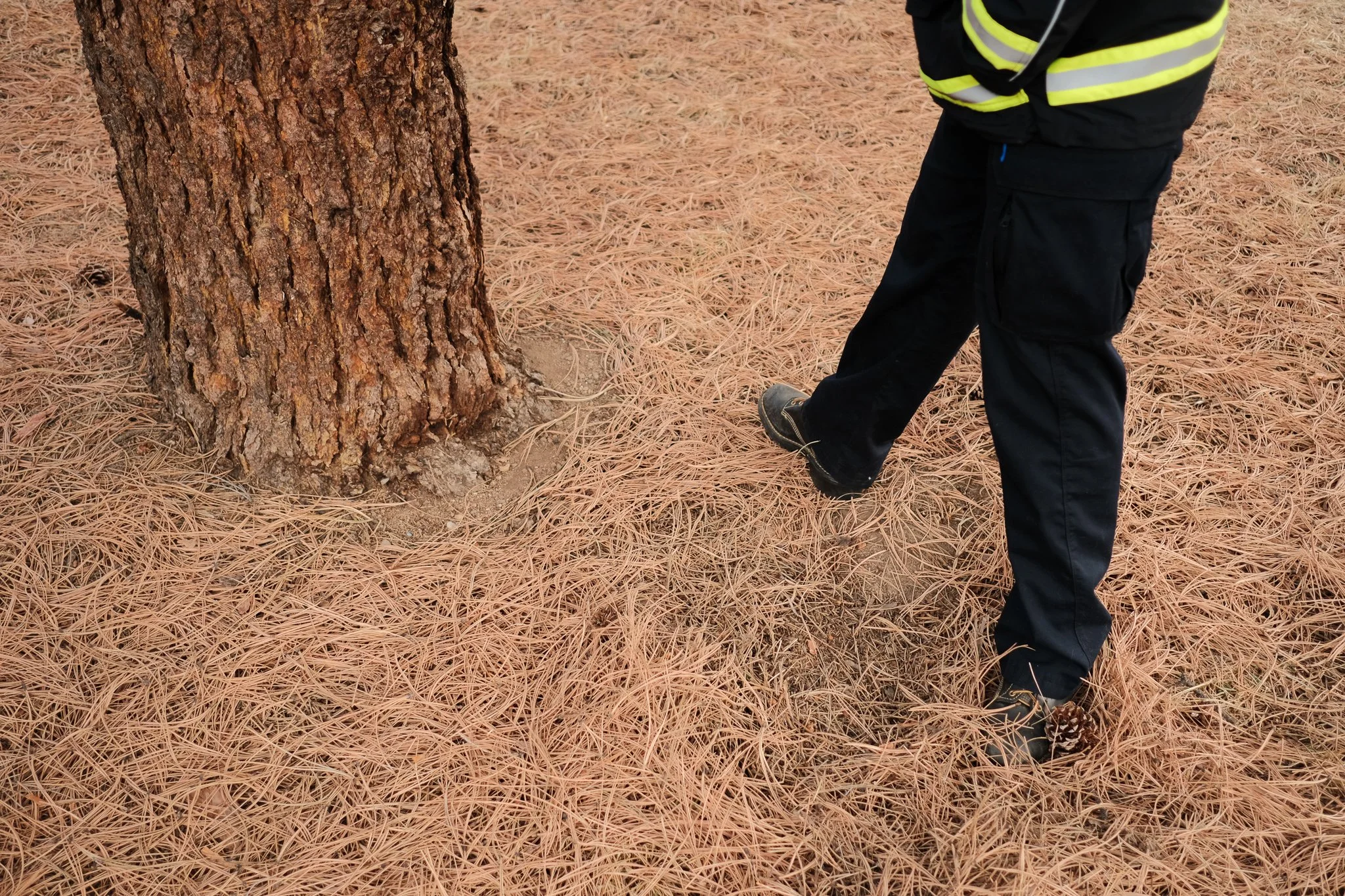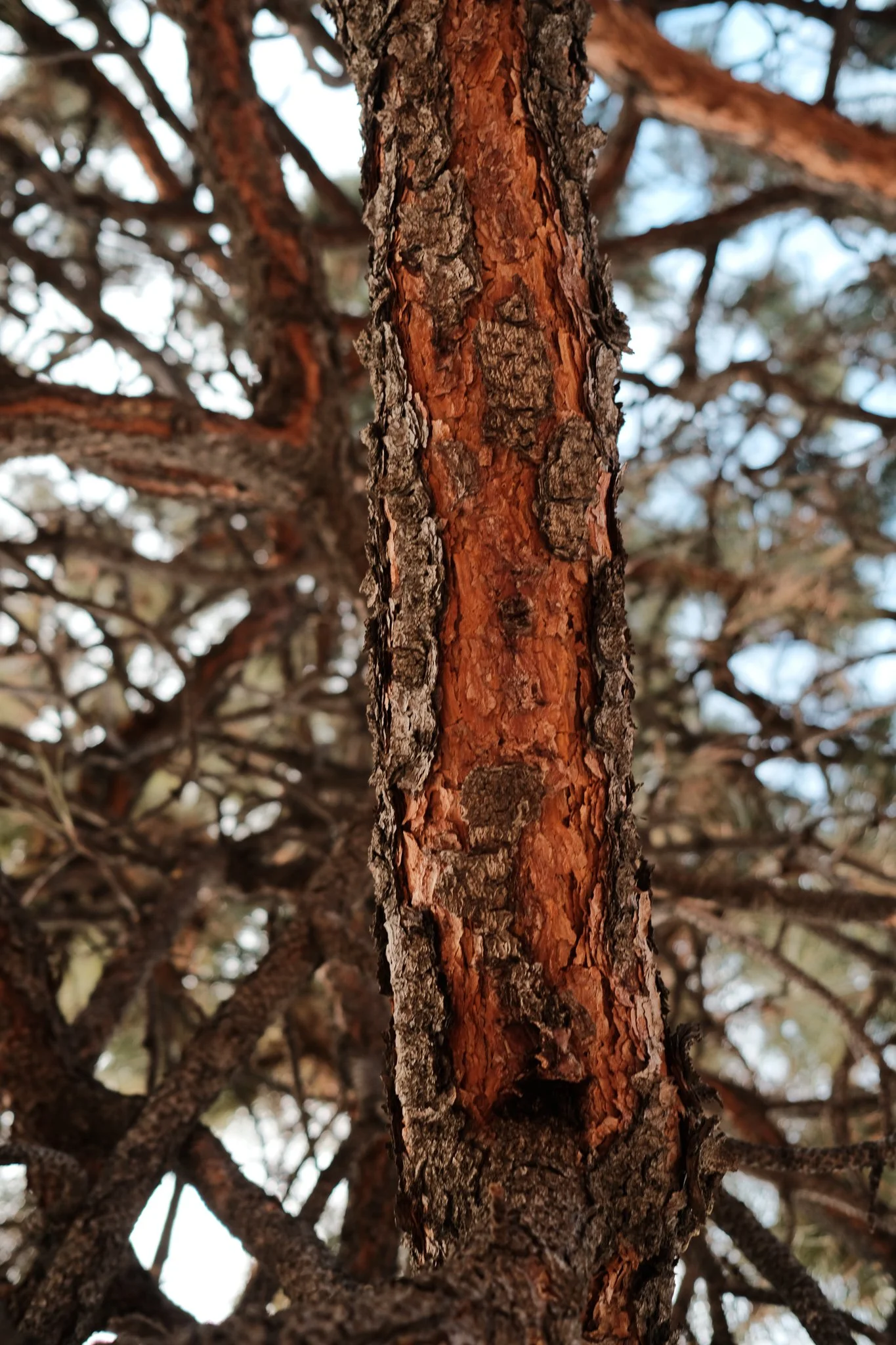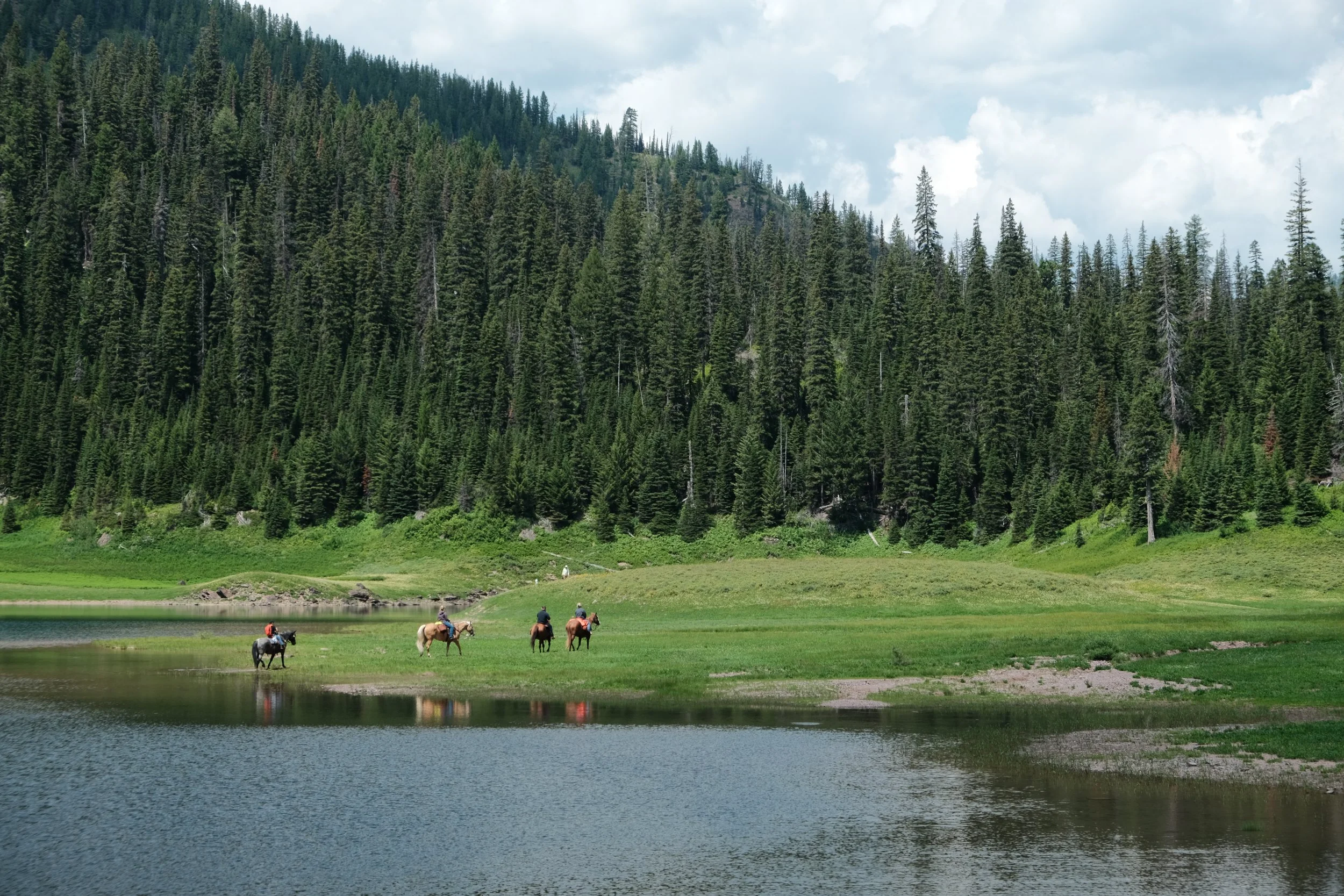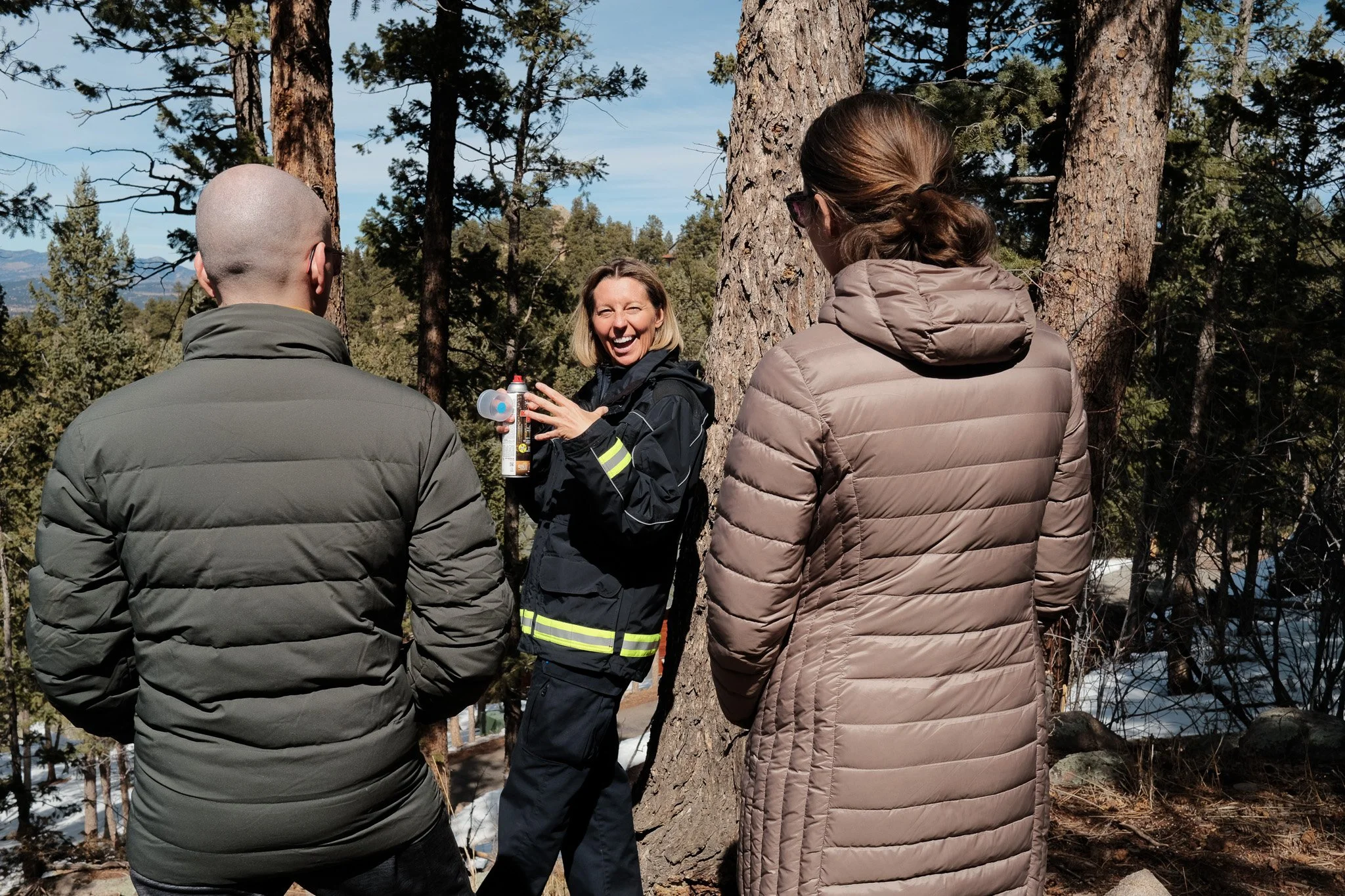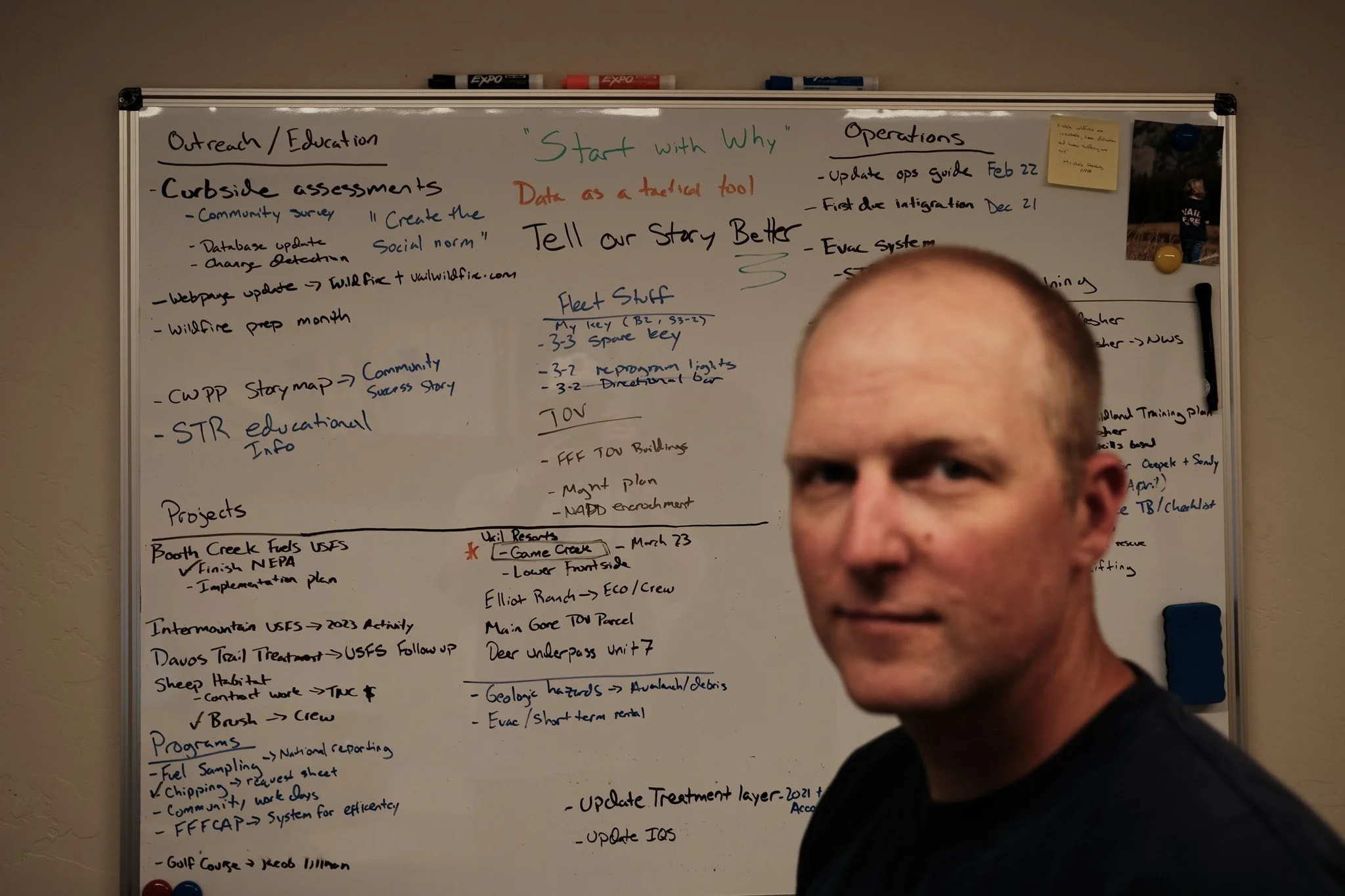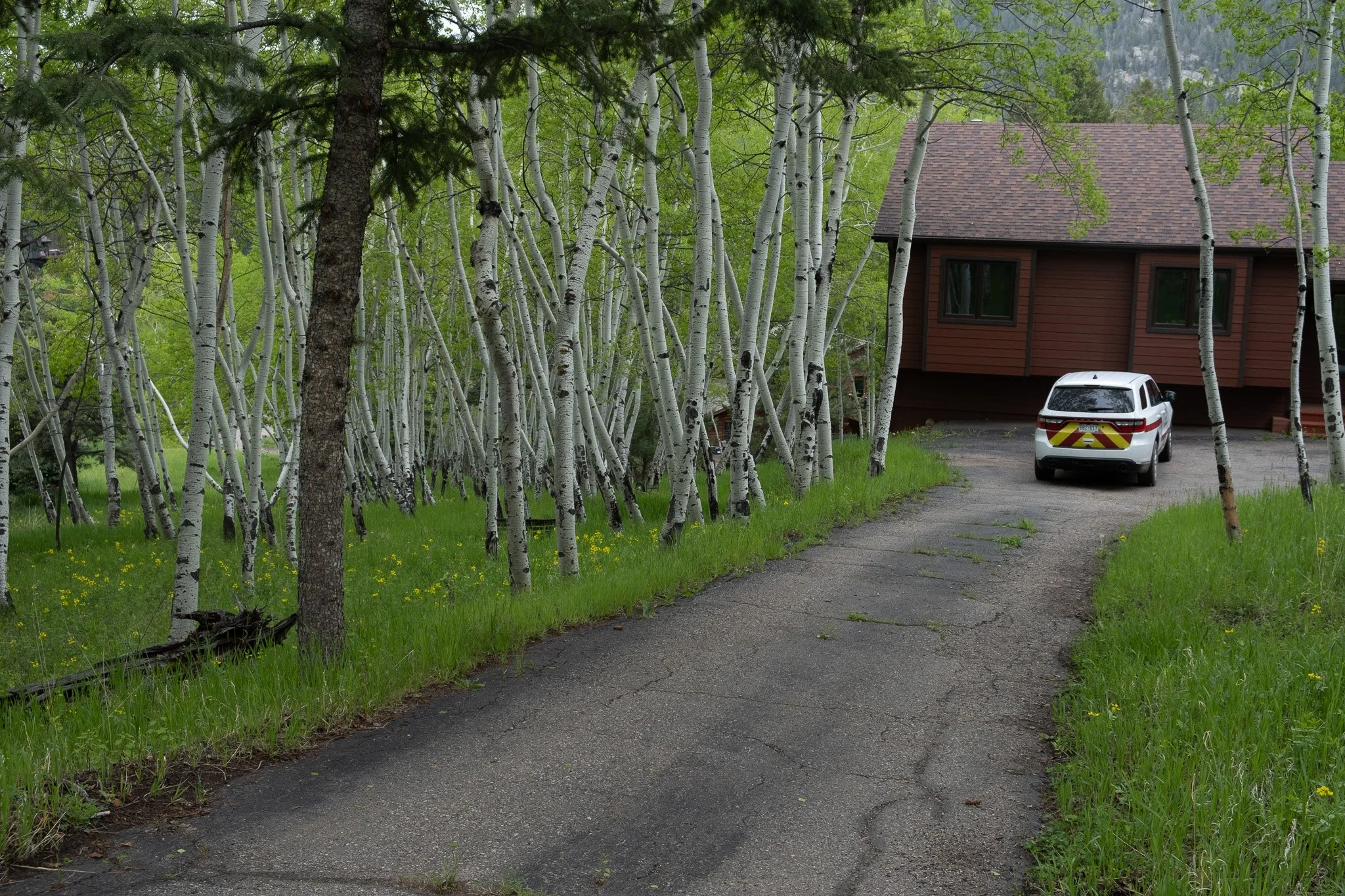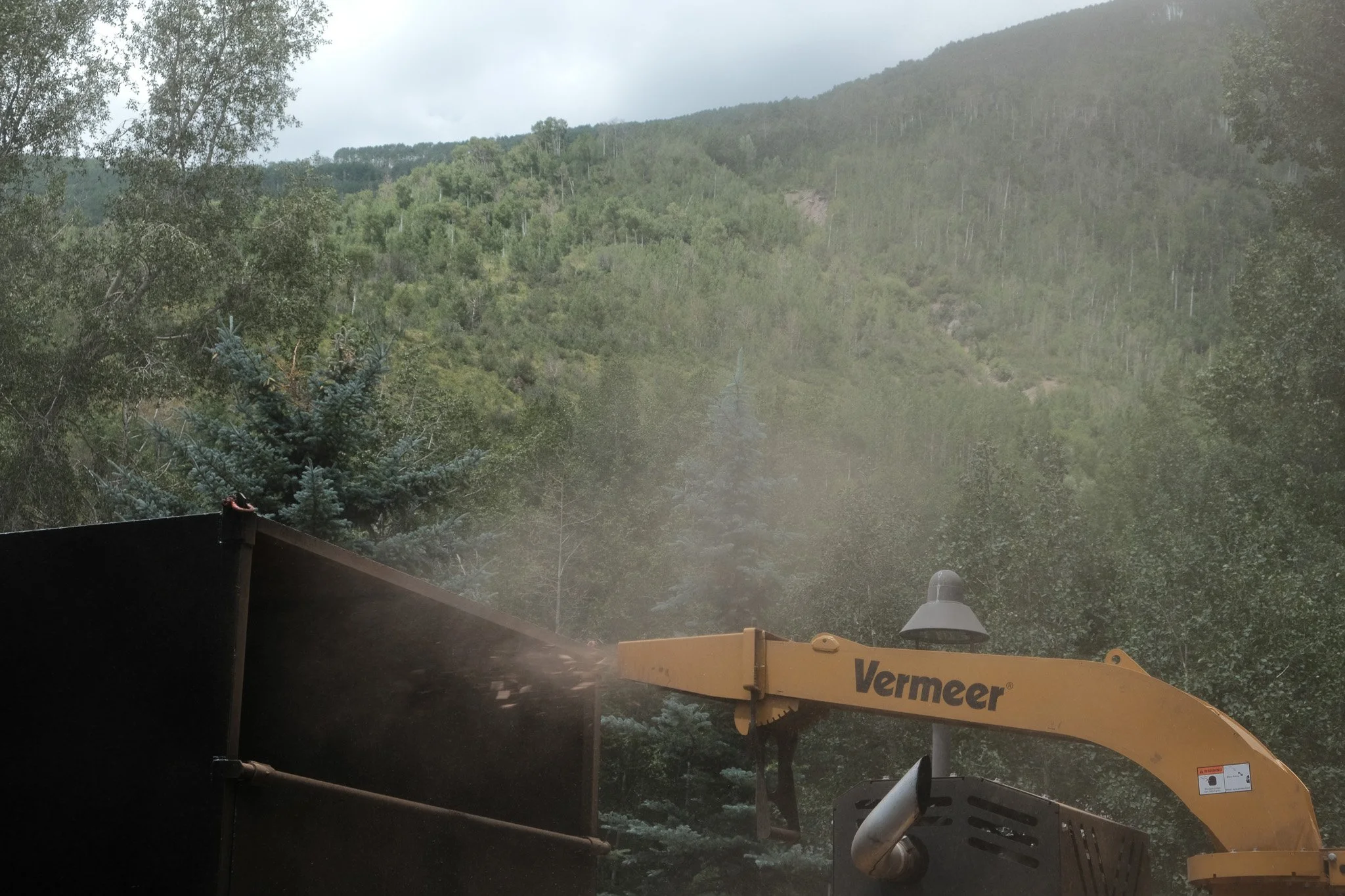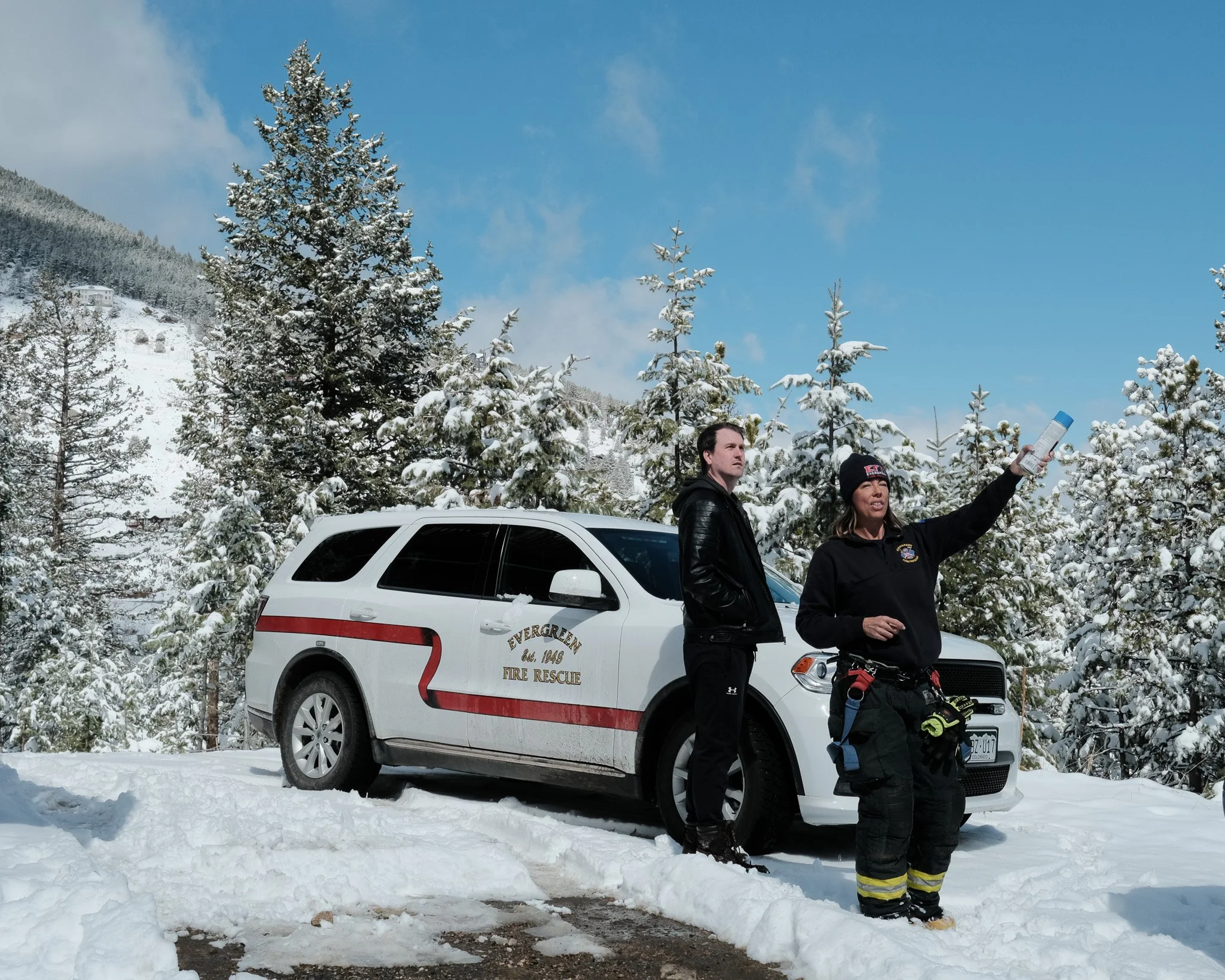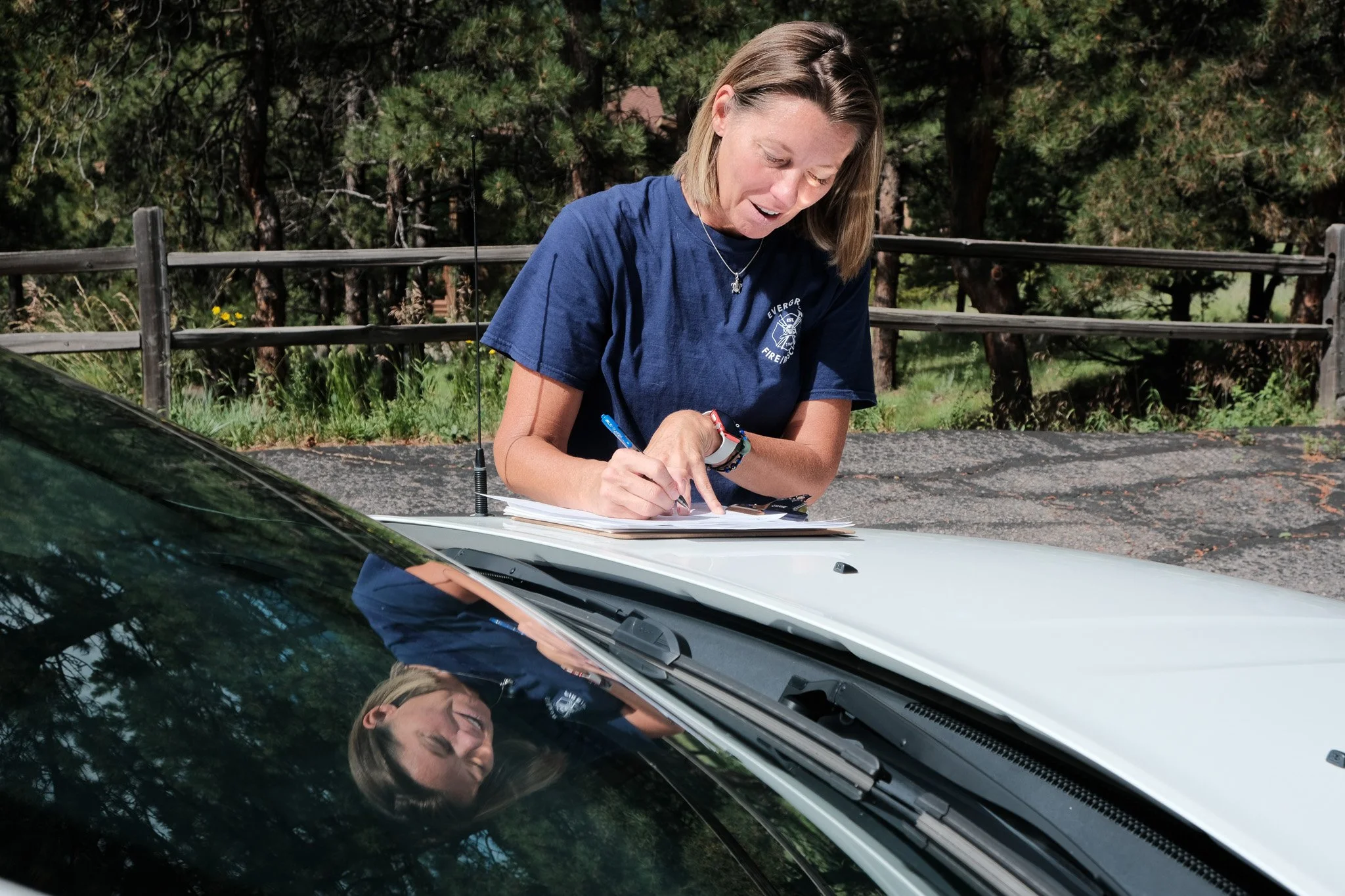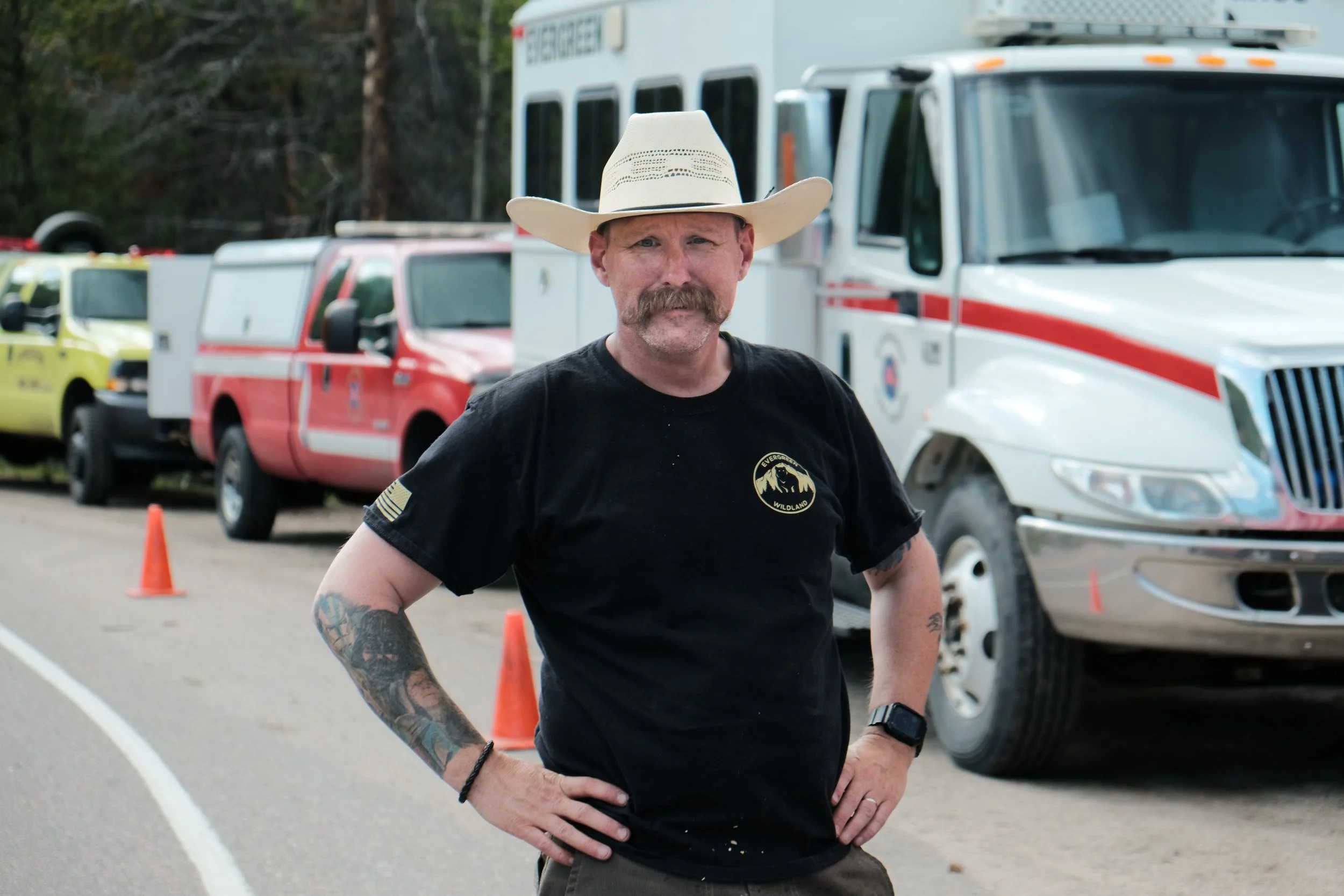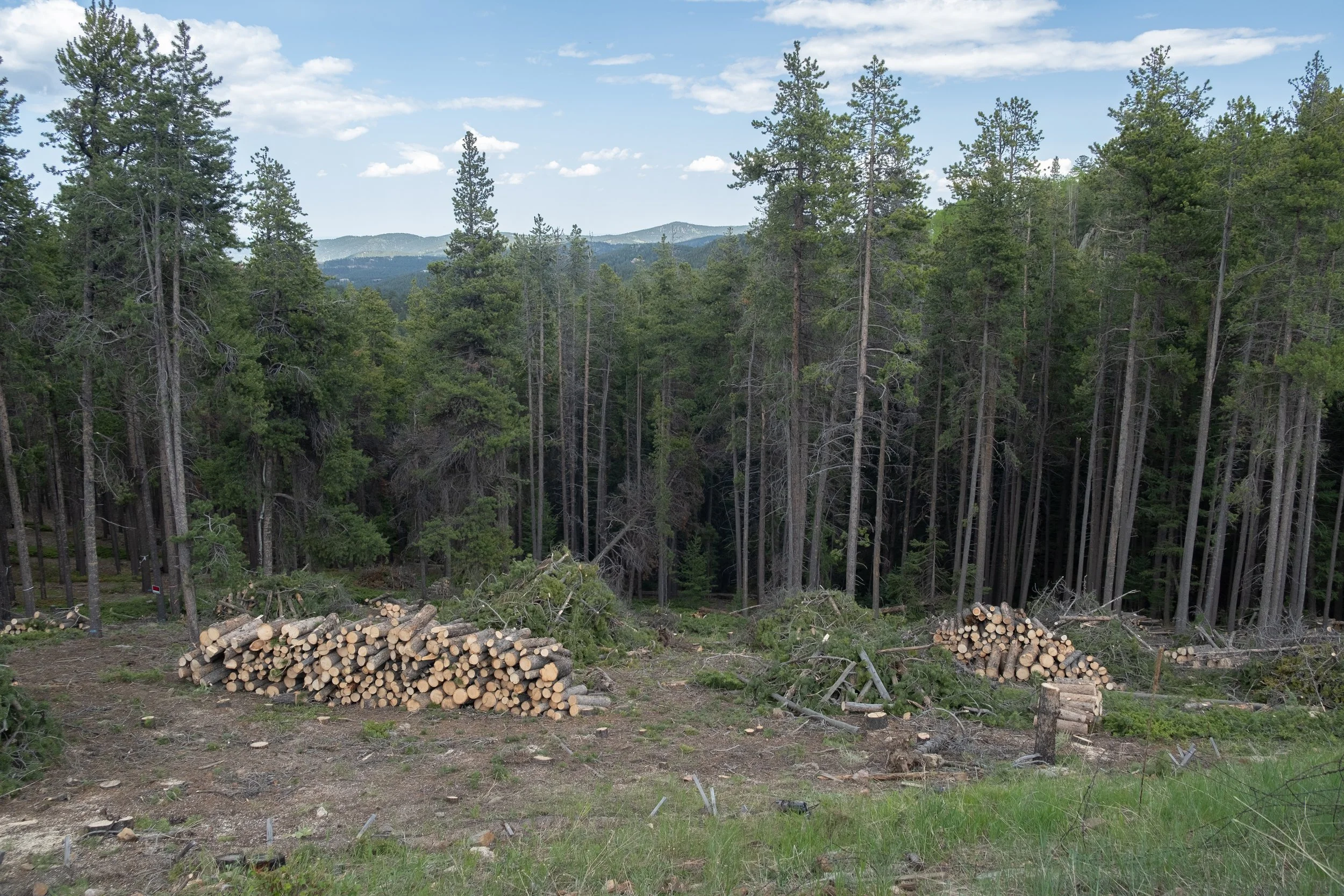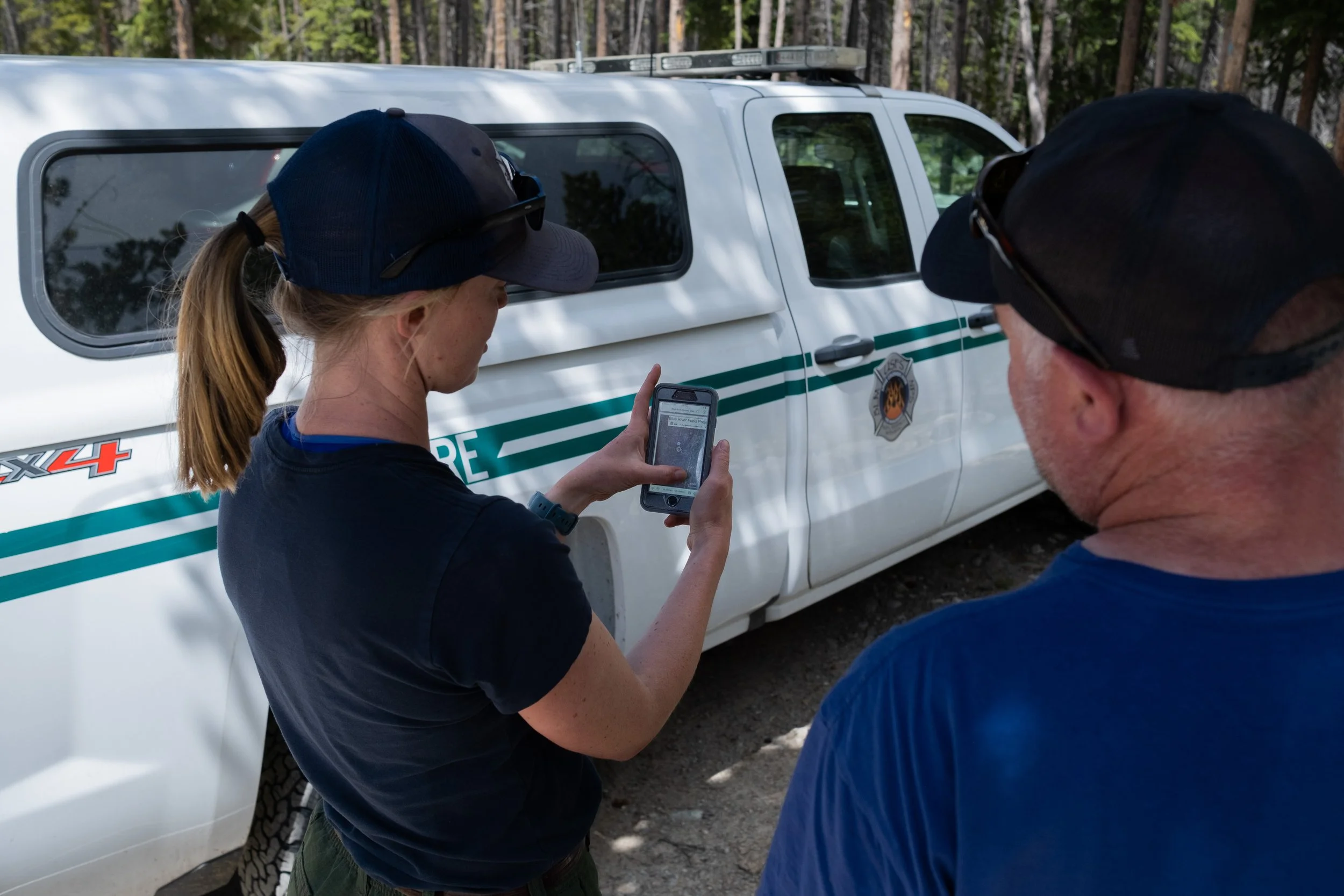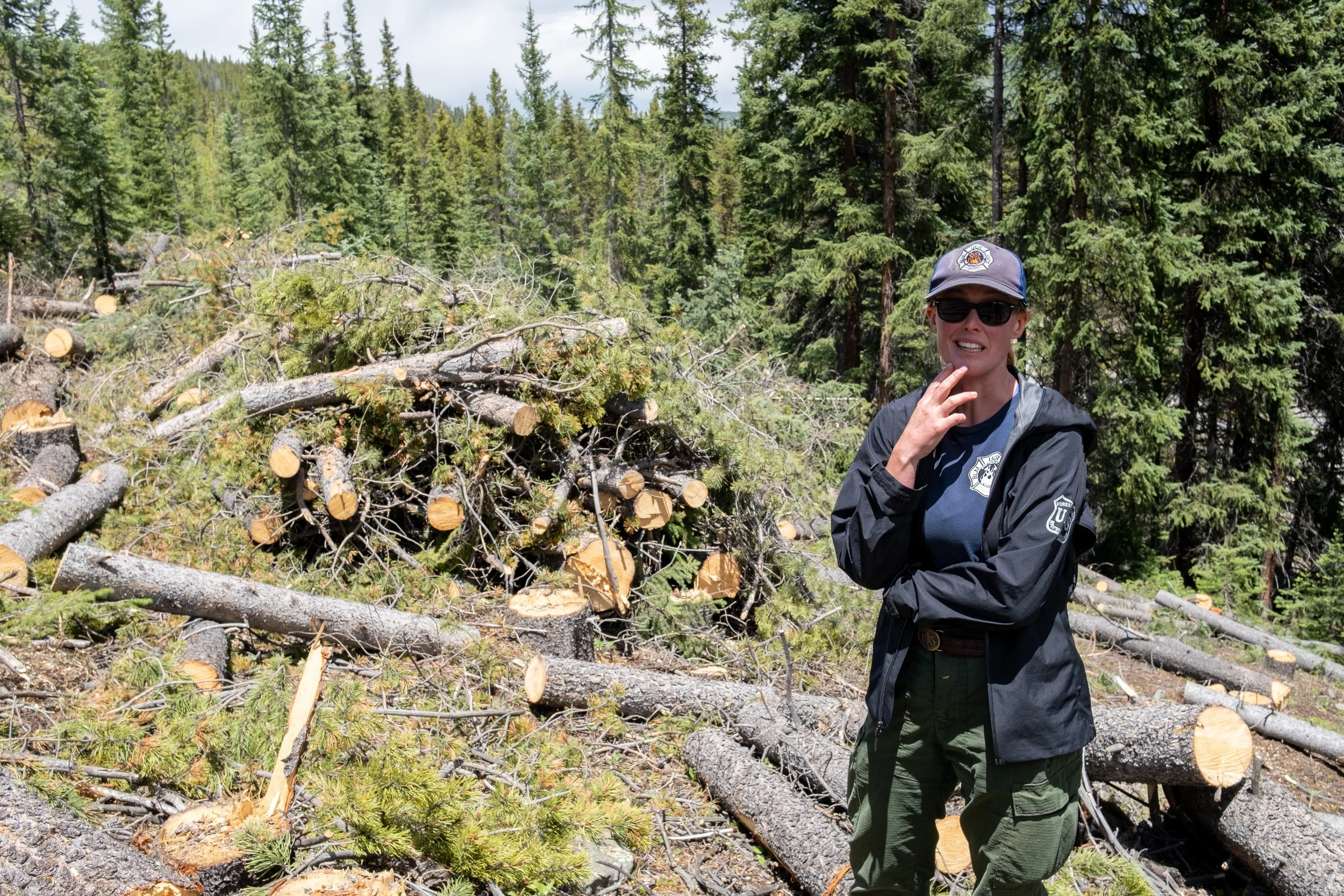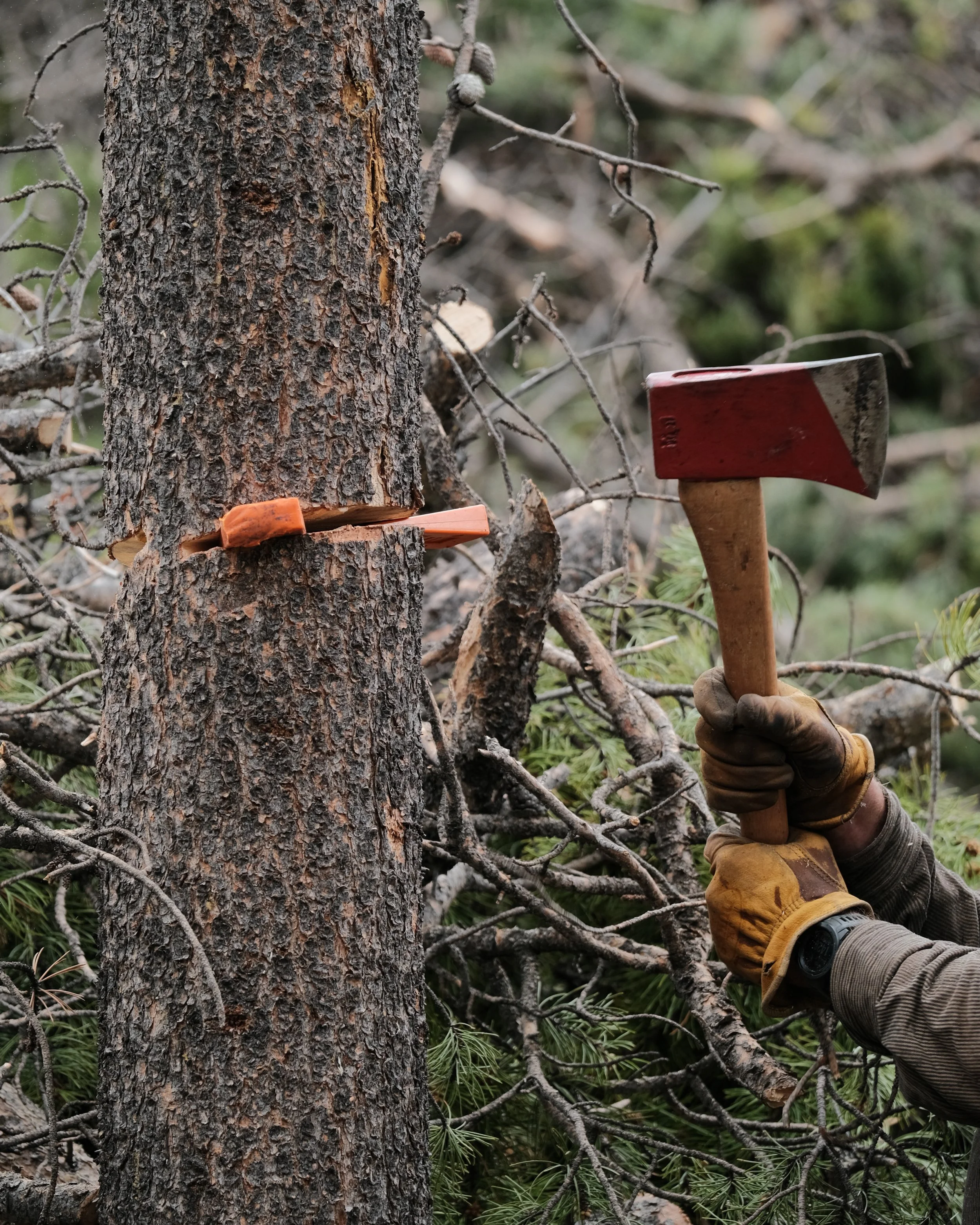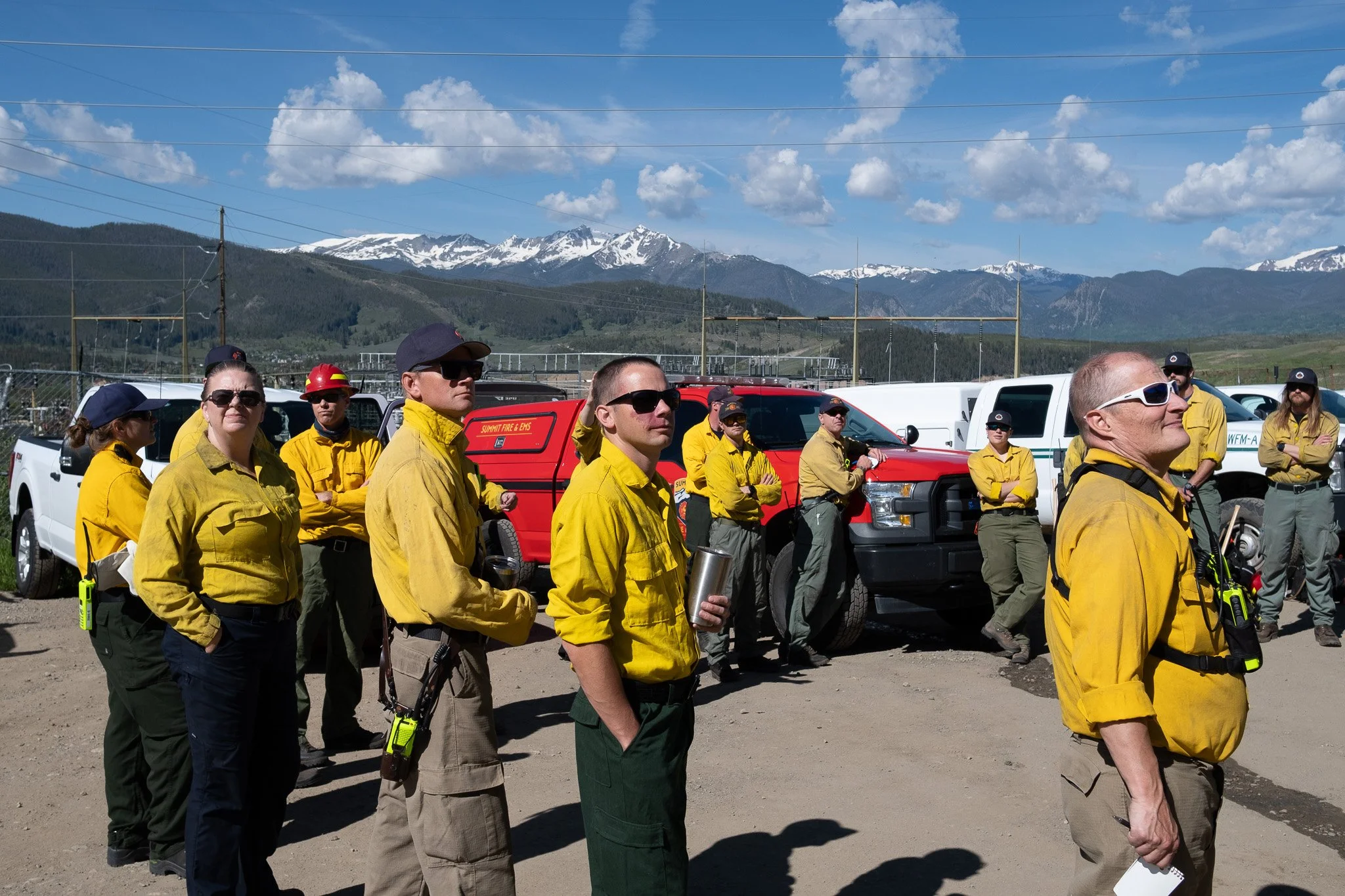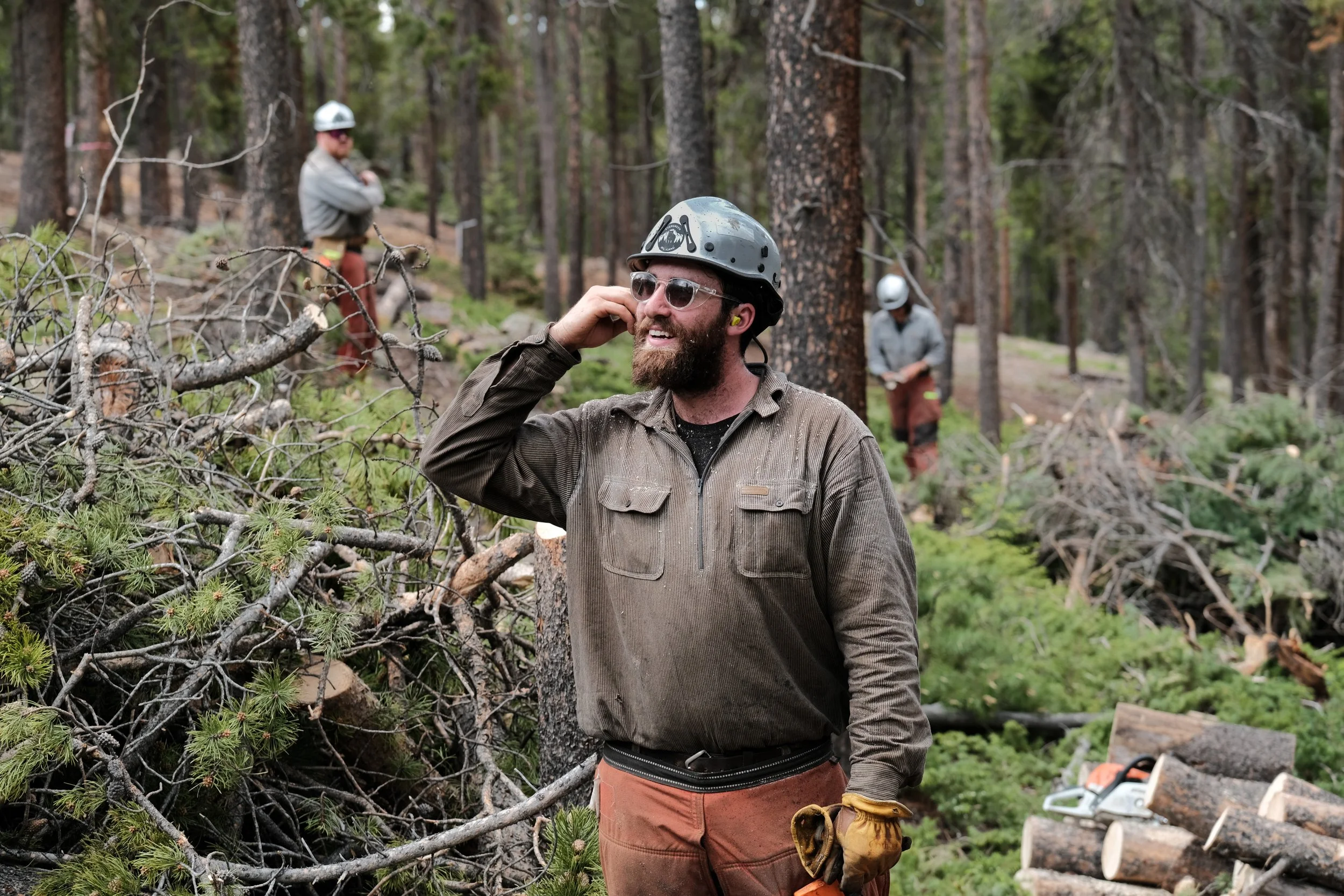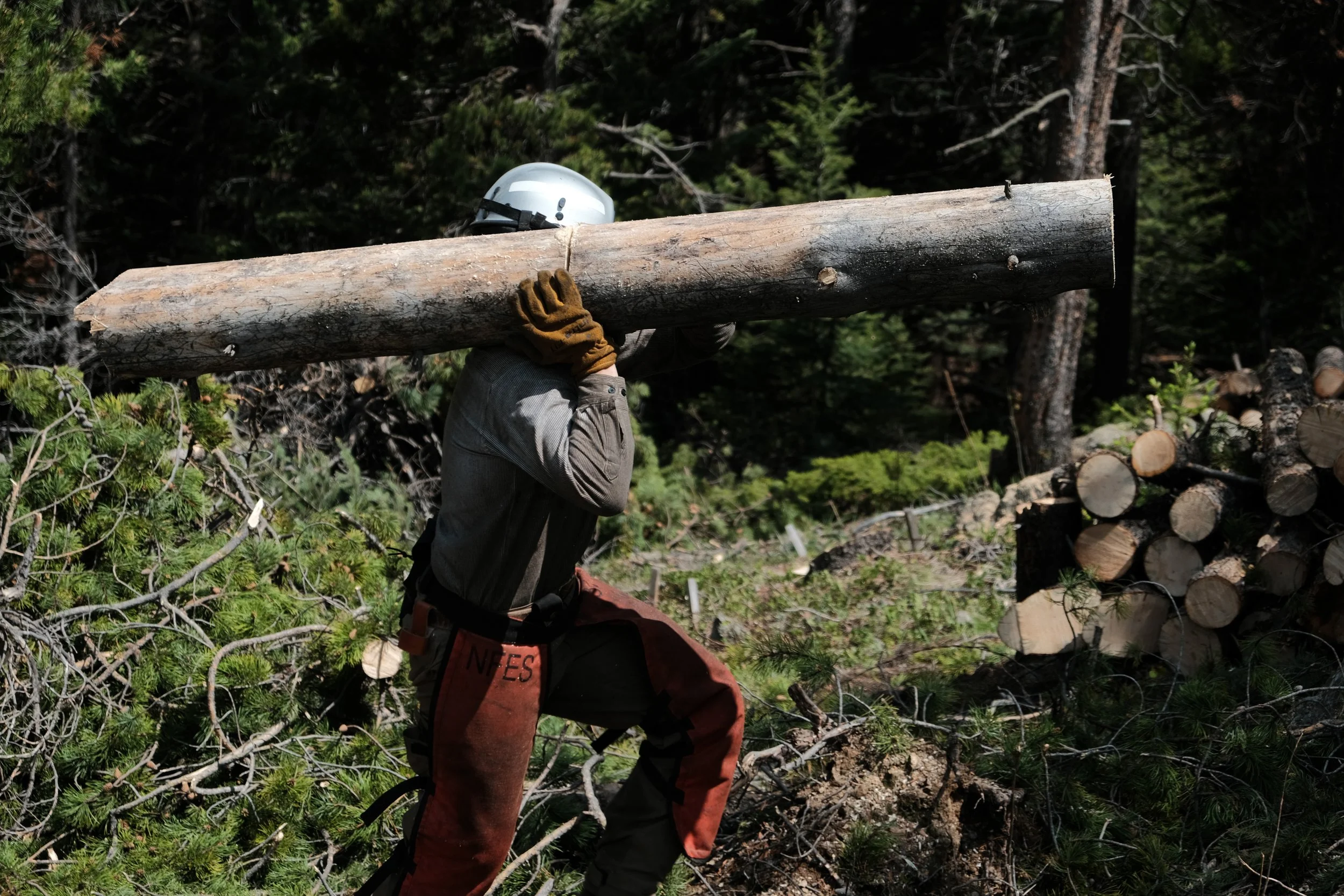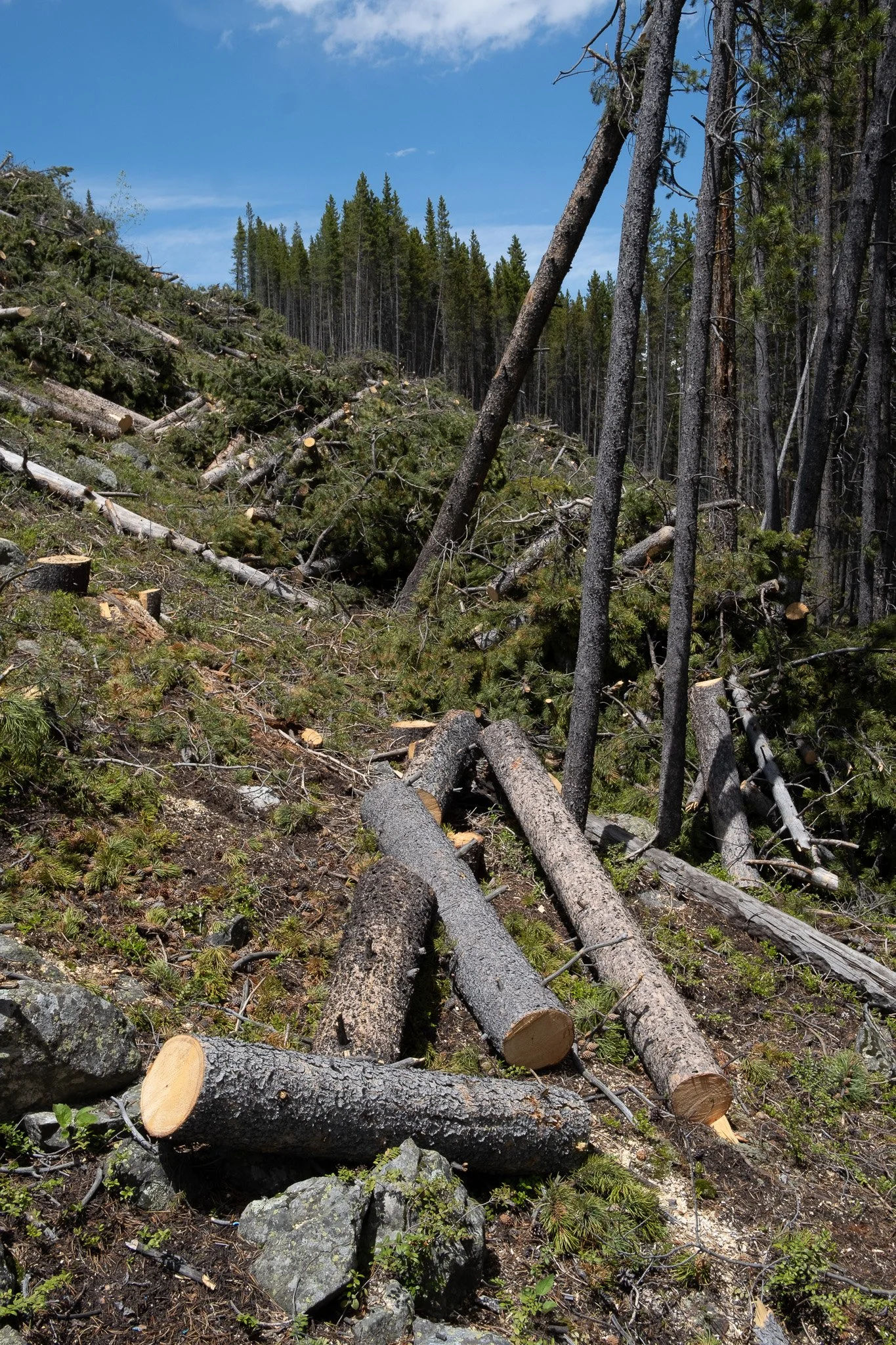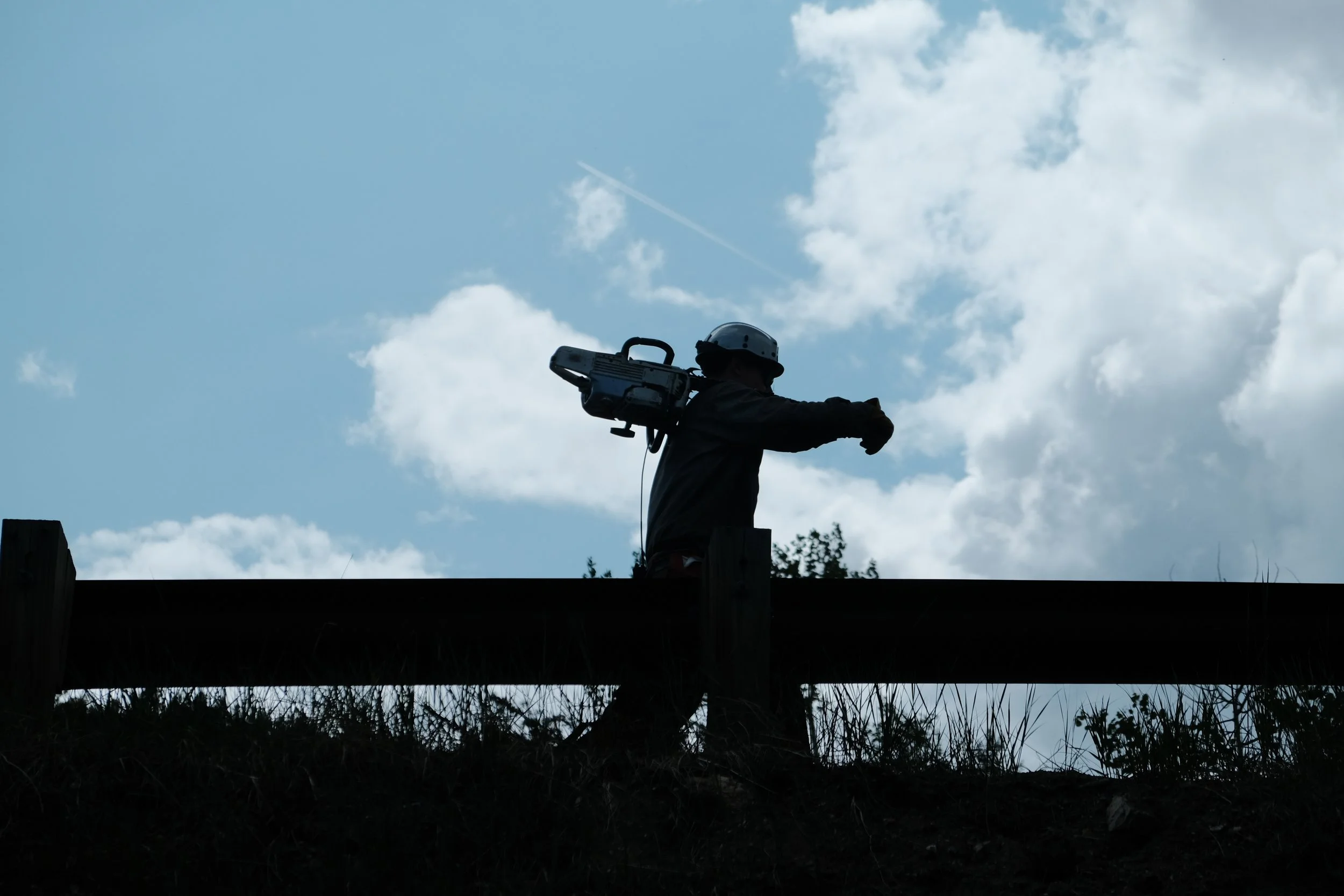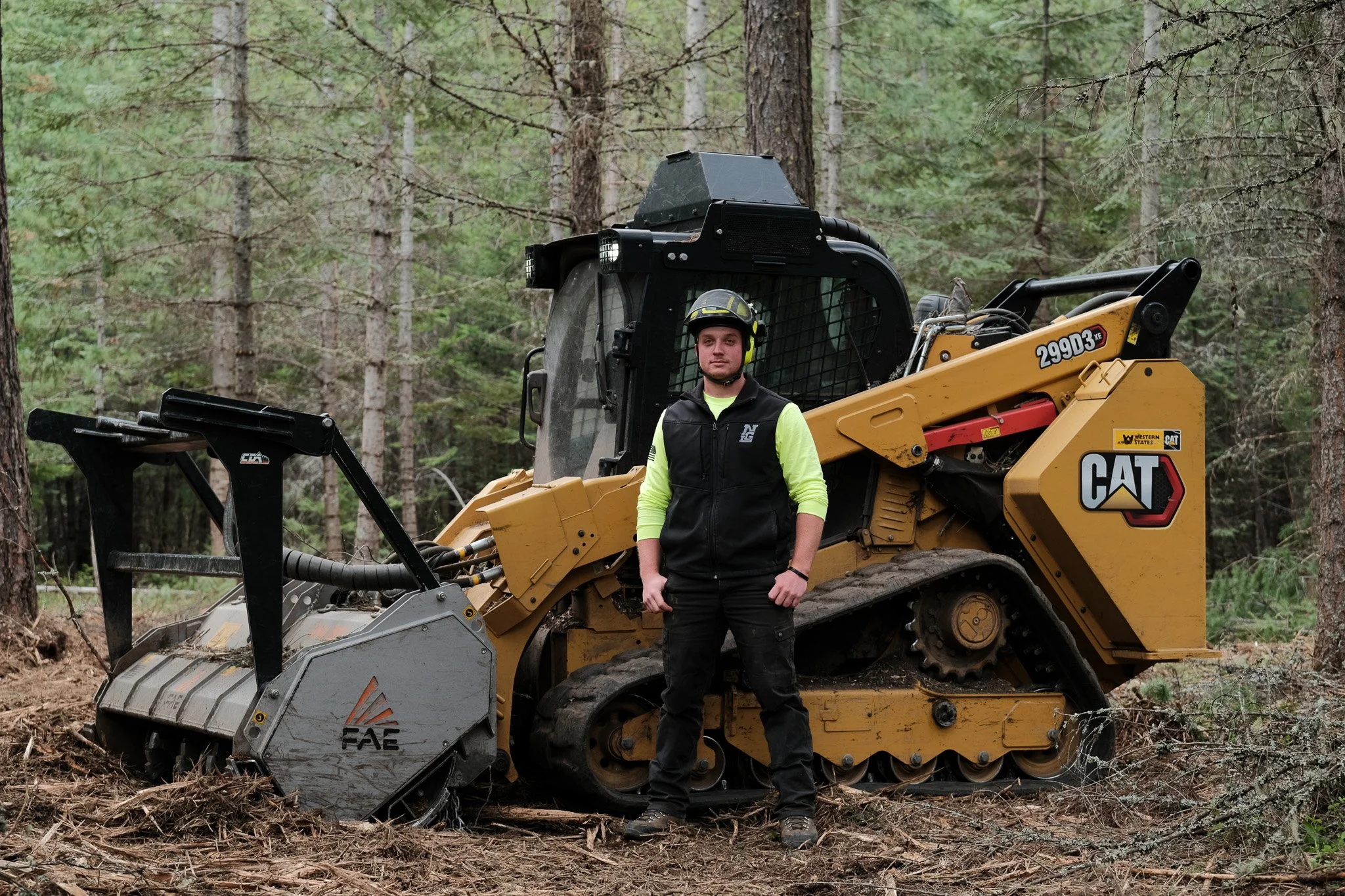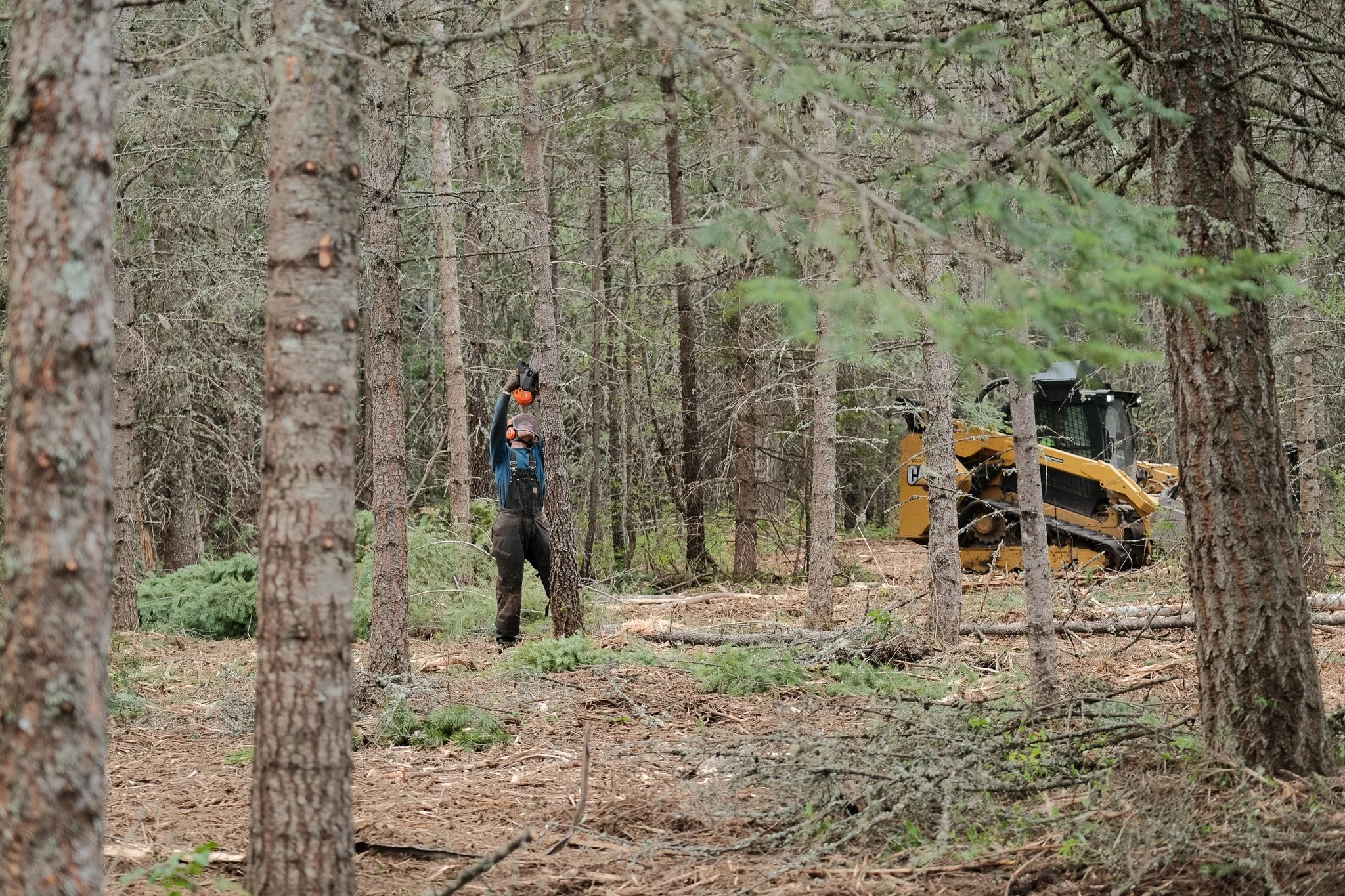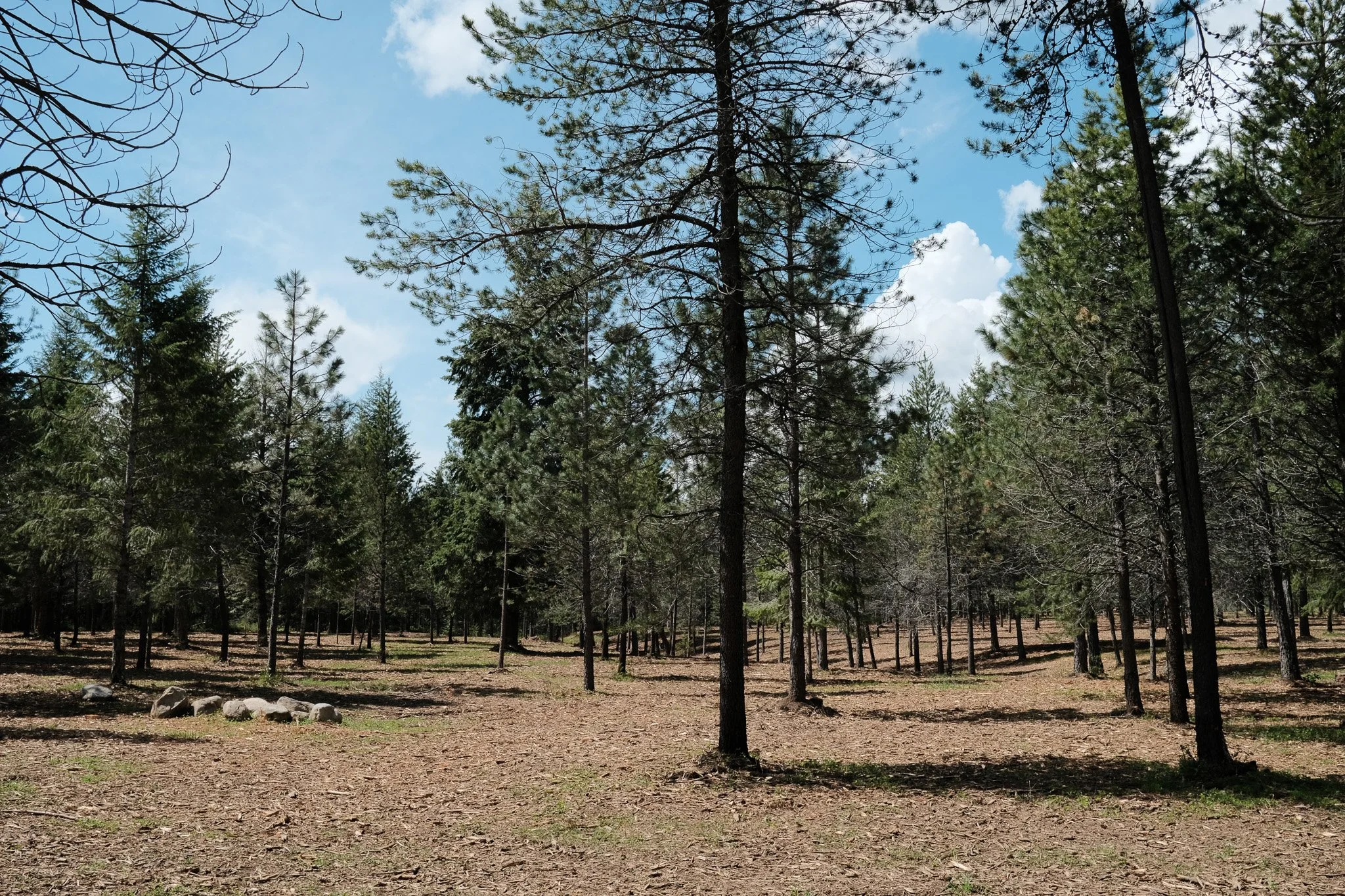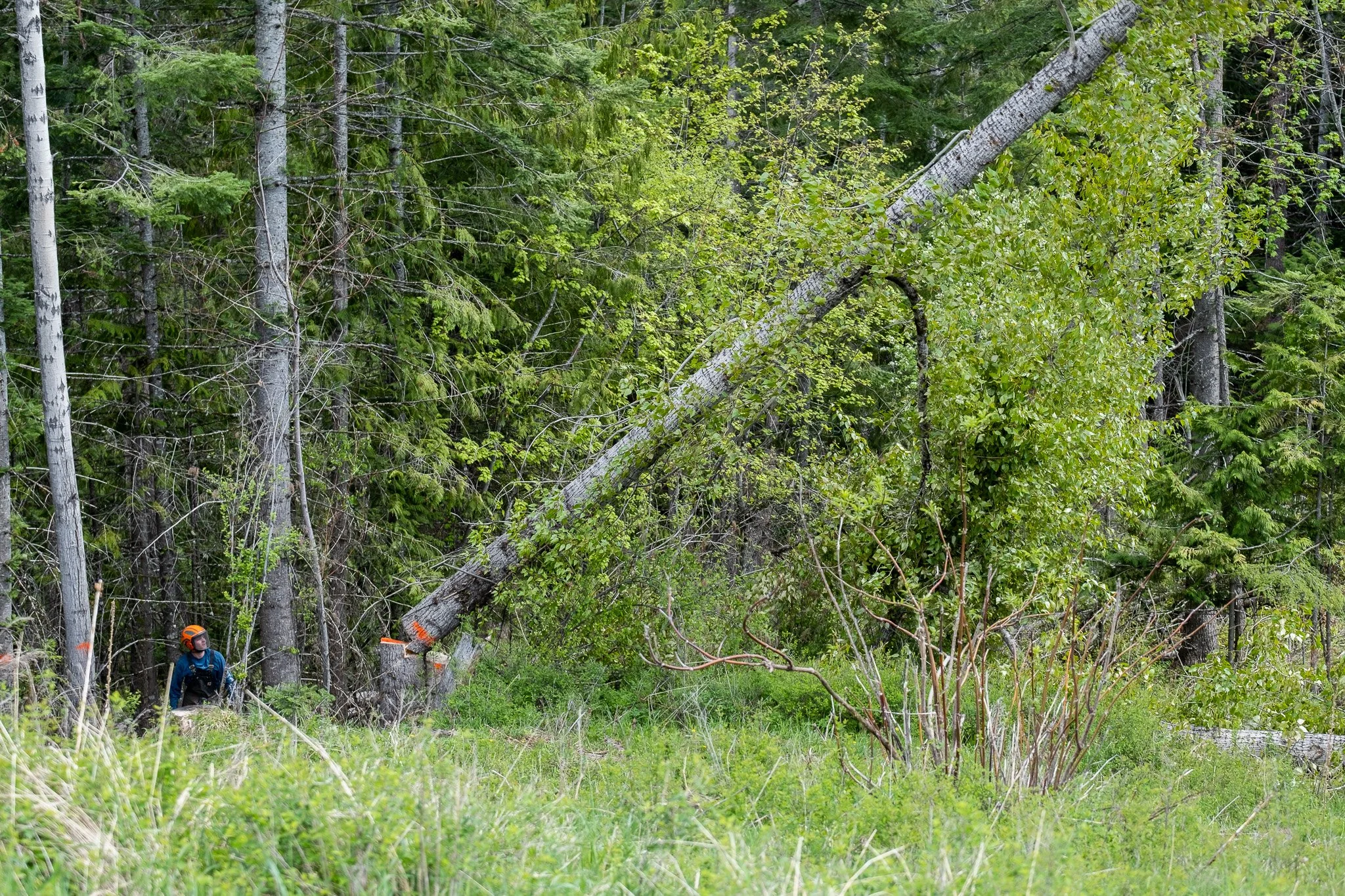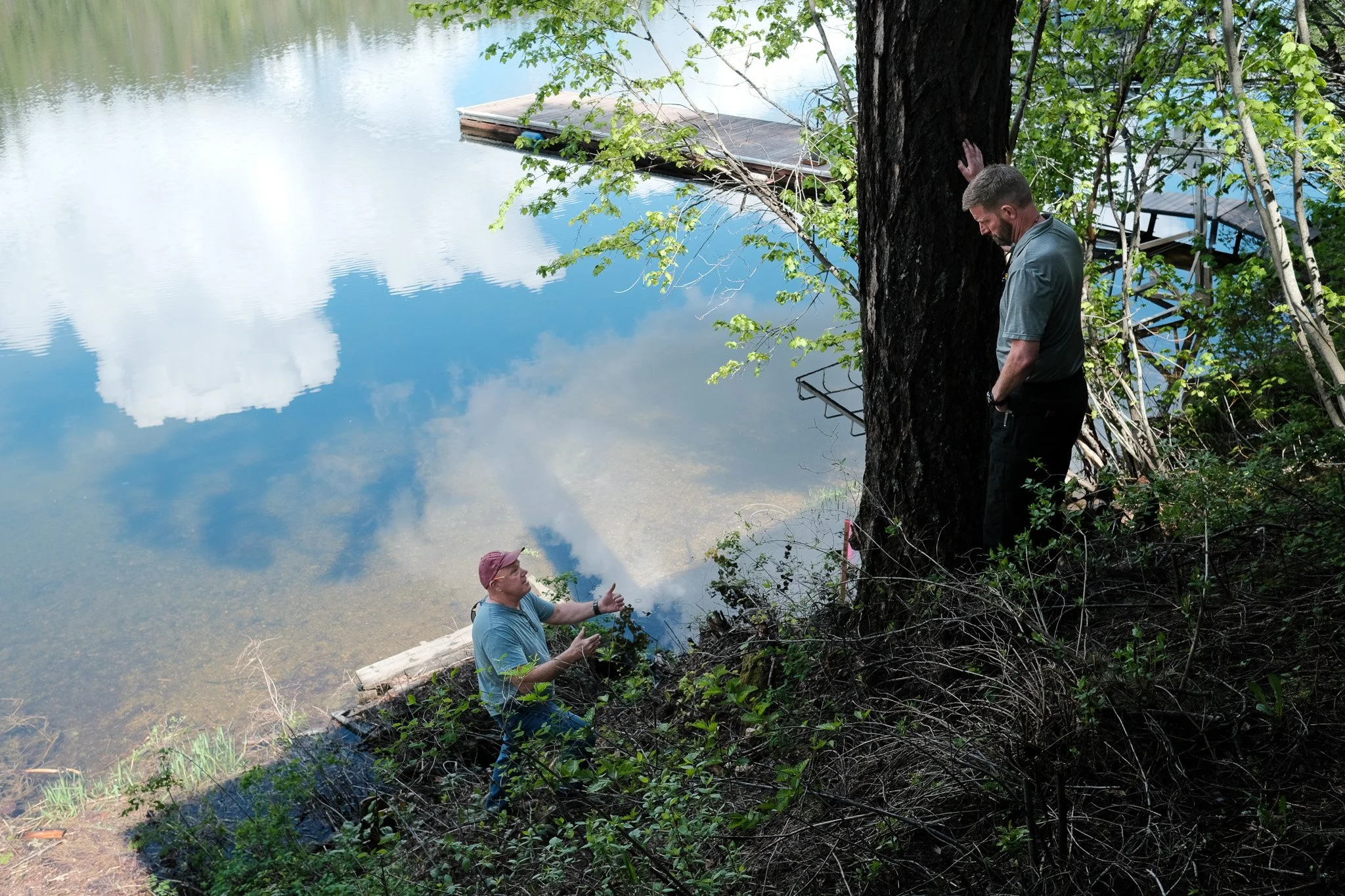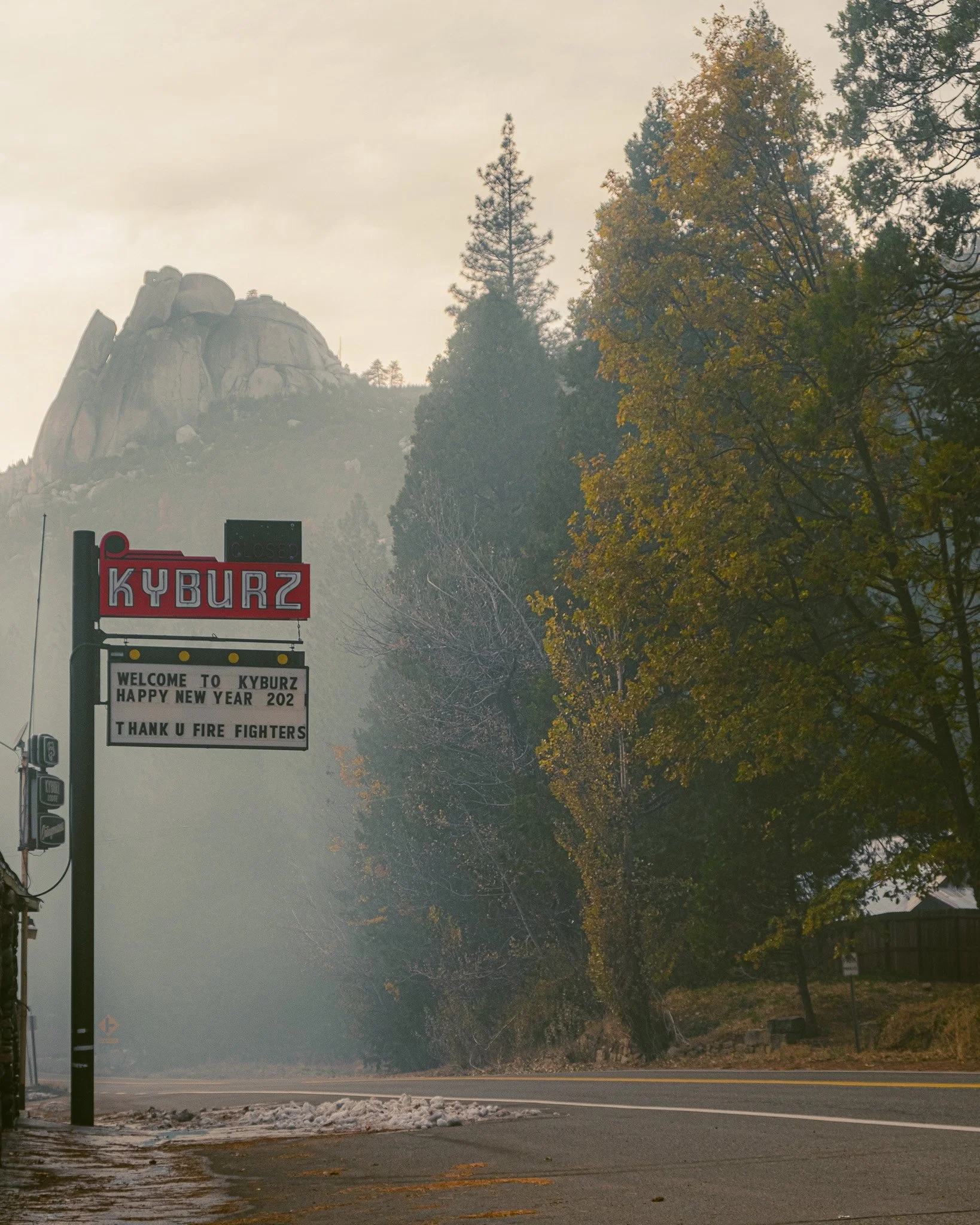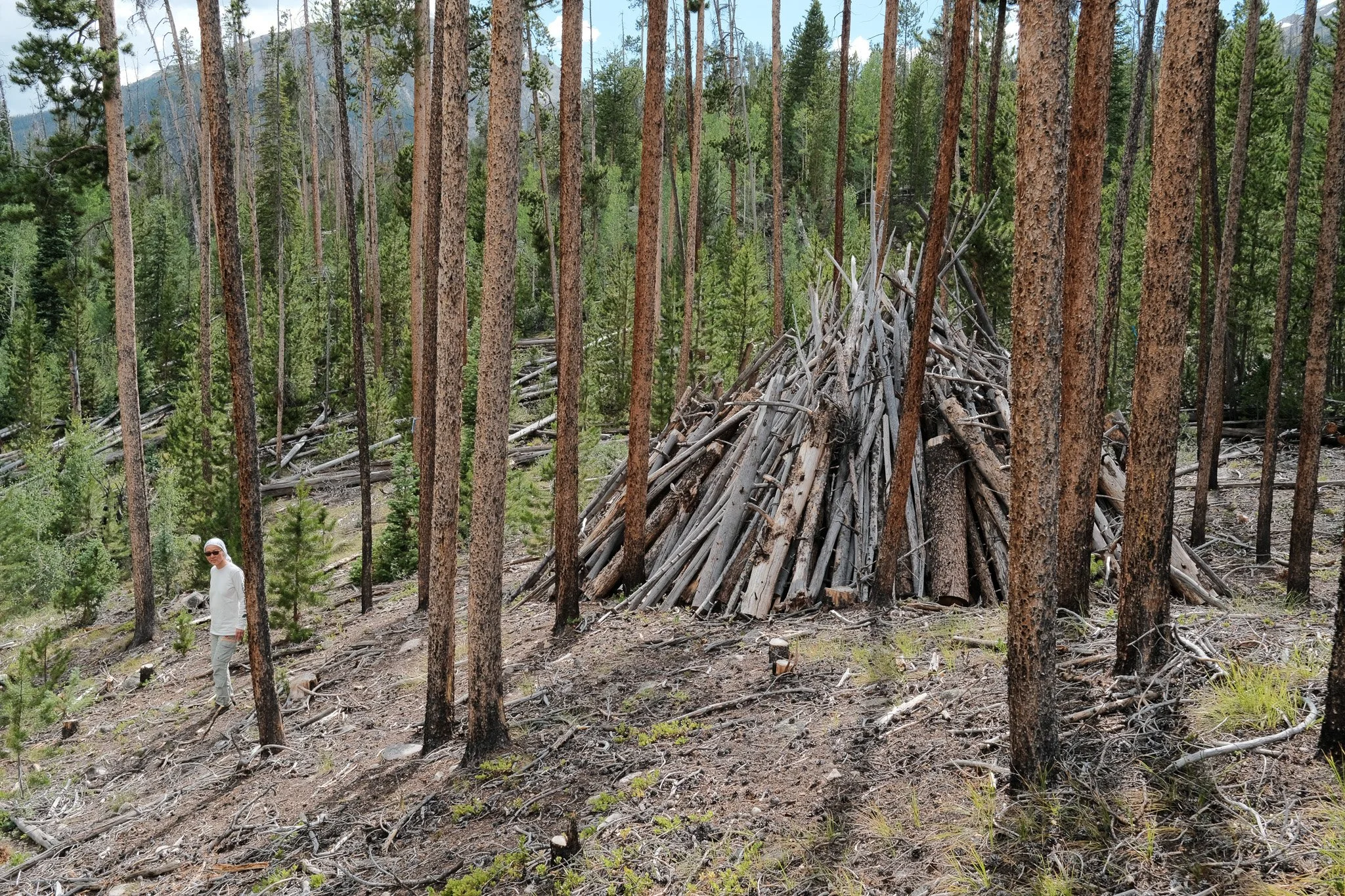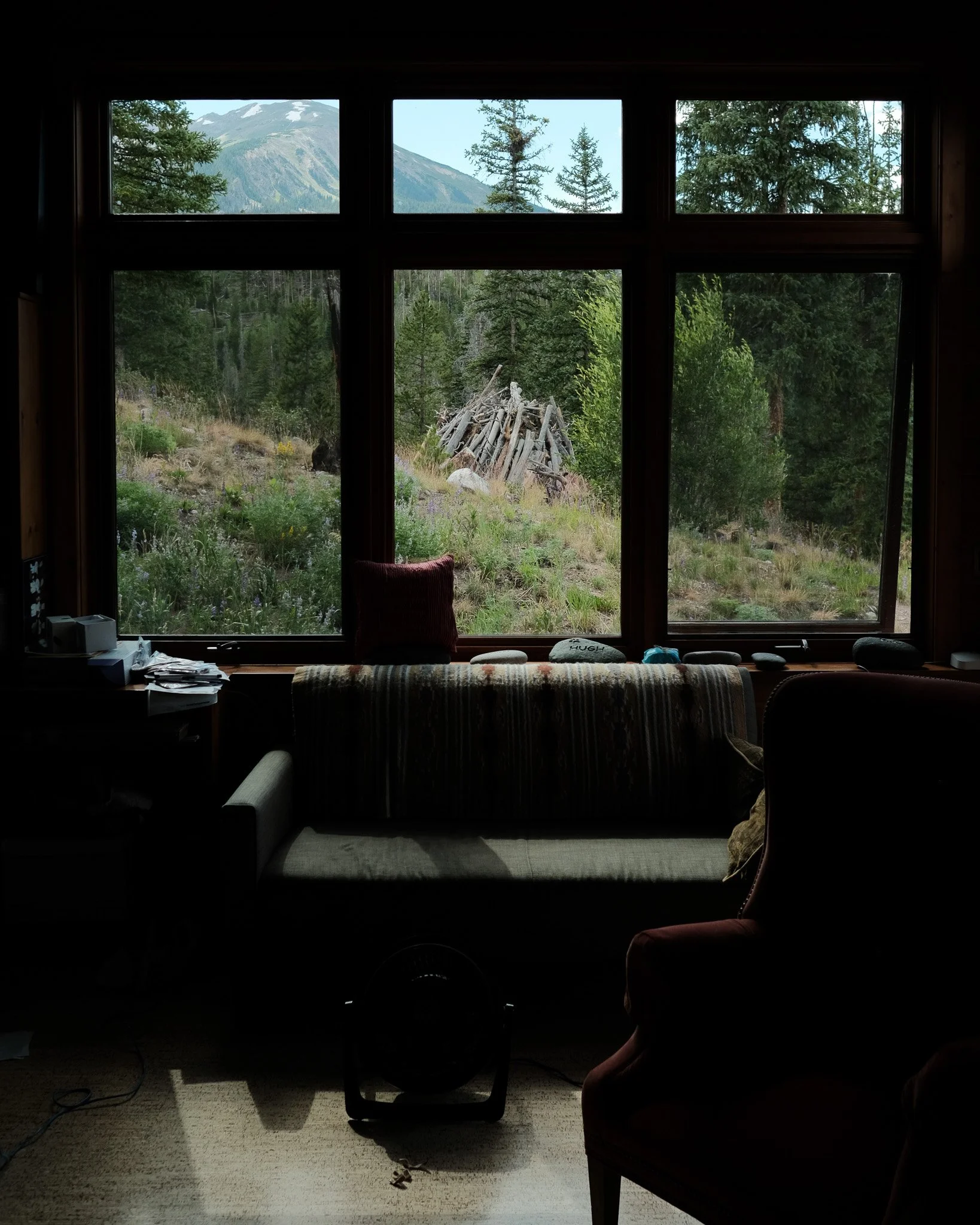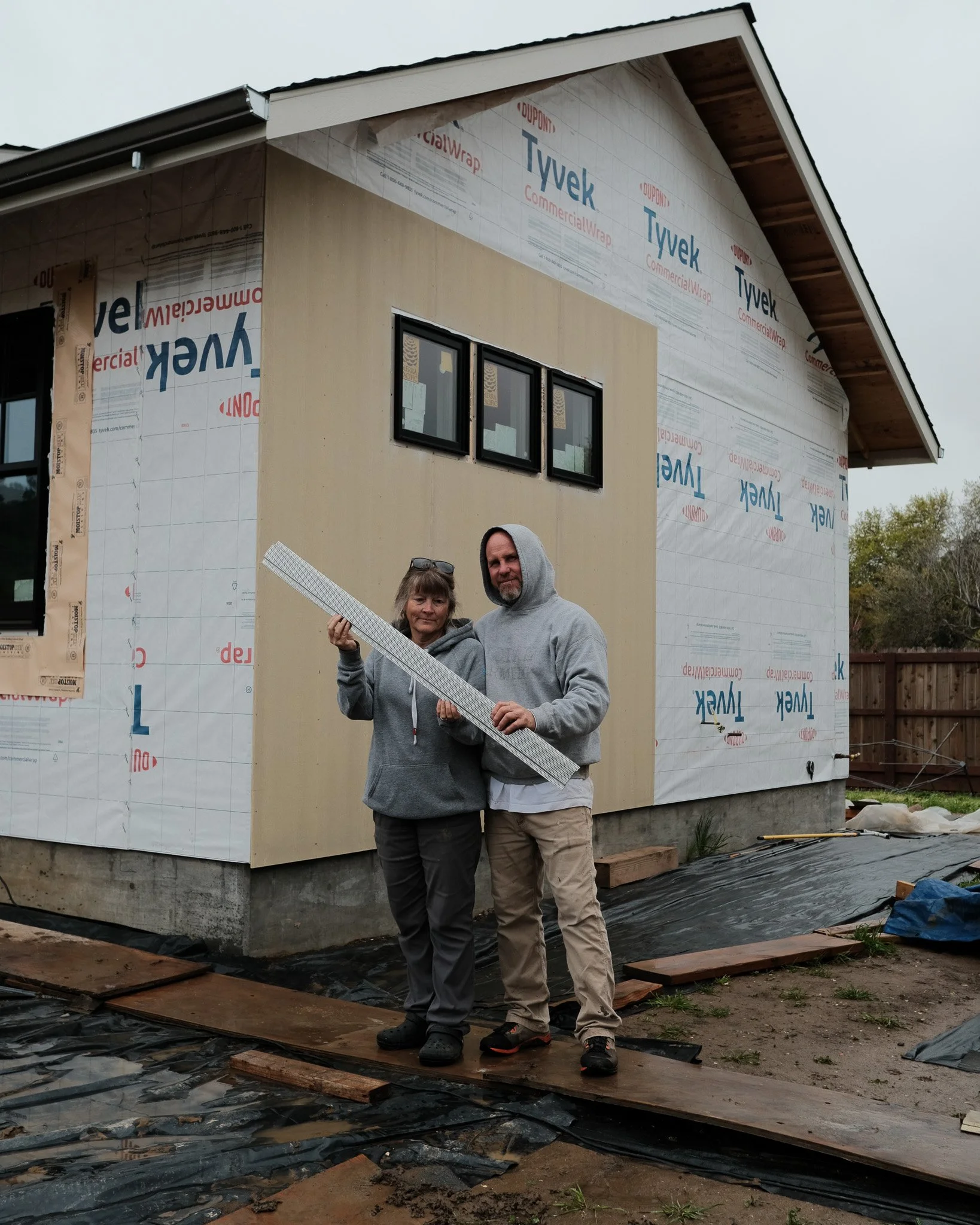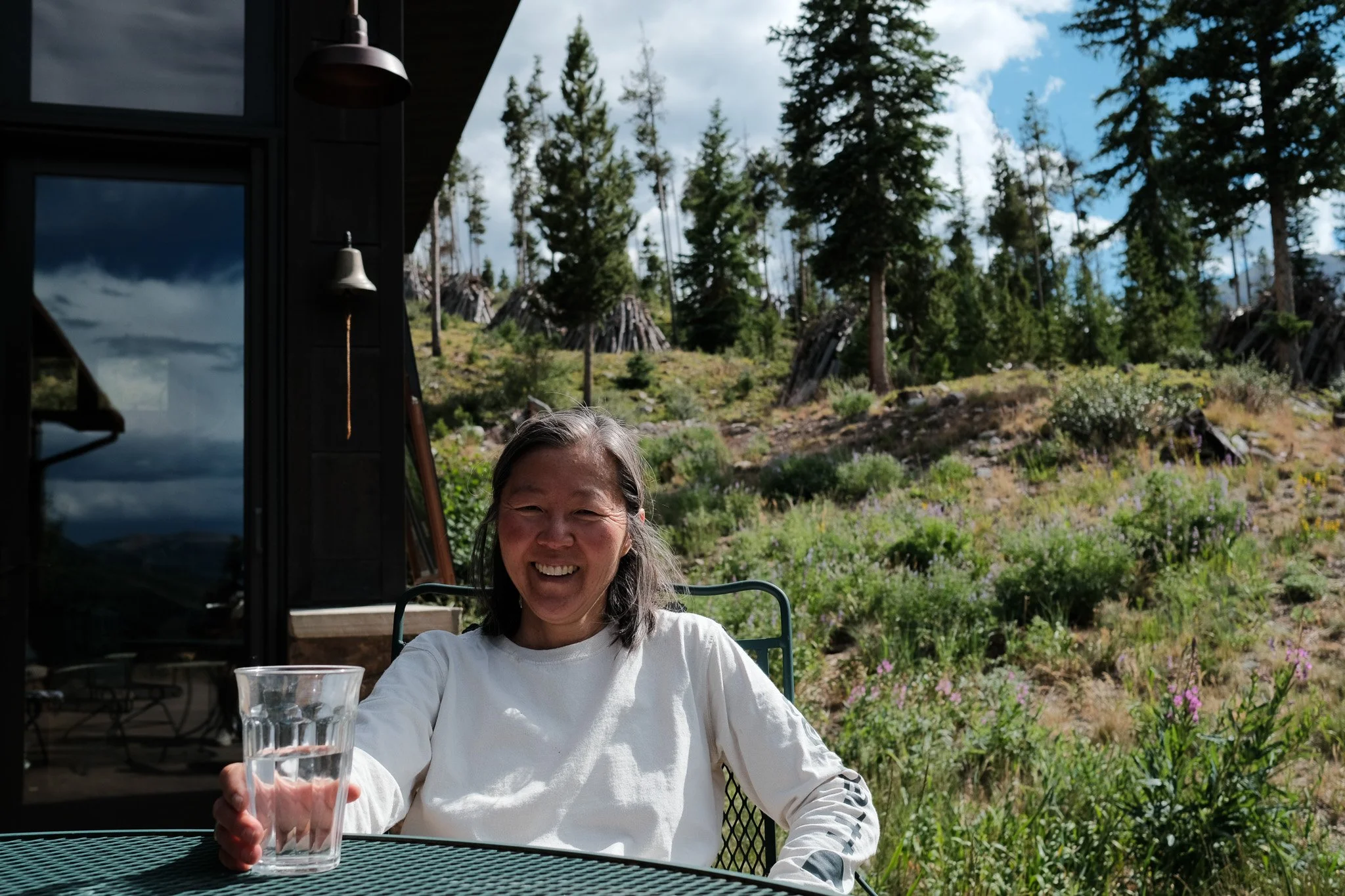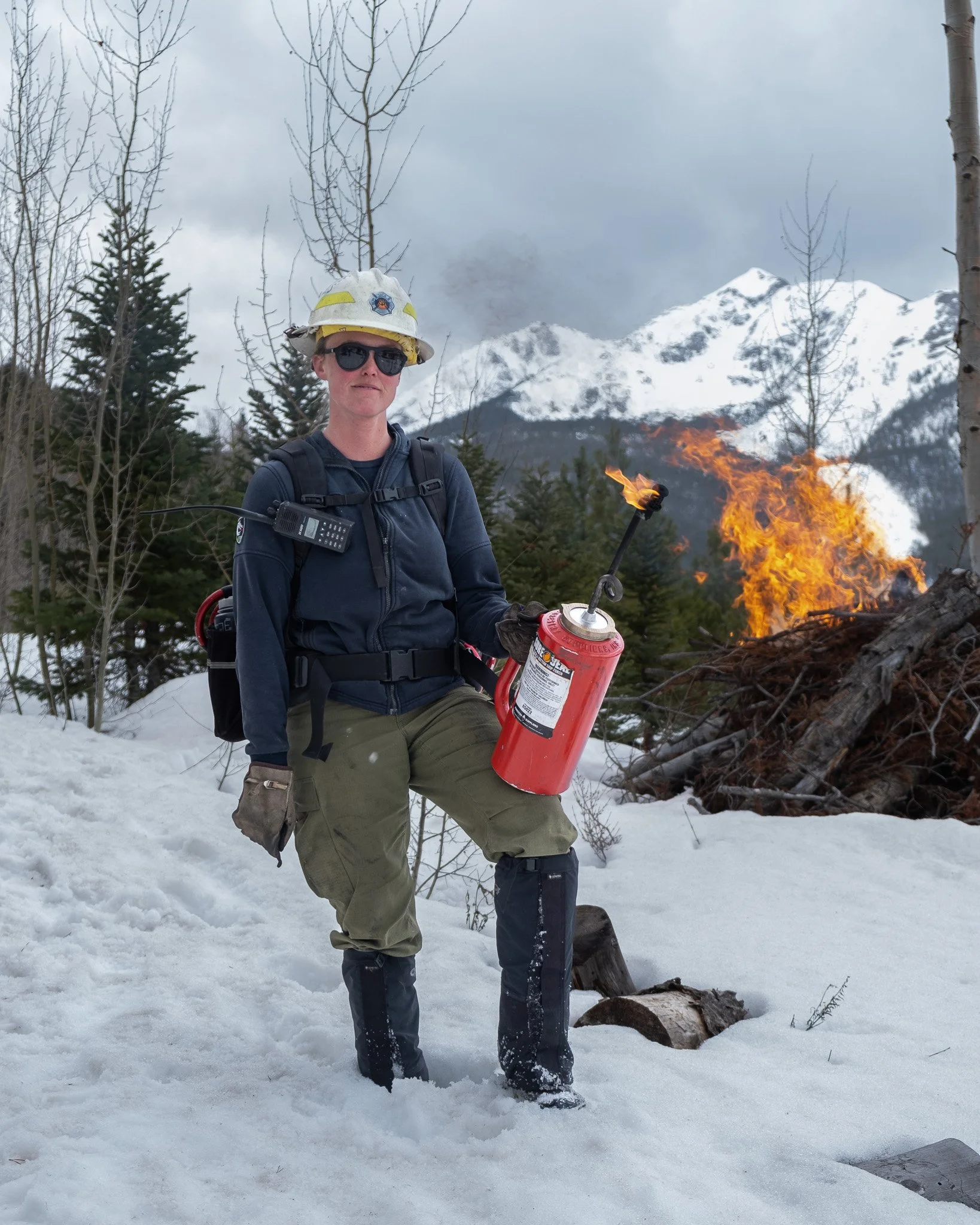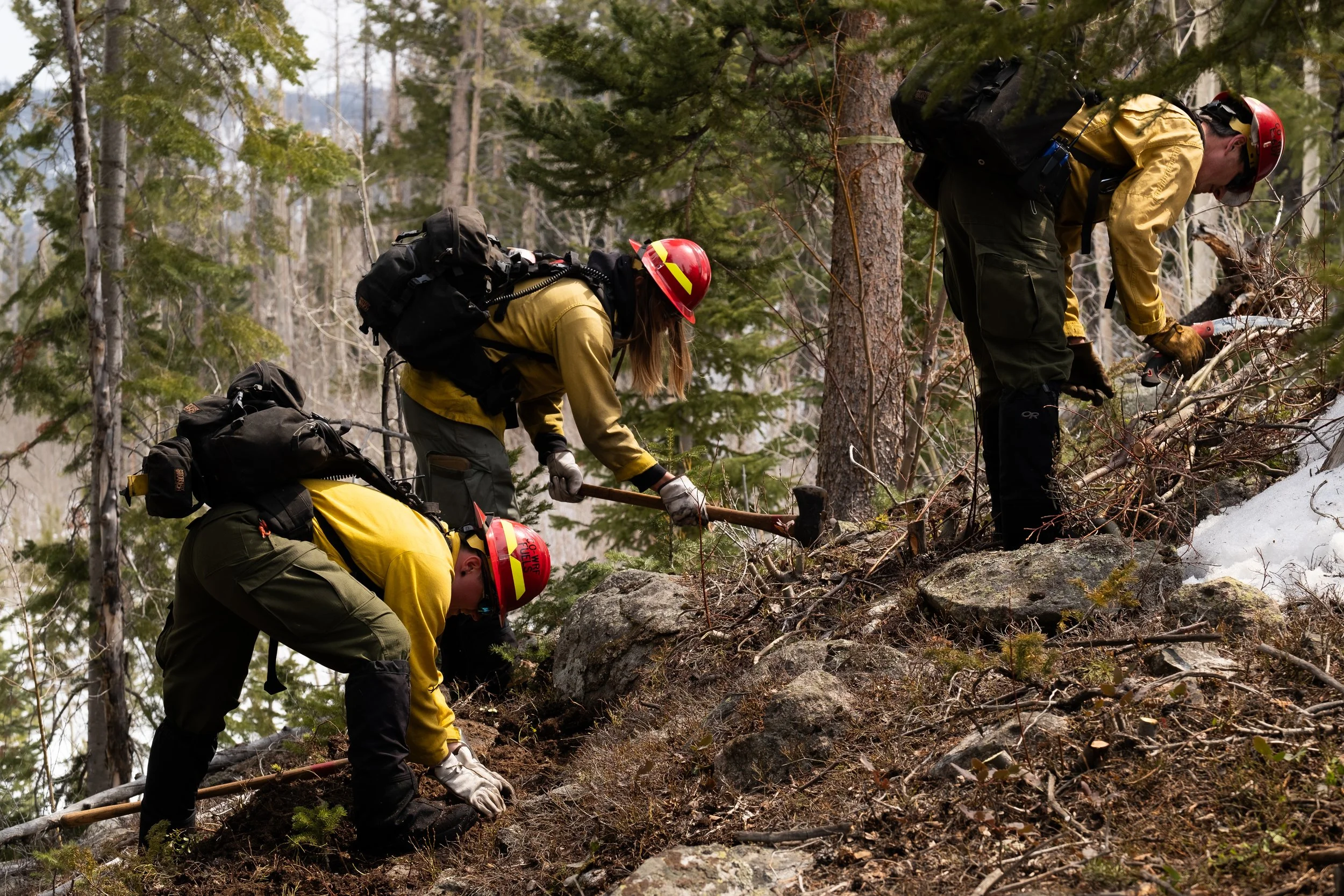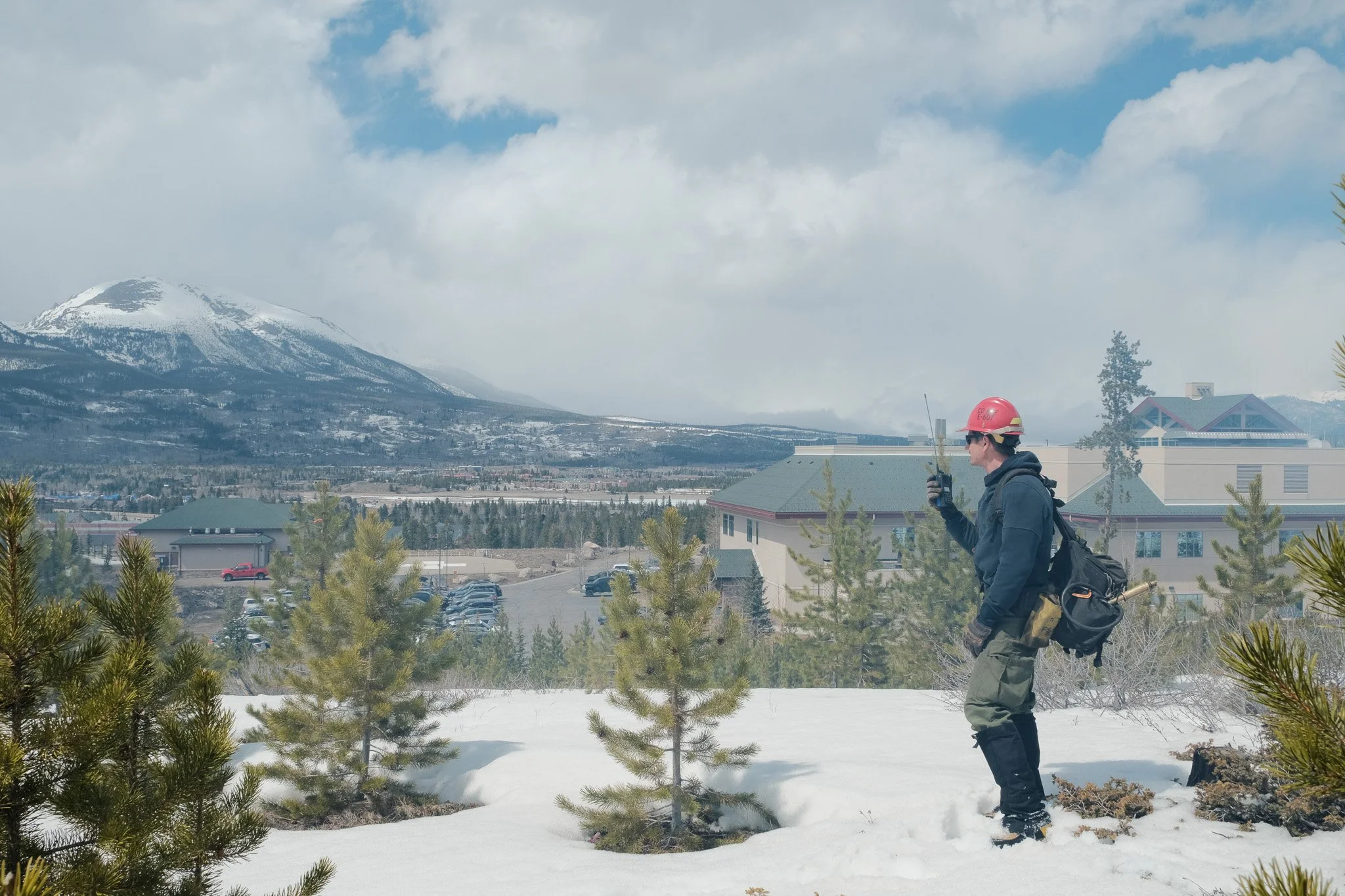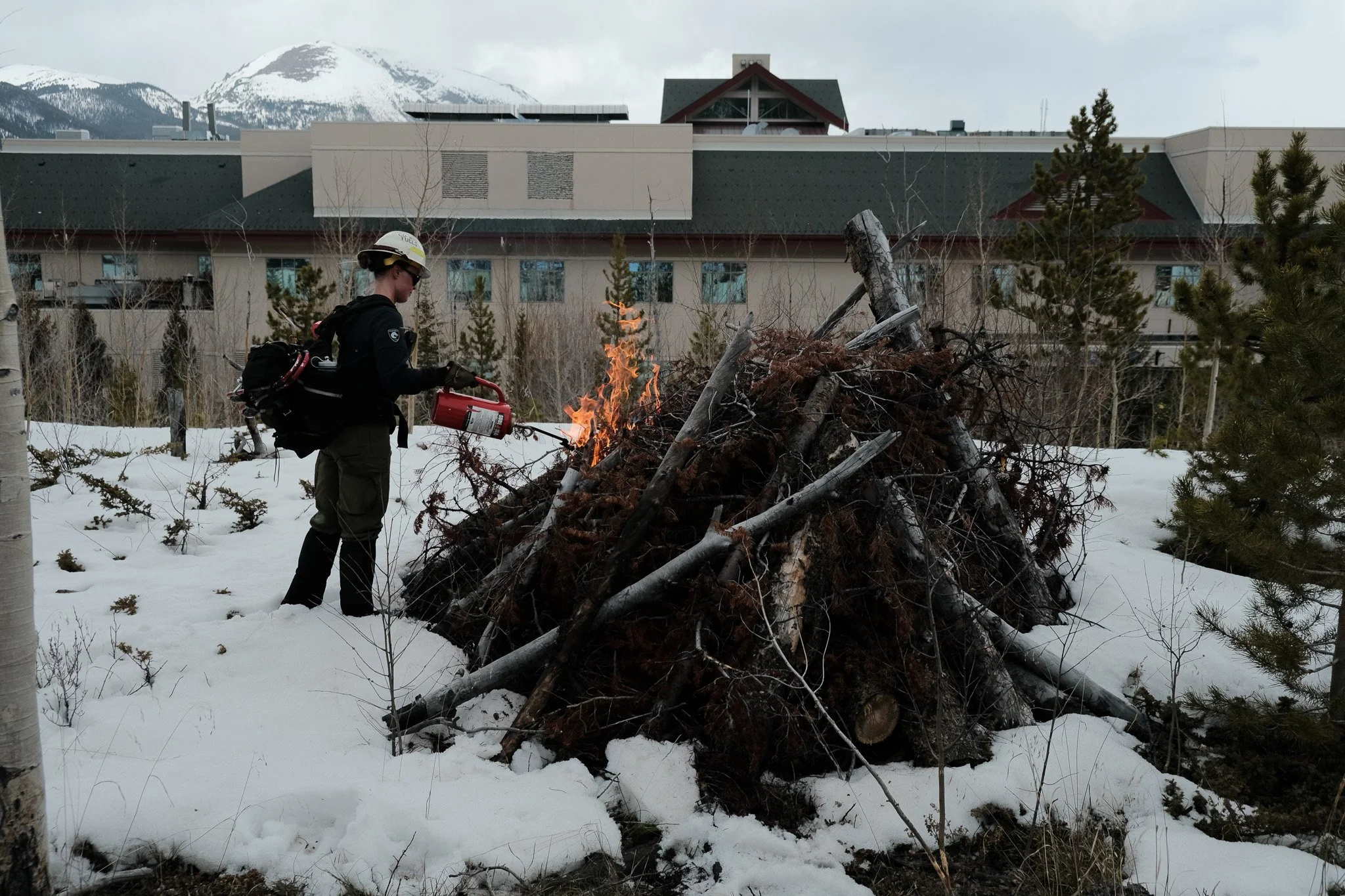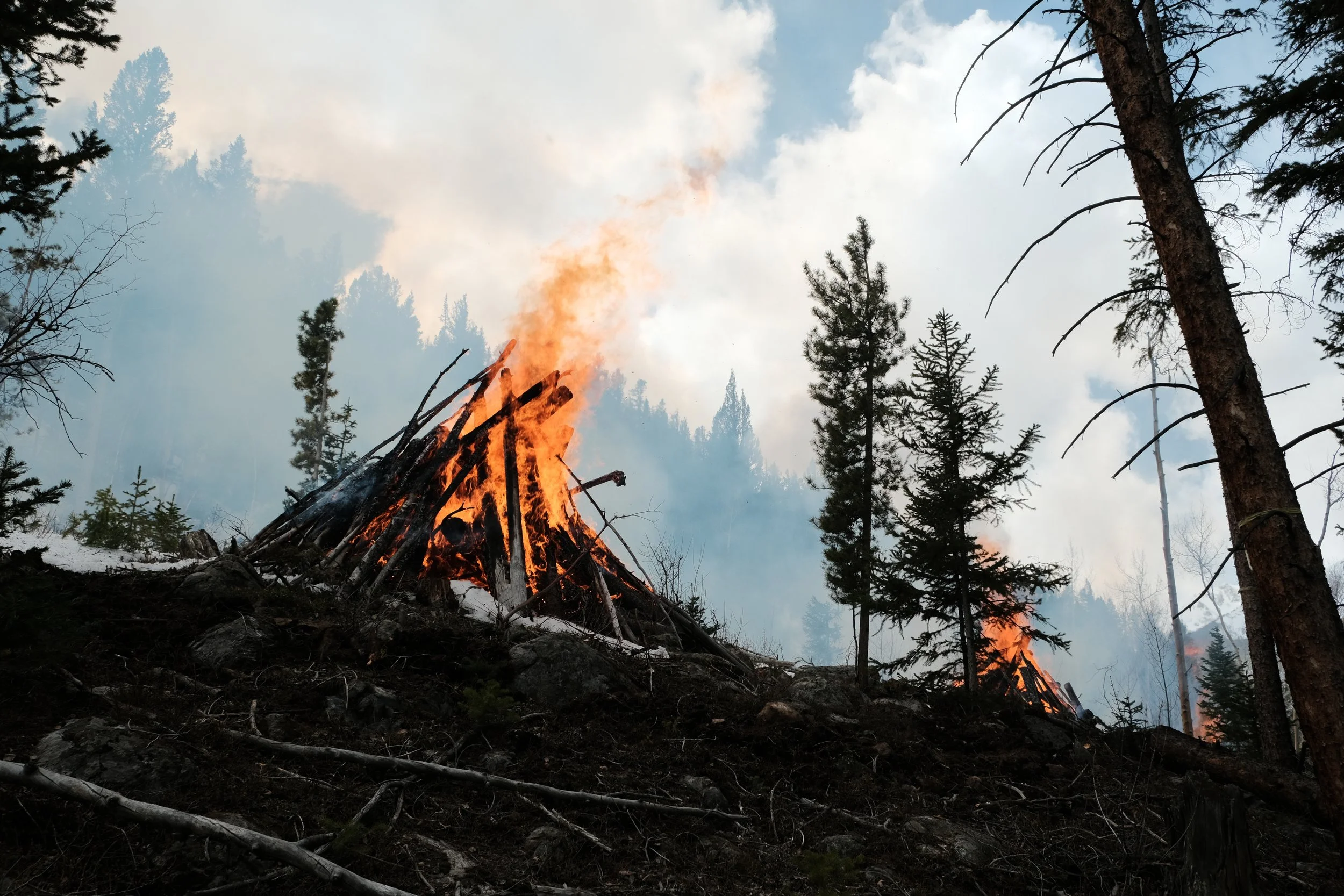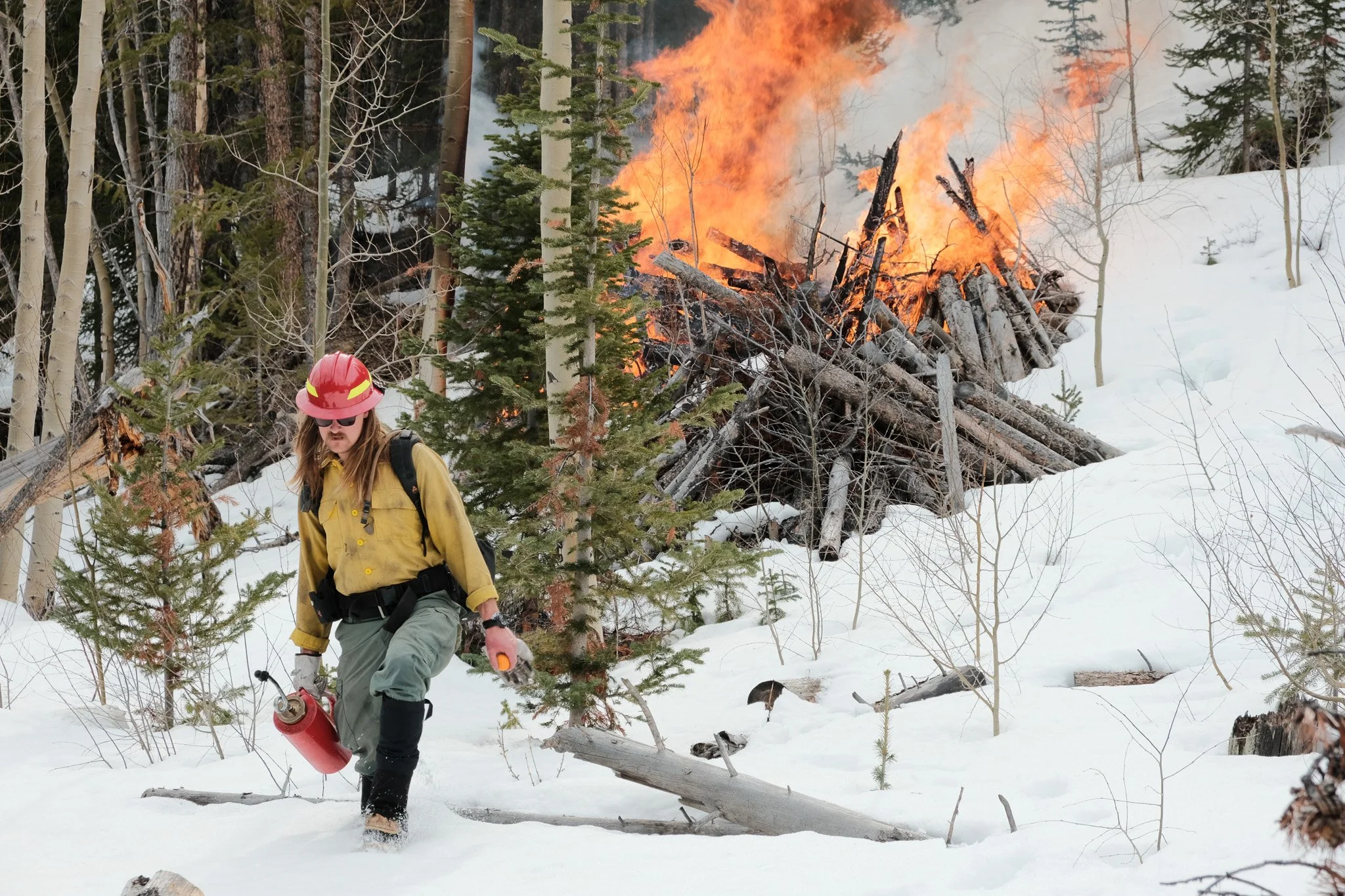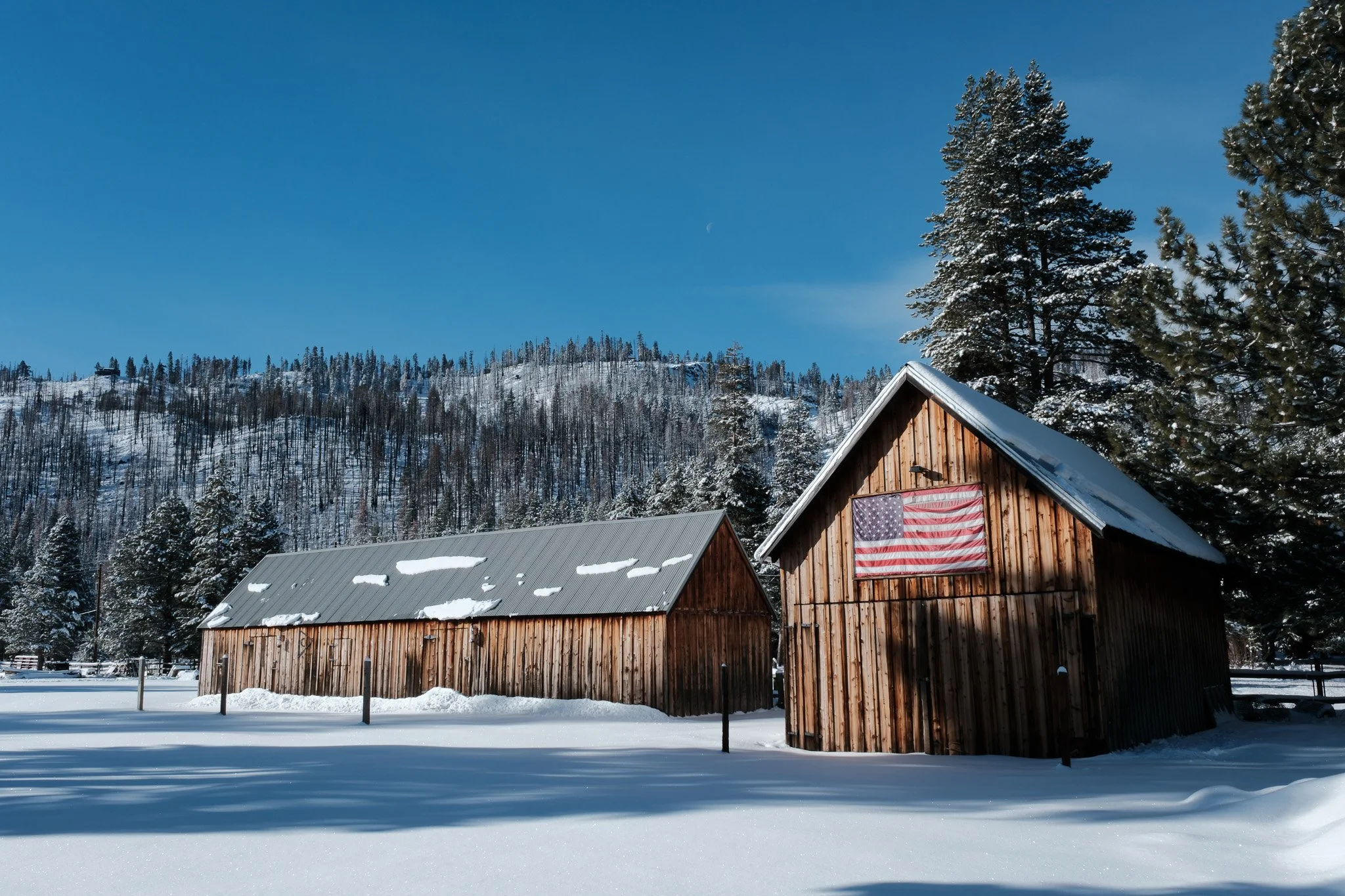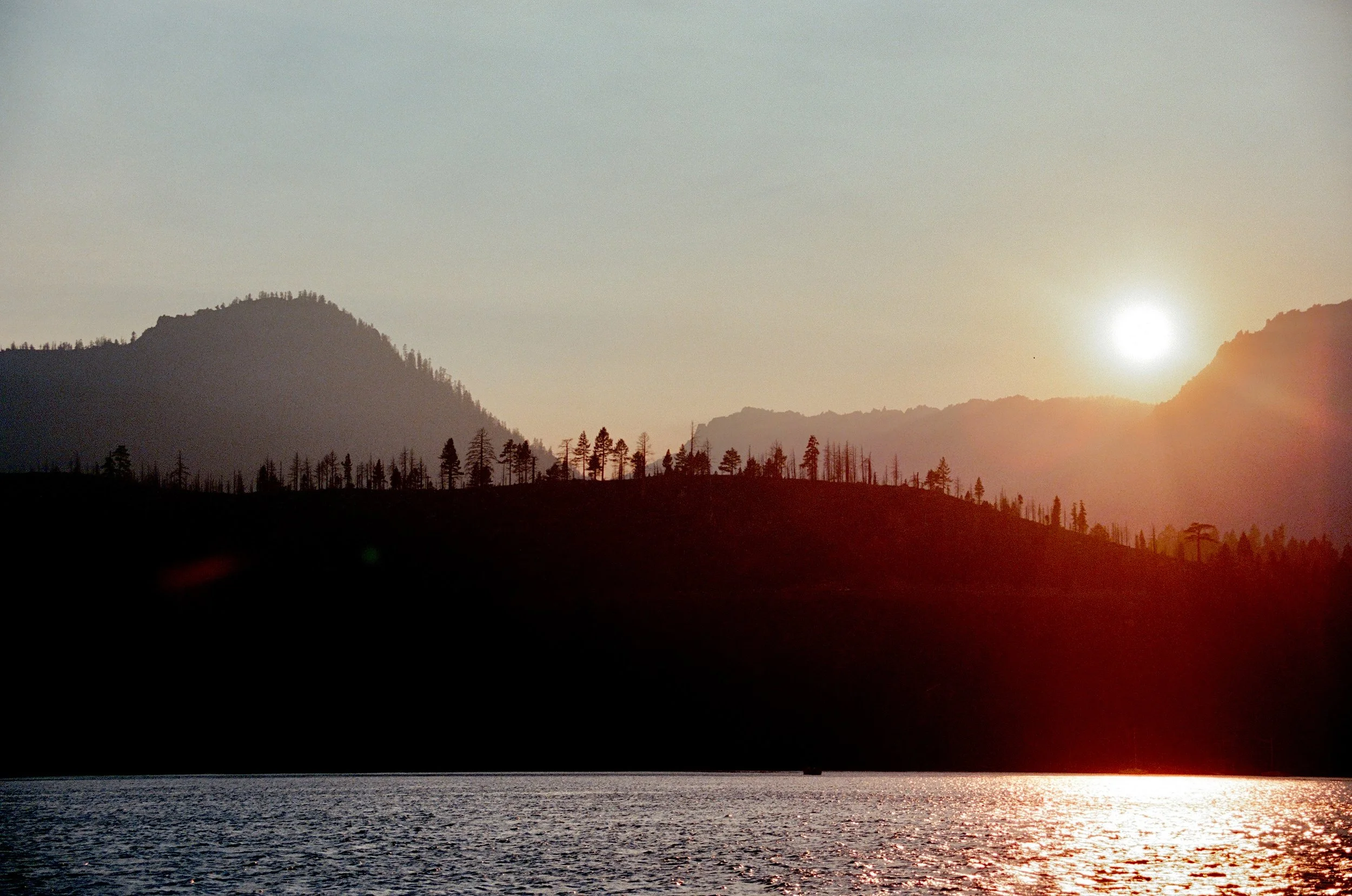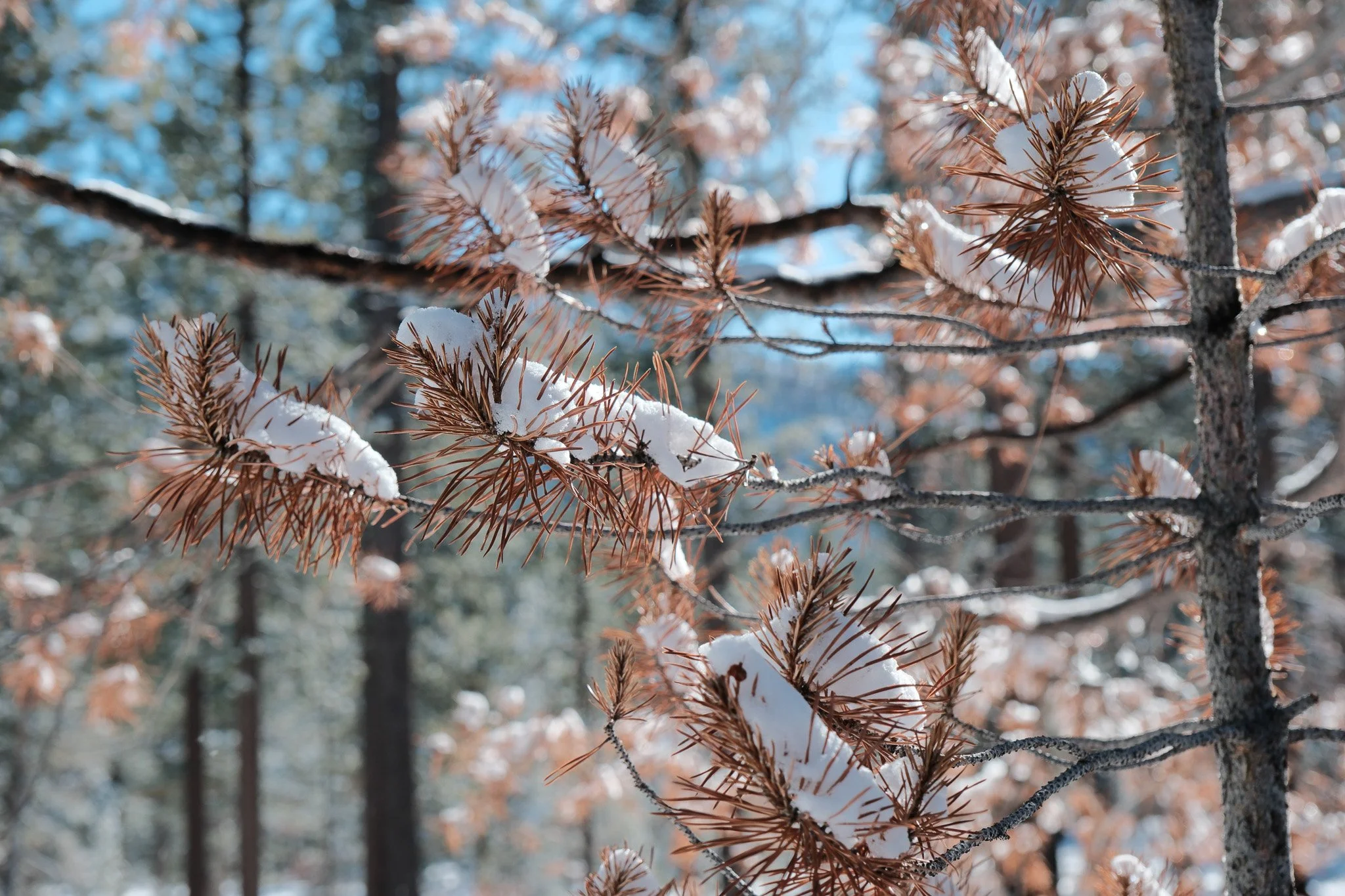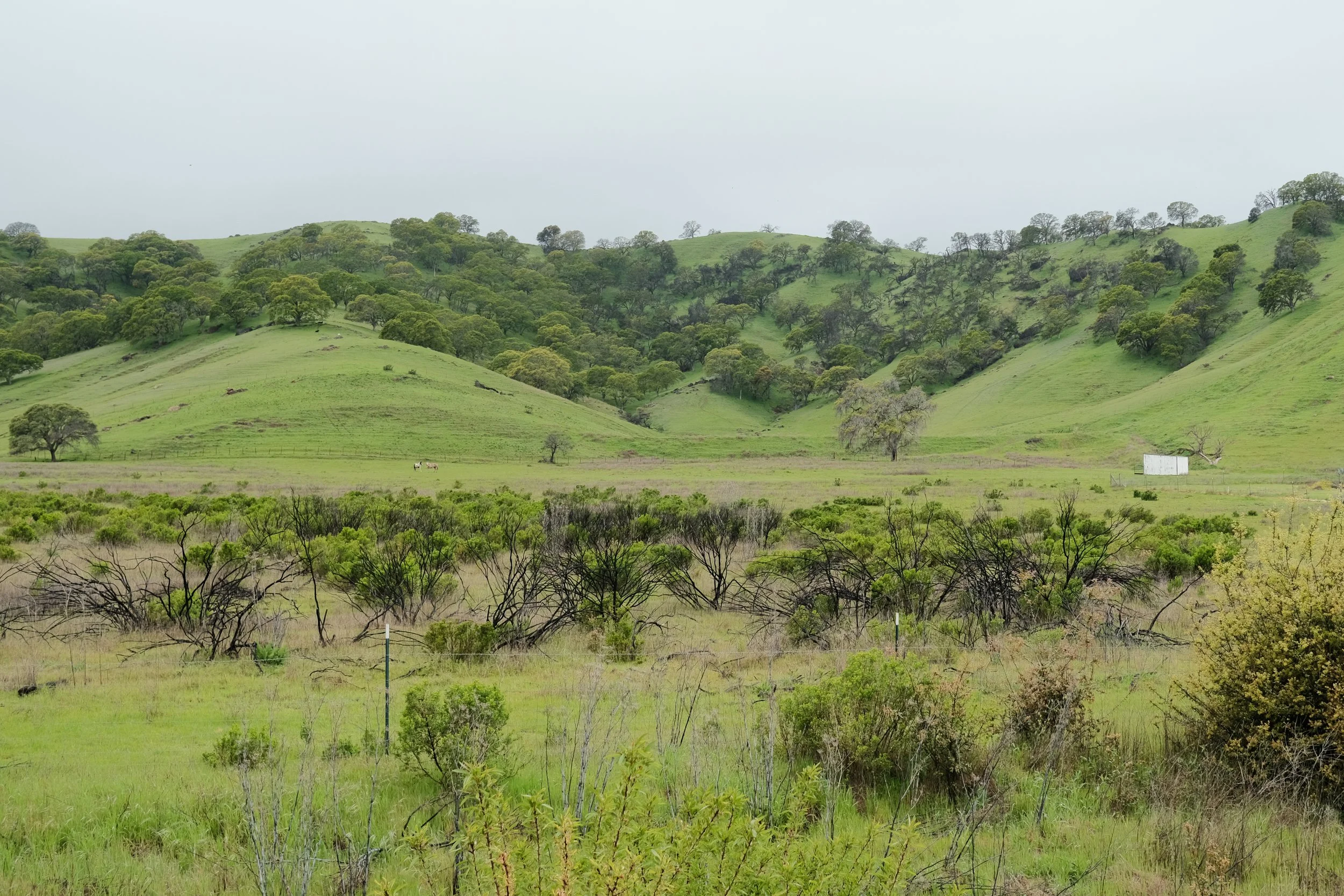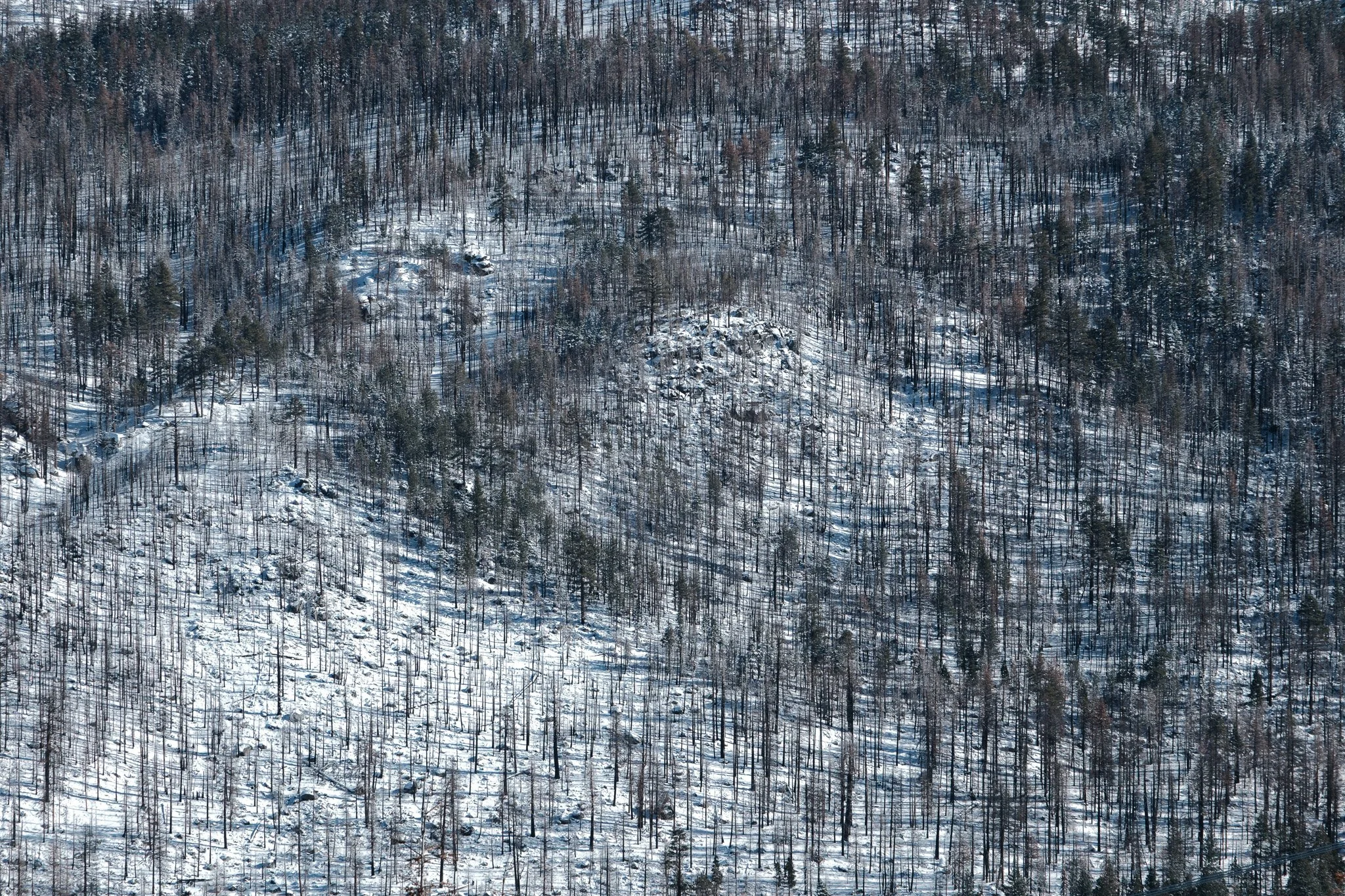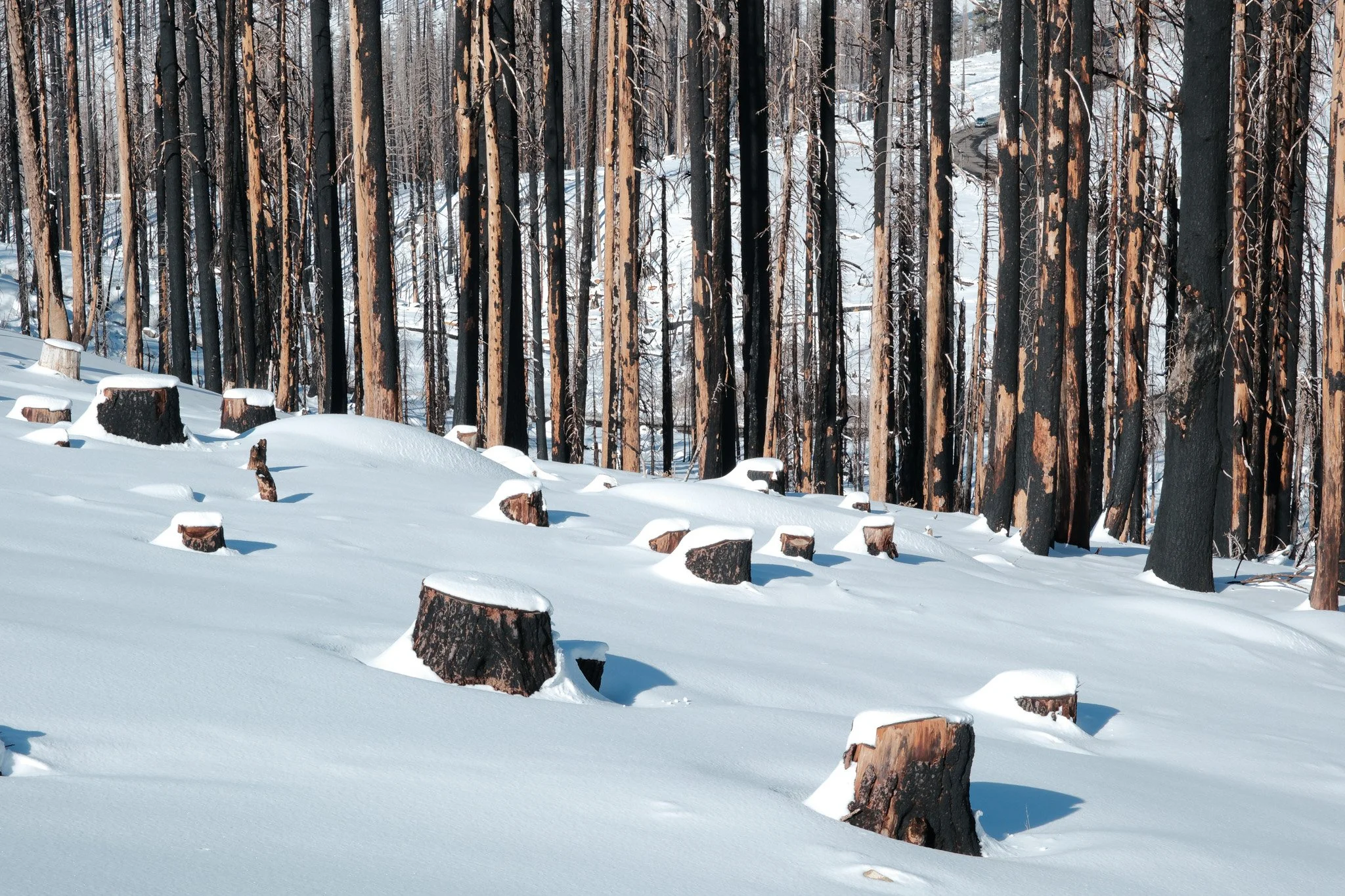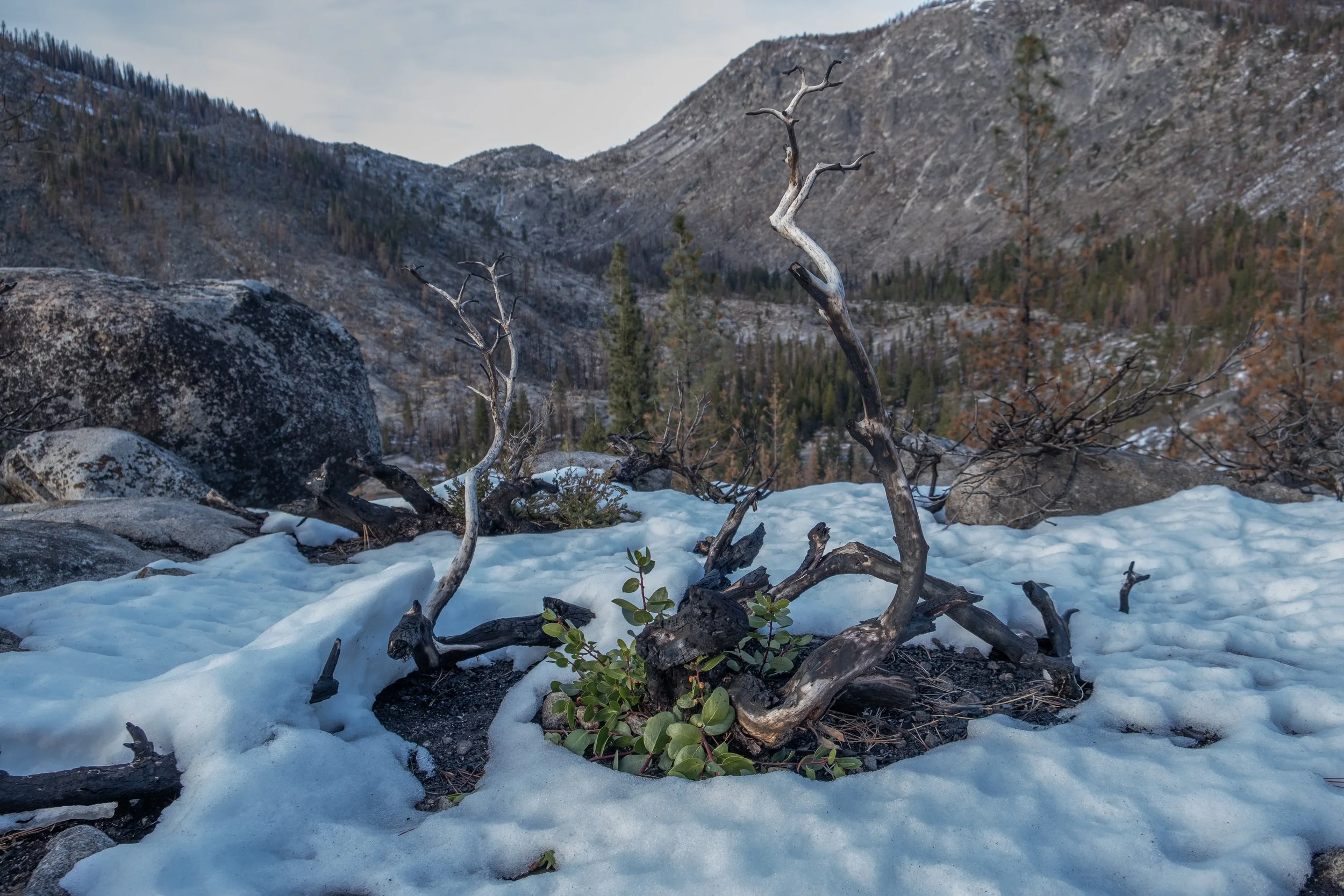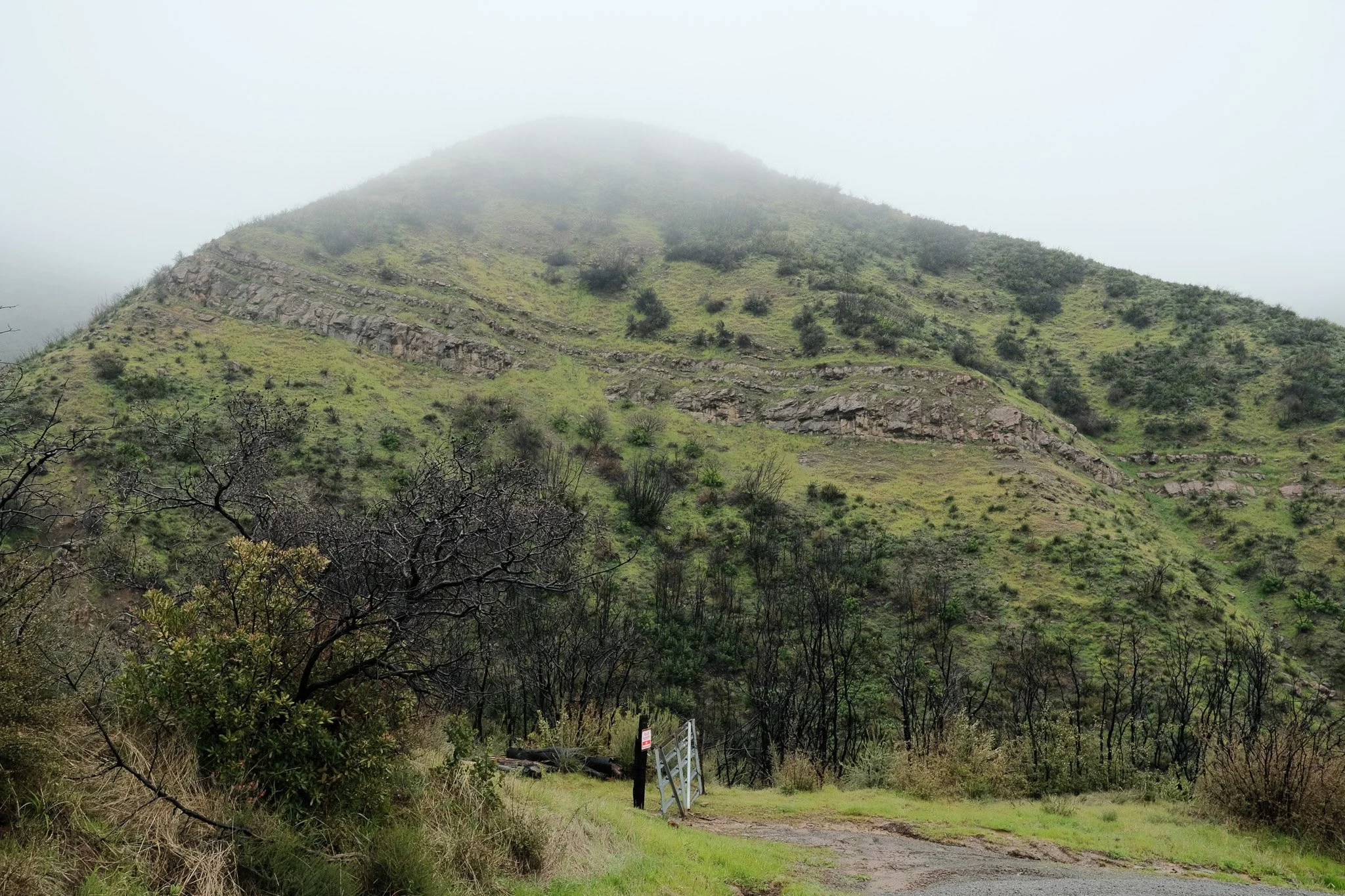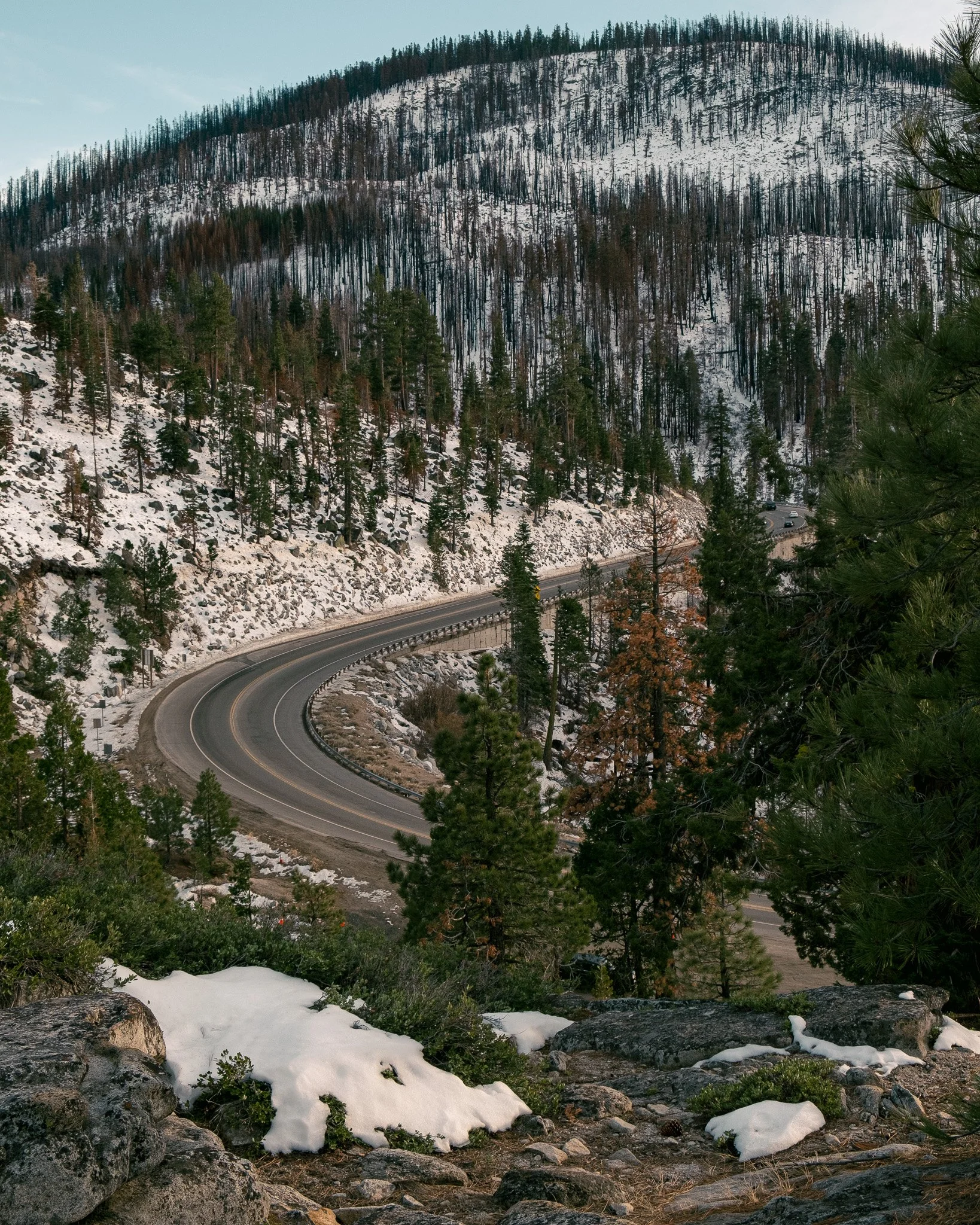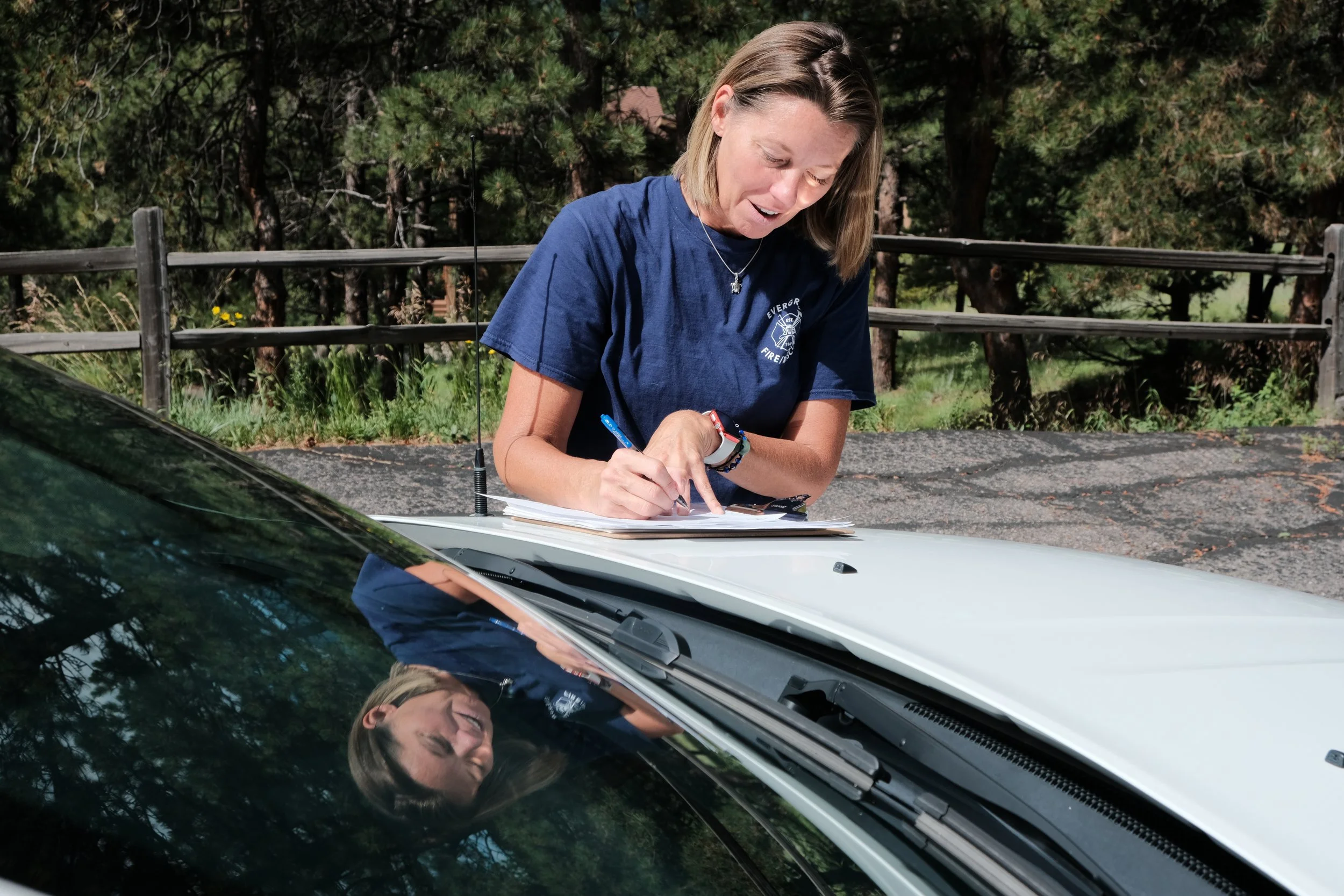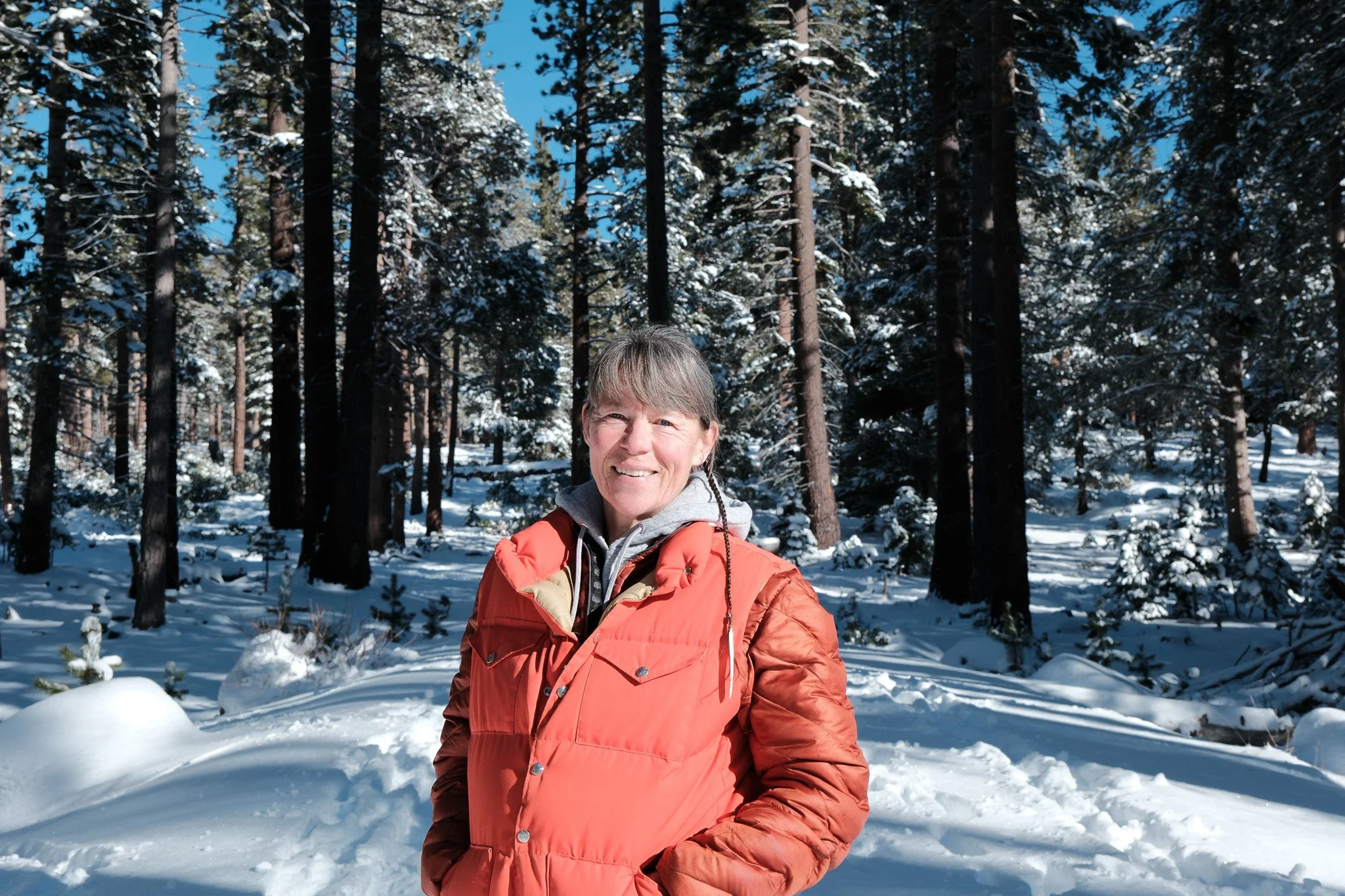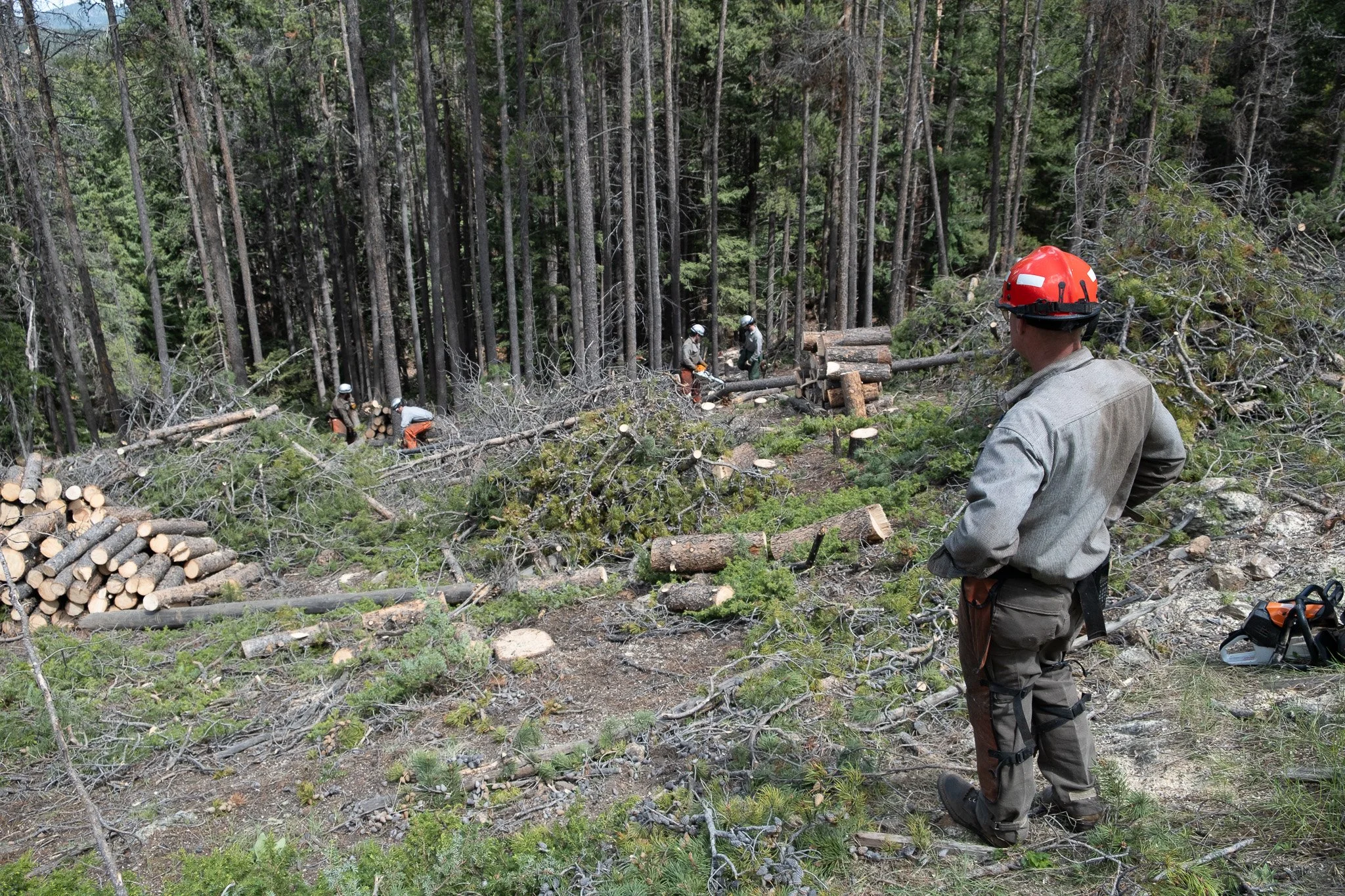
The 150 Year Debt

I.
Fire is now a year-round issue for those living in the American West. After 150 years of systematic fire suppression and the onset of climate change, wildfires have become one of the biggest issues threatening life in the region, along with fire’s counterpart, water.
A wildfire danger meter displays 'moderate' on a snowy day, as a reminder that fire has become a year-round hazard in the WUI.
An excavator bucket rests in a neighborhood that was destroyed in the December 2021 Marshall Fire in Boulder County, CO. The Marshall Fire was the most destructive fire in Colorado history and became a stark reminder that fire has become a year-round hazard in the WUI.
A road sign indicates that a neighborhood in Boulder County, CO has organized itself to align with Firewise fire mitigation principles.
A newly rebuilt house stands next to an empty lot in a neighborhood that was destroyed in the December 2021 Marshall Fire in Boulder County, CO. The Marshall Fire was the most destructive fire in Colorado history and became a stark reminder that fire has become a year-round hazard in the WUI.
A structure fire grows into a wildland fire in Boulder County, CO on December 19, 2022. The fire grew to nearly 20 acres and showed how quickly a structure fire can jump to wildland fuels on windy days.
A neighborhood affected by Colorado's Marshall Fire begins to rebuild itself. The Marshall Fire was the most destructive fire in Colorado history and became a stark reminder that fire has become a year-round hazard in the WUI.
II.
Fire is caused by a few things, including lighting. But the main cause of wildfire in the Westerns US is human activity.
Keenan Prouty, a Fire Mitigation Specialist for Evergreen Fire, conducts a defensible space inspection with homeowners in Evergreen, CO. The power lines running overhead were marked as a concern, and trees in the vicinity would need to be trimmed back.
The town of Vail, CO straddles a narrow valley, with busy Interstate 70 running through the middle. Vail's main human-caused fire risk is from trucks whose brakes have overheated and can ignite brush near where the truckers pull over on the highway shoulder.
Members of multiple fire organizations in Summit County prepare for a broadcast burn at a shooting range near Dillon, CO. Numerous blazes have ignited on the land behind the shooting range, as fired rounds spark dry brush. Human activity is responsible for most wildfire ignitions in the Western US.
A gas can sits on the forest floor. Heavy machinery can spark while in operation, potentially igniting brush.
A US Forest Service campground booth implores campers to not set off fireworks while in the area. Fireworks are a common culprit for human-driven wildfire ignitions.
Afternoon thunderstorms loom in the distance behind a cow pasture in Kootenai County, ID in the spring of 2023. Lightning strikes are the primary driver of naturally-caused wildfires in the Western US.
US Forest Service Fuels Planners walk toward a site planned for a prescribed burn. Three wildfires have ignited in recent years behind a public shooting range, due to the illegal use of incendiary tracer rounds.
A sign at a trailhead in Boulder County, CO reminds recreational users to not light any fires in the area.
III.
Forests are in bad shape (overgrown, susceptible to disease and invaders, especially pine beetles). These conditions, and lack of natural, low-intensity fire to clear out the debris, are a main factor driving the spike in wildfire intensity over the last few decades.
Forests in Summit County, CO have been severely affected by beetle infestation. Mountain pine beetles cause swaths of trees to die, leaving dry fuel on the forest floor for a potential wildfire to exploit.
Arceuthobium, commonly known as Dwarf Mistletoe, is a parasitic plant that predominantly affects ponderosa and lodgepole pines in the Western US. Forests weakened by drought and a warming climate are more susceptible to parasites and disease.
A fallen tree displays markings of beetle infestation. Mountain pine beetles cause swaths of trees to die, leaving dry fuel on the forest floor for a potential wildfire to exploit.
Jess Moore, the Evergreen Fire Wildland Project Coordinator, surveys an area covered in dry needles as part of a defensible space inspection. Evergreen Fire utilizes free and voluntary defensible space inspections to teach homeowners how to harden their homes to mitigate fire risk.
A tree in Evergreen, CO shows abnormal growth marks as a result of infection by Arceuthobium, commonly known as Dwarf Mistletoe, a parasitic plant. Forests weakened by drought and a warming climate are more susceptible to parasites and disease.
Horseback riders take in the forest landscape in Montana's Bob Marshall Wilderness. While the scene is aesthetically pleasing, the trees in the background display an incredibly dense and overgrown forest.
A fallen tree displays markings of beetle infestation. Mountain pine beetles cause swaths of trees to die, leaving dry fuel on the forest floor for a potential wildfire to exploit.
IV.
Local fire organizations are using a sales-mindset to flip conventional wisdom for residents. Instead of preventing fires (which authorities can no longer do), residents need to prepare their property for the inevitability of wildfire.
Jess Moore, the Evergreen Fire Wildland Project Coordinator, surveys the home ignition zone with homeowners in Evergreen, CO. Evergreen Fire utilizes free and voluntary defensible space inspections to teach homeowners how to harden their homes to mitigate fire risk.
Paul Cada, Wildland Program Manager at Vail Fire, uses a whiteboard to keep tabs on running projects and to remind himself of themes to carry into day-to-day interactions with citizens.
Keenan Prouty, a Fire Mitigation Specialist with Evergreen Fire Rescue, conducts a defensible space inspection for a homeowner on an early summer morning.
An aspen grove sits next to an Evergreen Fire neighborhood ambassador’s home in Evergreen, CO. Evergreen Fire uses this ambassador’s home as an example of fire-resilient yard work, as aspen groves are generally considered to be a buffer against flying embers from a wildfire.
Dust from a slash pile chipper obscures the air in Vail, CO. The Vail Fire district works with homeowner associations to chip wooden debris that has become a fire hazard near residences.
Jess Moore, the Evergreen Fire Wildland Project Coordinator, pulls over to discuss home hardening with a homeowner in Evergreen, CO.
Jess Moore, the Evergreen Fire Wildland Project Coordinator, examines trees that have grown too close to a structure, as part of a defensible space inspection. Evergreen Fire utilizes free and voluntary defensible space inspections to teach homeowners how to harden their homes to mitigate fire risk.
Carrie McKenzie, a Fire Mitigation Specialist for Evergreen Fire, surveys the home ignition zone with a homeowner in Evergreen, CO.
Two trees stand marked with blue paint, to indicate they should be removed from a home's ignition zone in Evergreen, CO. Evergreen Fire utilizes free and voluntary defensible space inspections to teach homeowners how to harden their homes to mitigate fire risk.
Keenan Prouty, a Fire Mitigation Specialist with Evergreen Fire Rescue, feels the scratch marks left by a bear in an Aspen trunk. Aspens are seen as a relatively fire resilient species, and are encouraged to grow in the Evergreen area.
Hannah Ohlson, a Wildland Specialist for Summit County Fire, signs paperwork to signify a group of new townhomes in Silverthorne, CO have been evaluated for their defensible space. All new construction in Summit County, CO must be inspected for proper defensible space.
Hannah Ohlson, a Wildland Specialist for Summit County Fire, meets with a contractor for a defensible space inspection in Silverthorne, CO on April 18, 2023. All new construction in Summit County, CO must be inspected for proper defensible space.
Jess Moore, the Evergreen Fire Wildland Project Coordinator, takes note of fire mitigation work done by homeowners in Evergreen, CO. Engaging with homeowners, and ensuring they feel heard is a large portion of Moore's job.
Jess Moore presents on the merits of free defensible space inspections for residents in Evergreen, CO.
Jess Moore distributes wildfire and home hardening informational pamphlets, as part of a defensible space inspection.
V.
Organizations like the US Forest Service and municipal fire districts are taking a more active approach to land management. After coming to the realization that the past 150 years of land management was short-sighted and contributed greatly to the unhealthy state of western forests, land managers are looking to build resiliency back into the landscape.
James Estle, Fuels Crew Supervisor for Evergreen Fire Rescue, gets ready to head home for the evening, after supervising the work done to cut and pile overcrowded trees in a forest in Evergreen, CO.
Crew members stacks recently cut wood during a cut day in Evergreen, CO.
A land parcel in Evergreen, CO shows signs of mechanical thinning after a day’s work. The wood is left in piles for residents to collect for firewood.
Kat Gray, US Forest Service fuels planner, uses digital mapping technology to show a co-worker the boundaries of a treatment plan area.
Dan Schroder, administrator for the Summit County Wildfire Council, reviews his meeting notes at the Summit County headquarters in Frisco, CO. The Summit County Wildfire Council meets quarterly to strategize wildfire mitigation actions among county stakeholders.
Paul Cada, Wildland Program Manager at Vail Fire, surveys 40 acres of land that burned in 2021 as part of a large-scale prescribed fire project in the Booth Creek drainage. Vail Fire is working to reintroduce healthy doses of fire to the land it manages in the town.
Kat Gray inspects a finished forest treatment in Blue River, CO. The US Forest Service works with contractors when it does not have the needed in-house manpower needed to perform forest treatments.
A crew member uses an axe to fell a dead tree in Evergreen, CO.
Recently cut timber lays stacked in rows after a crew worked through the area in Evergreen, CO.
Participants gather for a morning planning meeting for a land management training exercise in Summit County, CO.
A crew member pauses to admire a recently felled tree during a cut day in Evergreen, CO.
A crew member stacks recently cut wood during a cut day in Evergreen, CO.
Hannah Ohlson, a Wildland Specialist for Summit County Fire, flags trees that have grown within a building’s ignition zone in Silverthorne, CO on April 18, 2023. Ohlson has noticed an increased interest in wildfire mitigation efforts by the public in recent years.
A contracted crew recently finished this prescription treatment in a forest in Blue River, CO. The US Forest Service works with contractors when they do not have the needed in-house manpower needed to perform forest treatments.
A sawyer carries his saw back to the trucks after a cut day in Evergreen, CO.
VI.
While forests are in bad shape, private companies are springing up to bring land back to a workable and more fire-resilient state via mechanical forest thinning & mulching.
Austin Stubbs, owner and operator of Next Generation Logging, surveys the land of an in-progress mulching job in Kootenai County, ID in May 2023. Stubbs entered into business when there were just a handful of companies operation in the mastication + mulching space, though now there are over 40 companies advertising similar work in Northern Idaho. Stubbs says that the influx of new residents to Idaho from California and Washington has created demand for defensible space work, as the former residents from the coastal states are well-informed of fire danger.
Austin Stubbs and Hunter work as a two-man team to clear out an overgrown piece of private forest land. The two men are in constant radio contact to make sure Hunter stays away from the mouth of the masticator.
After clearing away overgrown and diseased trees, a piece of private land can now support healthier timber growth and can serve as pasture for cattle.
Hunter fells a tree on private land in Kootenai County, ID in May 2023. Hunter works for Next Generation Logging as a sawyer, helping land owners clear out overgrown forests and create defensible space around structures.
Kody Wright, of Next Generation Logging, takes in the scene at a completed job site in Kootenai County, ID in May 2023. Wright was the Director of Business Development and lead inspector for Next Generation Logging, which focuses on reducing overgrown forest on public and private land in Northern Idaho.
Kody Wright, of Next Generation Logging, discusses fire danger with the owner of a lakeside property in Kootenai County, ID.
Hunter, a sawyer for Next Generation Logging, pauses during tree removal work on private land in Kootenai County, ID in the spring of 2023.
VII.
Private home owners, who live in areas susceptible to fire, are taking matters into their own hands. Whether their actions are mandated or self-motivated, this group ultimately has the most to lose if communities cannot adapt to coexist with wildfire.
A road sign shares gratitude for the firefighters that worked to save the small town of Kyburz from burning in the 2021 Caldor Fire, in California’s Eldorado National Forest. Smoke is often visible from Highway 50 in winter months, as local residents now take advantage of debris burning periods to reduce overgrowth on their property.
Lisa Lewis stands next to a burn pile that was stacked in the Eagle's Nest wilderness area. In order to mitigate fire risk in a federally-designated wilderness area, Lewis' neighborhood lobbied the US Forest Service and other government agencies to act.
A burn pile sits just beyond the private property line of Lisa and Randy Lewis, homeowners in Silverthorne, CO. The neighborhood of Ruby Ranch worked with the US Forest Service and the Summit County Wildfire Council to gain approvals for a unique fuels reduction project in a federally-designated wilderness area.
Jim and Kerry Galletti, land owners in Vacaville, CA, display a fire-resistant eave vent to be used in the construction of their new home. The 2020 LNU Lightning wildfire complex burned the home that stood on land that the Galletti’s now own. Building in an area with designated wildfire risk is becoming more complicated and costly with the added requirements for home hardening and wildfire preparation.
Randy Lewis points to the Ptarmigan Fire burn area across the valley from his neighborhood, Ruby Ranch, in Silverthorne, CO. Lewis and his neighbors lobbied the US Forest Service to mitigate fire risk in a severely beetle-affected area of wilderness that borders Lewis' backyard.
Lisa and Randy Lewis sit within the Eagles Nest Wilderness, which abuts their neighborhood of Ruby Ranch, near Silverthorne, CO. Though Ruby Ranch was able to begin clearing overgrown areas of forest, there is still some remaining timber and burn piles that need to be torched.
Lisa Lewis enjoys the view from her backyard. Lewis is happy to have stacked burn piles in her line of sight, rather than beetle-affected and debris-strewn forest.
VIII.
The main aspect of land management that has been missing from Western landscapes for the last 150 years is high-frequency, low-intensity fire itself. Fire is a natural part of the landscape (which cannot and should not be eradicated) and can spur ecosystem renewal when harnessed effectively. Indigenous people worked with fire to manage their lands for centuries before white settlers made the practice illegal and removed indigenous communities from their land.
Kat Gray, US Forest Service fuels planner, stands in front of a newly lit pile in Frisco, CO on April 19, 2023. The pile burning served to limit potential fire fuel near the St. Anthony Summit Hospital.
A US Forest Service crew constructs a fire line in preparation for a pile burn in Frisco, CO. Smaller pile burns provide learning opportunities for crew members without the stress of an all-out suppression effort.
Dusty Calfee, USFS crew leader, communicates regularly with his operations center to ensure weather conditions remain appropriate for a pile burn.
Kat Gray, US Forest Service fuels planner, lights a pile near Summit County's only hospital.
Piles burn as part of a prescribed forest treatment plan in Frisco, CO.
A US Forest Service crew member sets fire to a pile in Frisco, CO. The pile burning served to limit potential wildfire fuel near the St. Anthony Summit Hospital.
Piles burn as part of a prescribed forest treatment plan in Frisco, CO.
Paul Cada, of Vail Fire, demonstrates how prescribed fire can create landscape renewal without sterilizing the soil the fire burns over. One problem with the mega-fires that have become more common in recent years is the sterilization of soil due to extreme temperatures.
Piles burn as part of a prescribed forest treatment plan in Frisco, CO.
Tommy Matson, a US Forest Service crew member, moves away from a pile, after setting it ablaze in Frisco, CO on April 19th, 2023. The pile burning served to limit potential fire fuel near the St. Anthony Summit Hospital.
IX.
While the effect of fire on landscapes is jarring, it also marks an opportunity for the forest and its creatures to reset and grow anew. Complete regrowth is one of the only proven ways to rid a forest of disease.
The Caldor Fire burn scar looms in the background of a Christmas Valley ranch in Meyers, CA.
A line of trees shows both recovery and finality in the wake of 2016's Emerald Fire, which burned close to the waters of Lake Tahoe.
Orange pine needles soak in the winter sunshine four months after a controlled broadcast burn came through the area.
A hillside in Vacaville, CA slowly recovers from the 2020 LNU Lightning wildfire complex, 20 months after the burn.
10 months after the Caldor Fire crested the Sierra Nevada mountain range into the Lake Tahoe Basin, burnt trees display an orange color from their scorched pine needles.
28 months after the Caldor Fire crested the Sierra Nevada mountain range into the Lake Tahoe Basin, the trees' scorched orange needles have fallen off to leave just the burnt trunks behind.
A close-up view the same hillside in the previous photos reveals how overcrowded the forest was before it burned.
Burnt trunks remain blackened over two years after the initial burn of the Caldor Fire.
While scorched, a bush near Desolation Wilderness begins to regrow after the Caldor Fire came through in 2021.
A hillside in Vacaville, CA slowly recovers from the 2020 LNU Lightning wildfire complex, 20 months after the burn.
Highway 50 weaves through burned forest near Twin Bridges, CA. The 2021 Caldor Fire burned 221,835 acres in the Eldorado National Forest and triggered the evacuation of South Lake Tahoe.
A hillside in Vacaville, CA slowly recovers from the 2020 LNU Lightning wildfire complex, 20 months after the burn.
X.
Those working within the wildfire industry have plenty of motivation, including to point their organizations towards policies that respect nature’s will to create a livable future, often for their own families, in the West.
Doug Lesch, of Summit County Fire, leans on his pulaski during a wildfire training exercise in Summit County, CO. Lesch and his wife live and work within mountain communities, and hope to continue living there, despite increased fire activity.
Hannah Ohlson has made a career in a male-dominated industry, and is married to a US Forest Service crew leader, Dusty Calfee. The couple recently had their first child and hope to keep their family in the mountain-town environment.
Dusty Calfee, crew leader with the US Forest Service, keeps a watchful eye on a pile burn. A burn boss was arrested in Oregon in 2022, after a prescribed burn spread onto private land. Calfee hopes to overcome community fears to share how utilizing fire will make life more sustainable in mountain towns.
Jess Moore has felt reinvigorated at work once she saw that her efforts to replace flammable shake roofs in a previous role near Lake Tahoe saved hundreds of homes from burning in the 2021 Caldor Fire.
Paul Cada, Wildland Program Manager at Vail Fire, uses a whiteboard to keep tabs on running projects and to remind himself of themes to carry into educational opportunities with citizens of the affluent vacation community. Cada lives outside of Vail, as home prices decrease outside of the town limits.
Leona Allen, Public Information Officer with Lake Valley Fire near Lake Tahoe, admires the vibrant forest land near her neighborhood in Meyers, CA. Allen says that although the Caldor fire was traumatic for residents, fire officials now want to advertise that the fire actually performed important landscape renewal work for the region.
Keenan Prouty, Wildland Mitigation Specialist for Evergreen Fire, was born and raised in Evergreen. After living in Denver for a few years, Prouty is excited to work towards a sustainable future for the community he plans to move back to.
James Estle, Fuels Crew Supervisor for Evergreen Fire Rescue, stays motivated to work in the fire industry by mentoring young crew members. Estle also works as an instructor at the Colorado Fire Camp training academy near Salida, CO.

